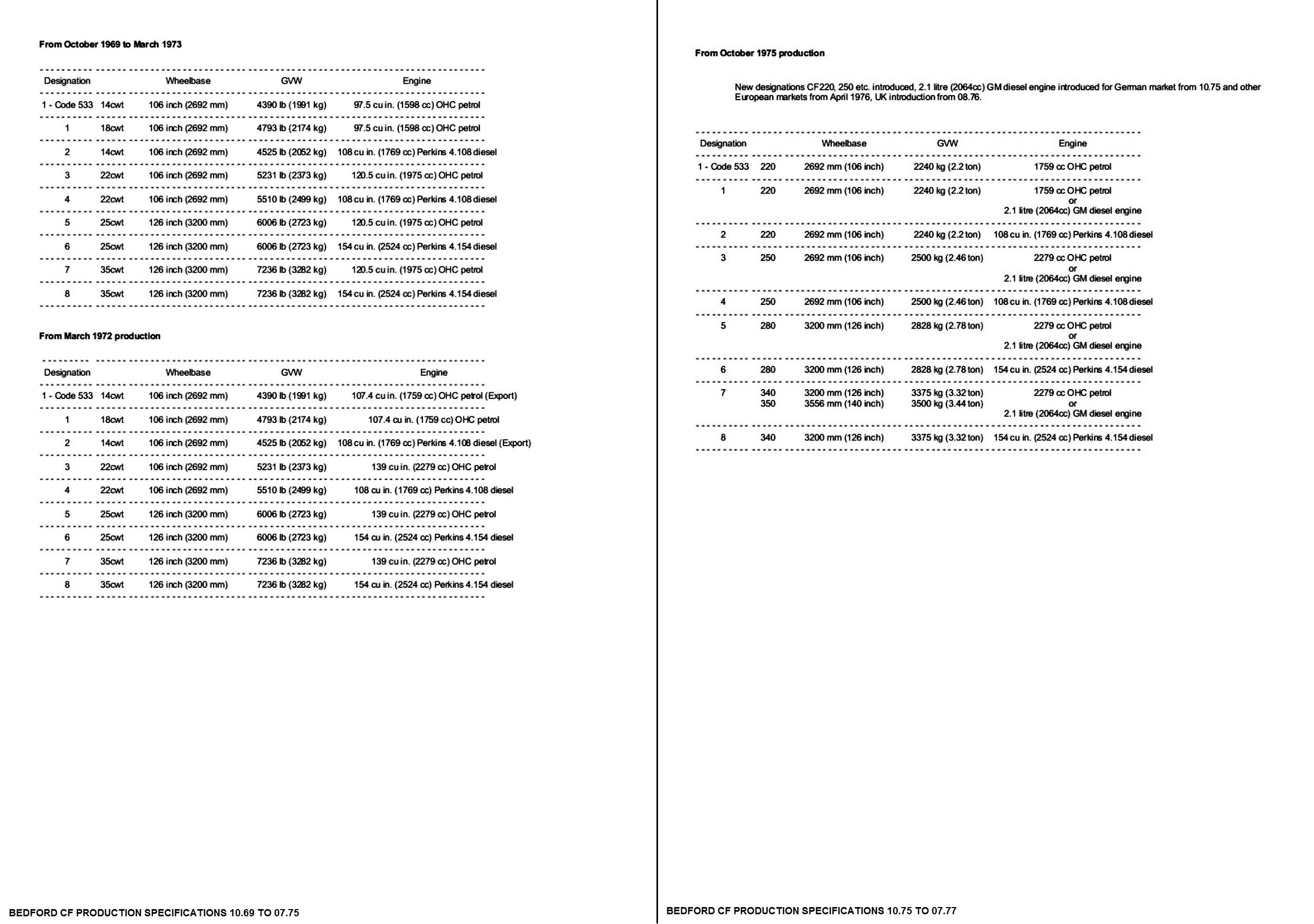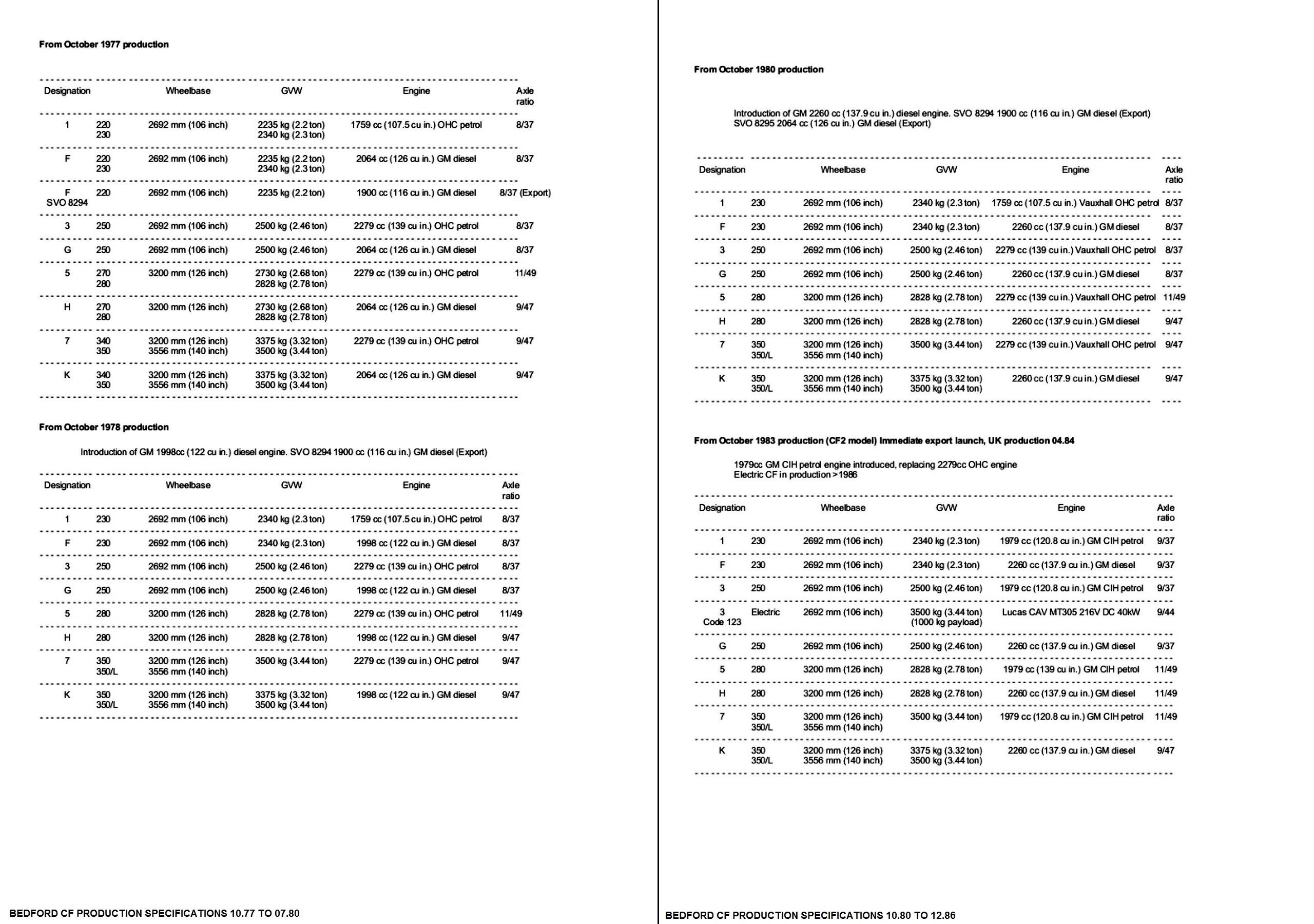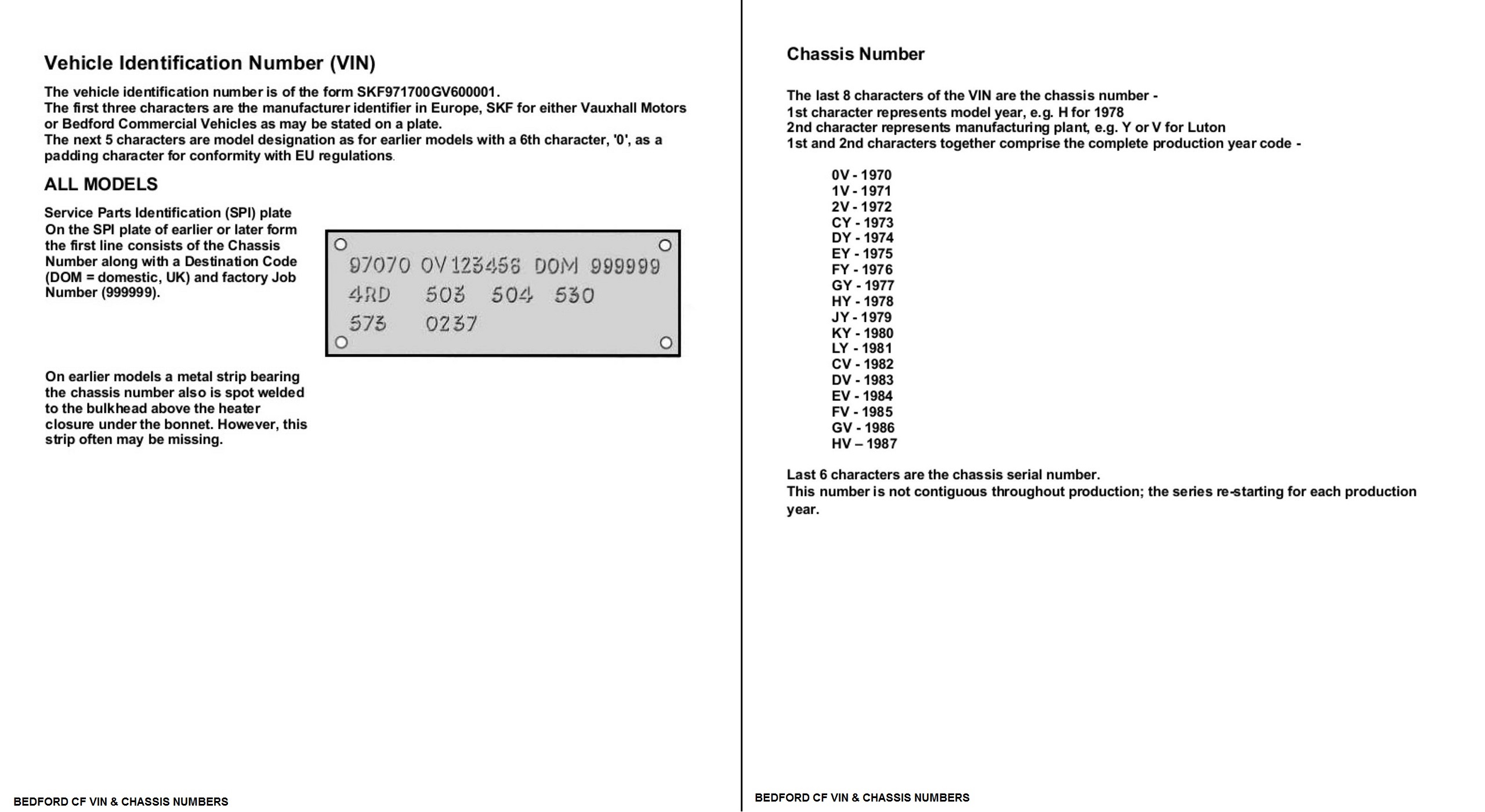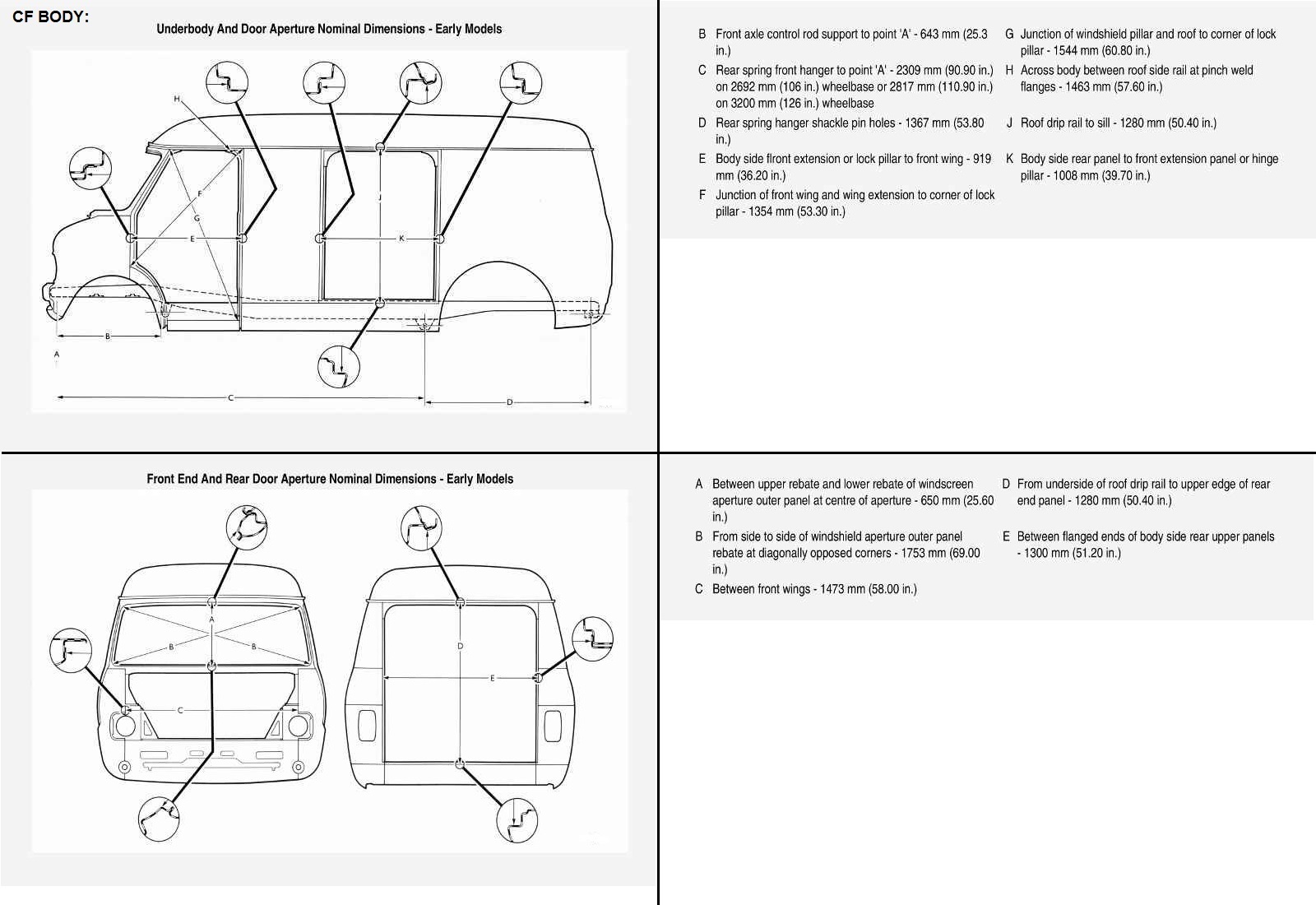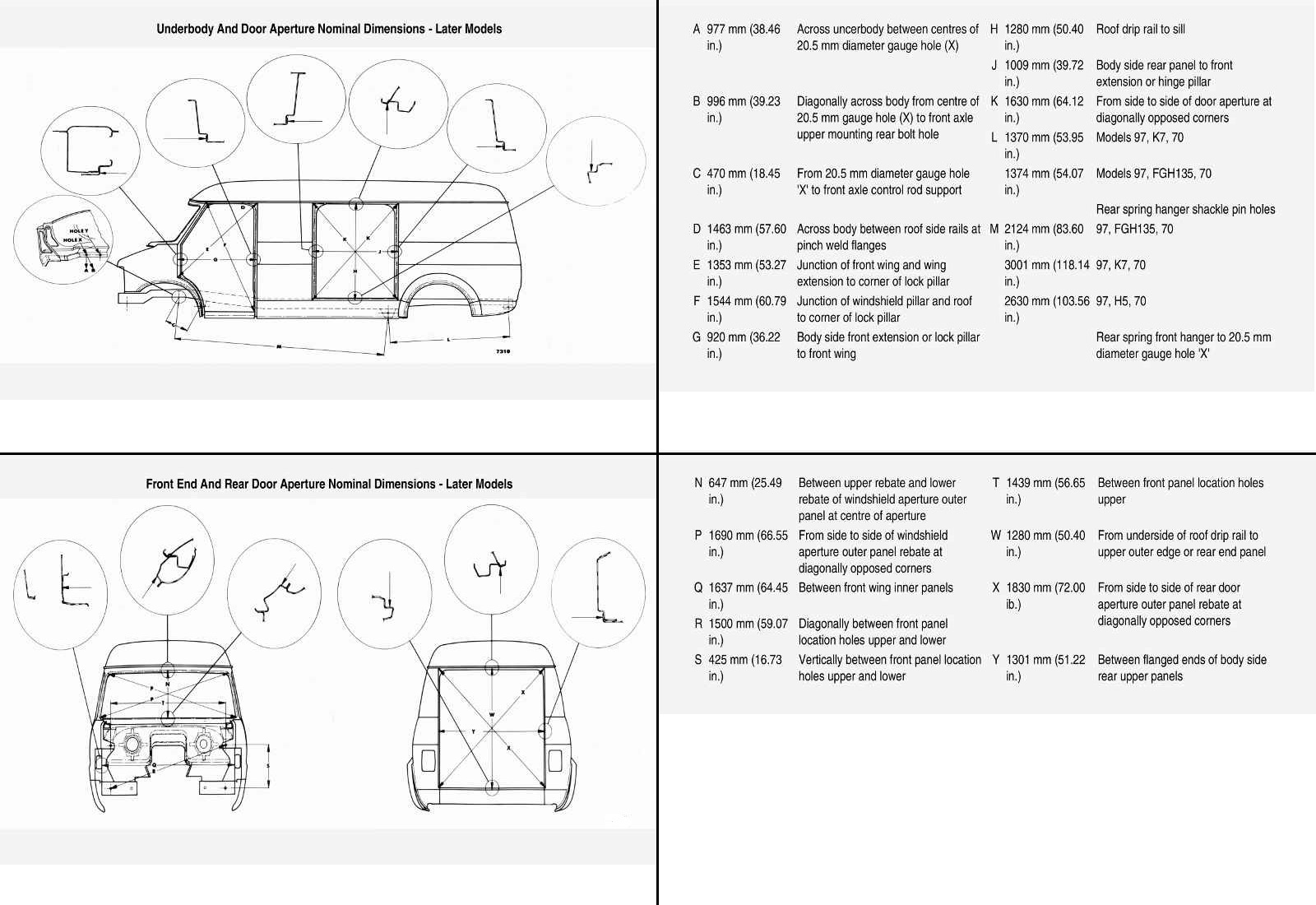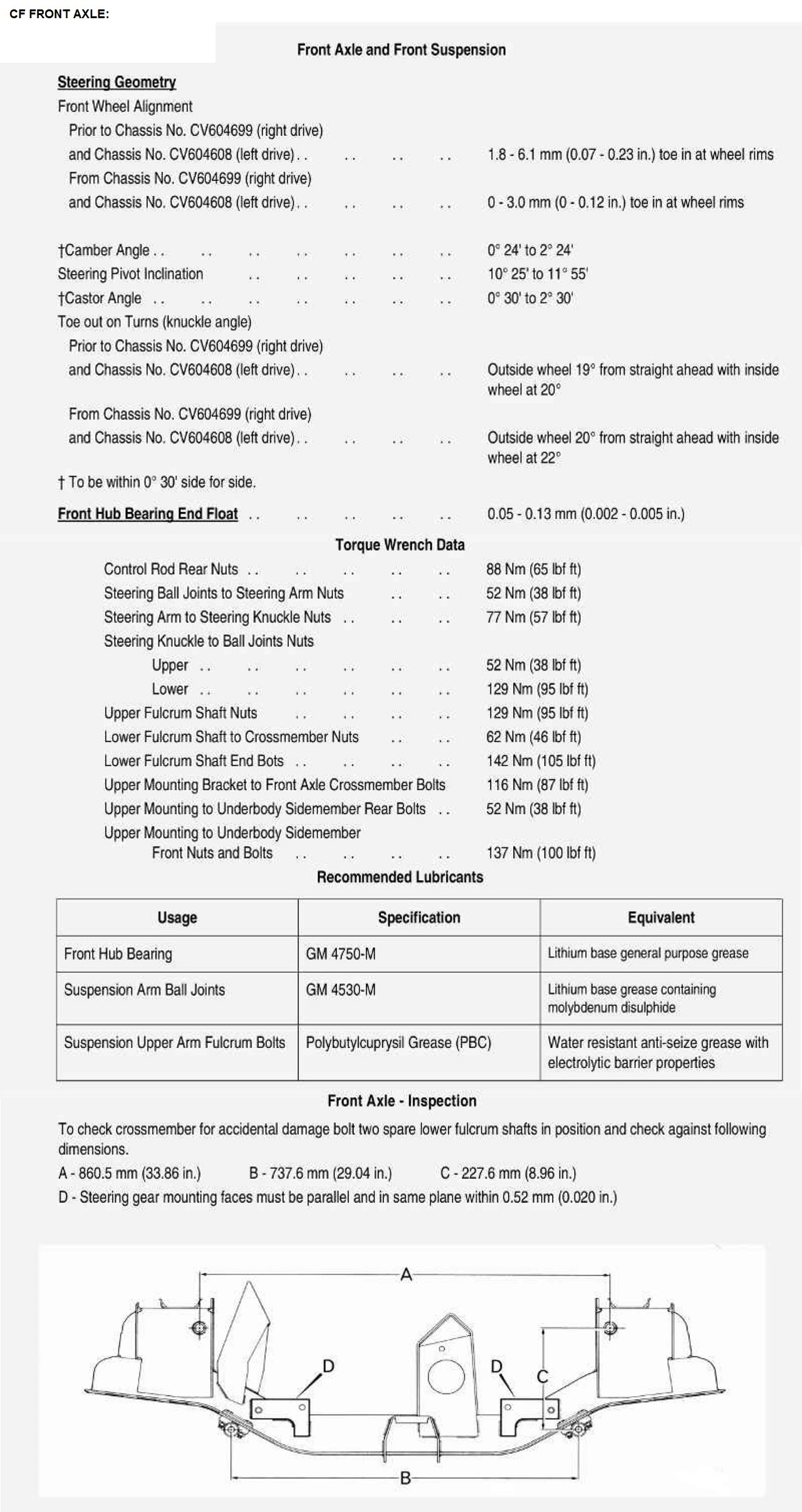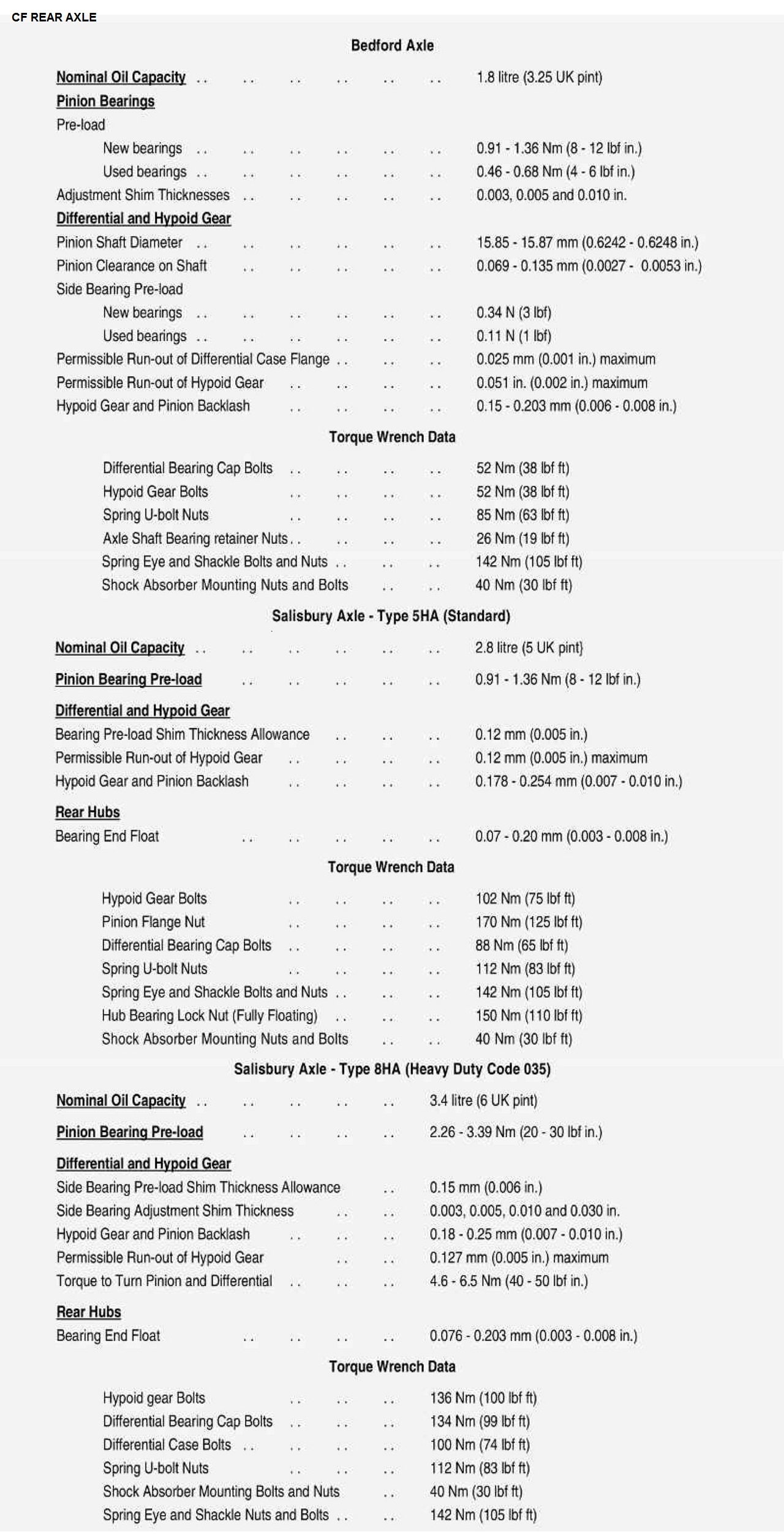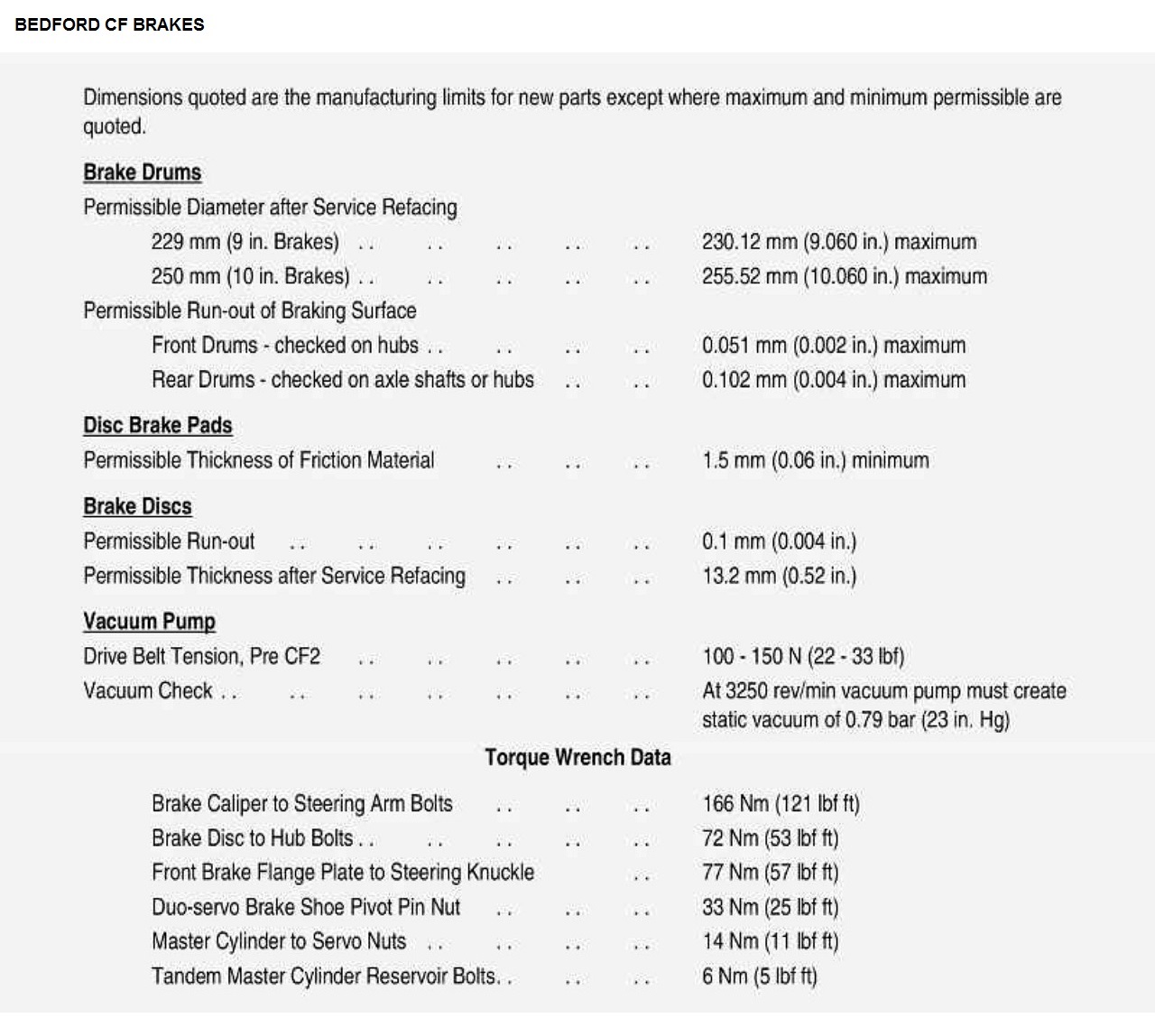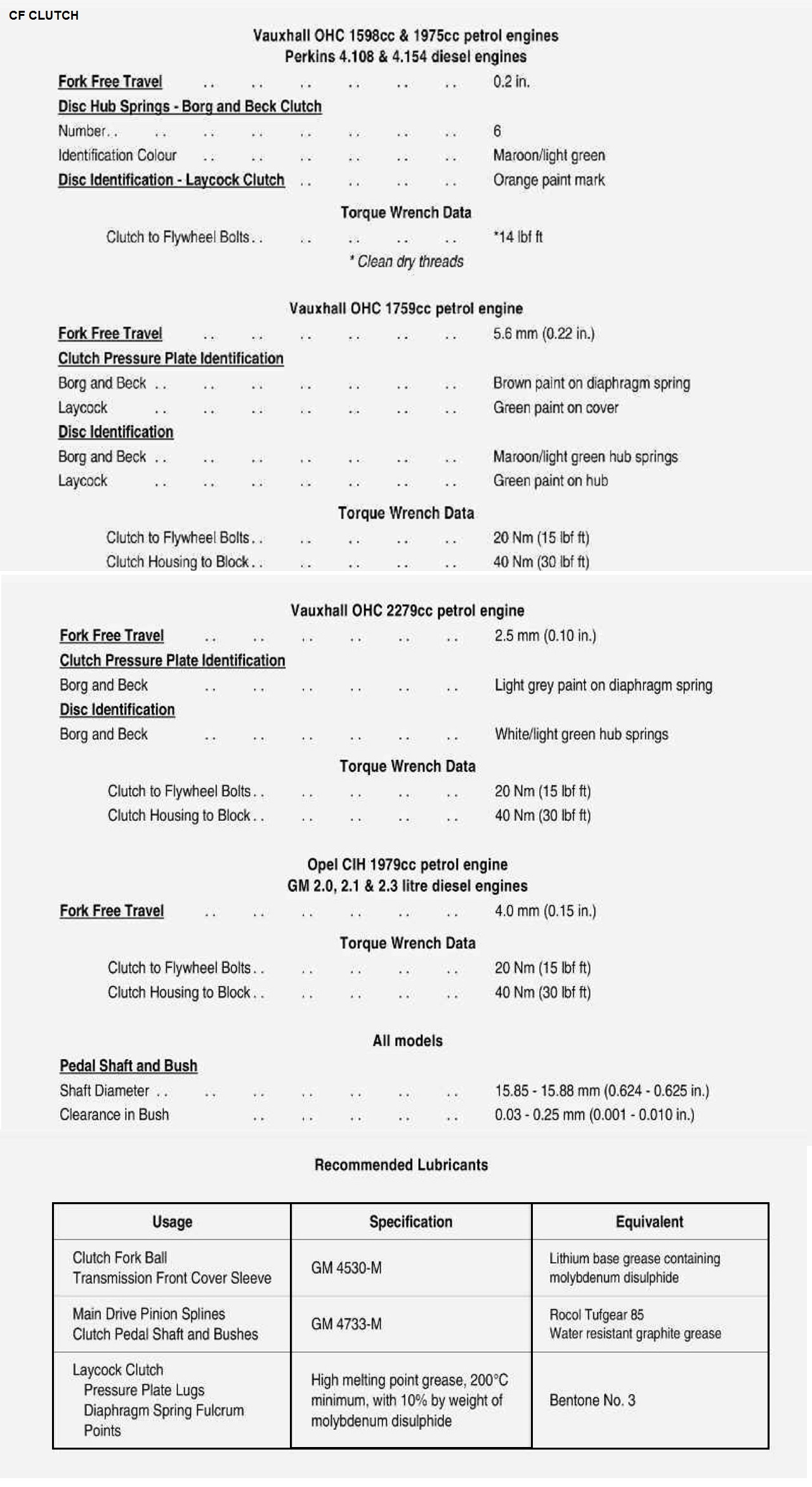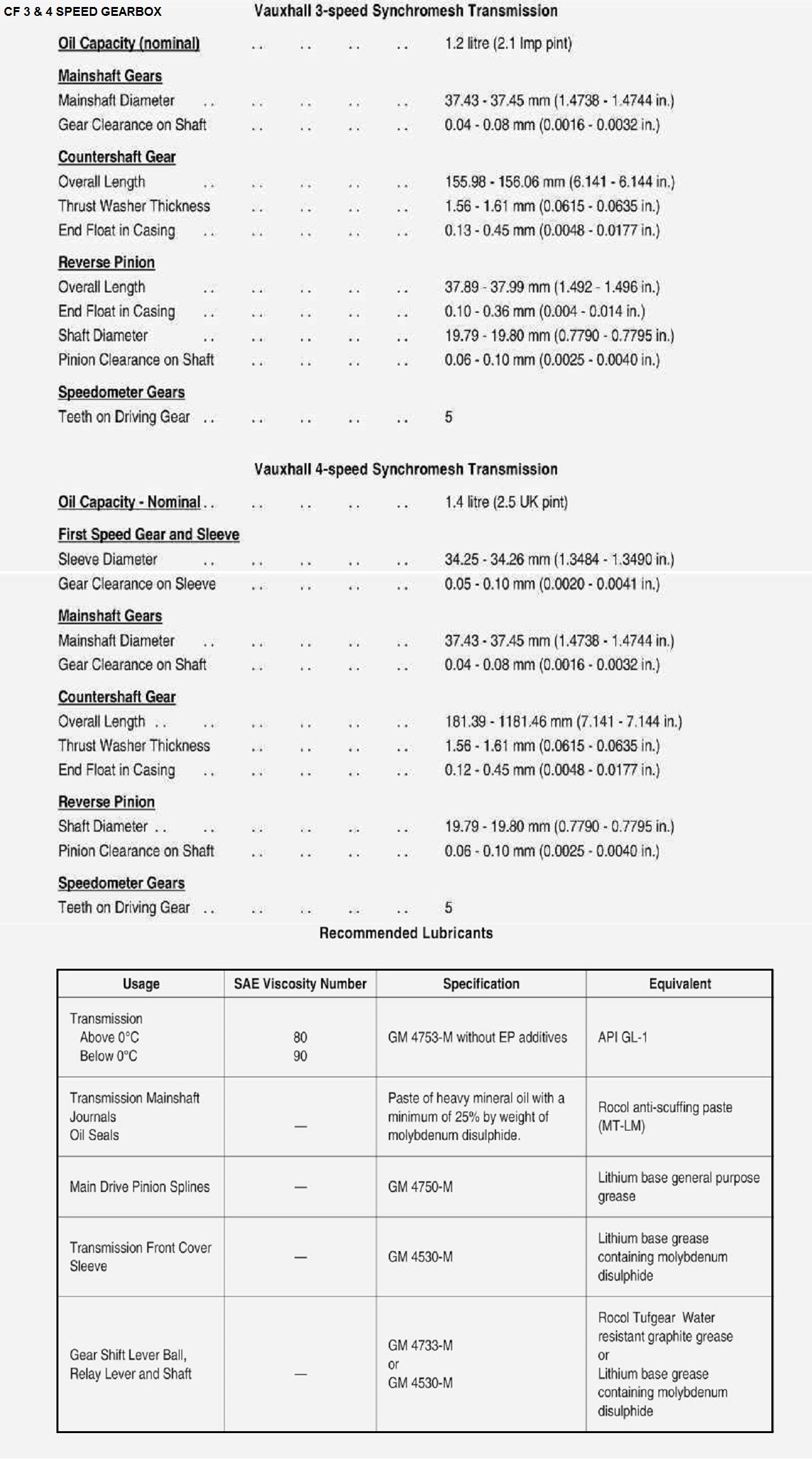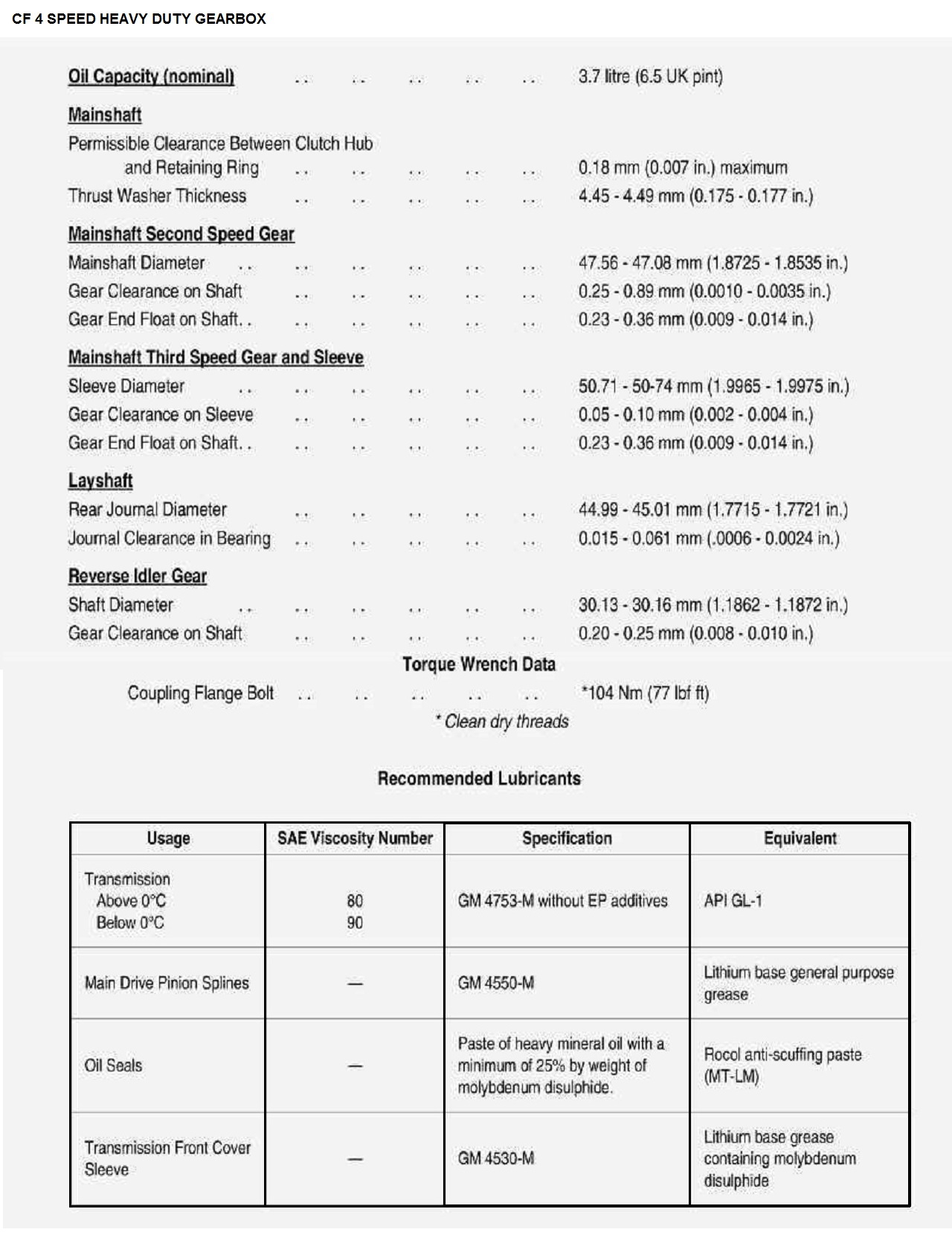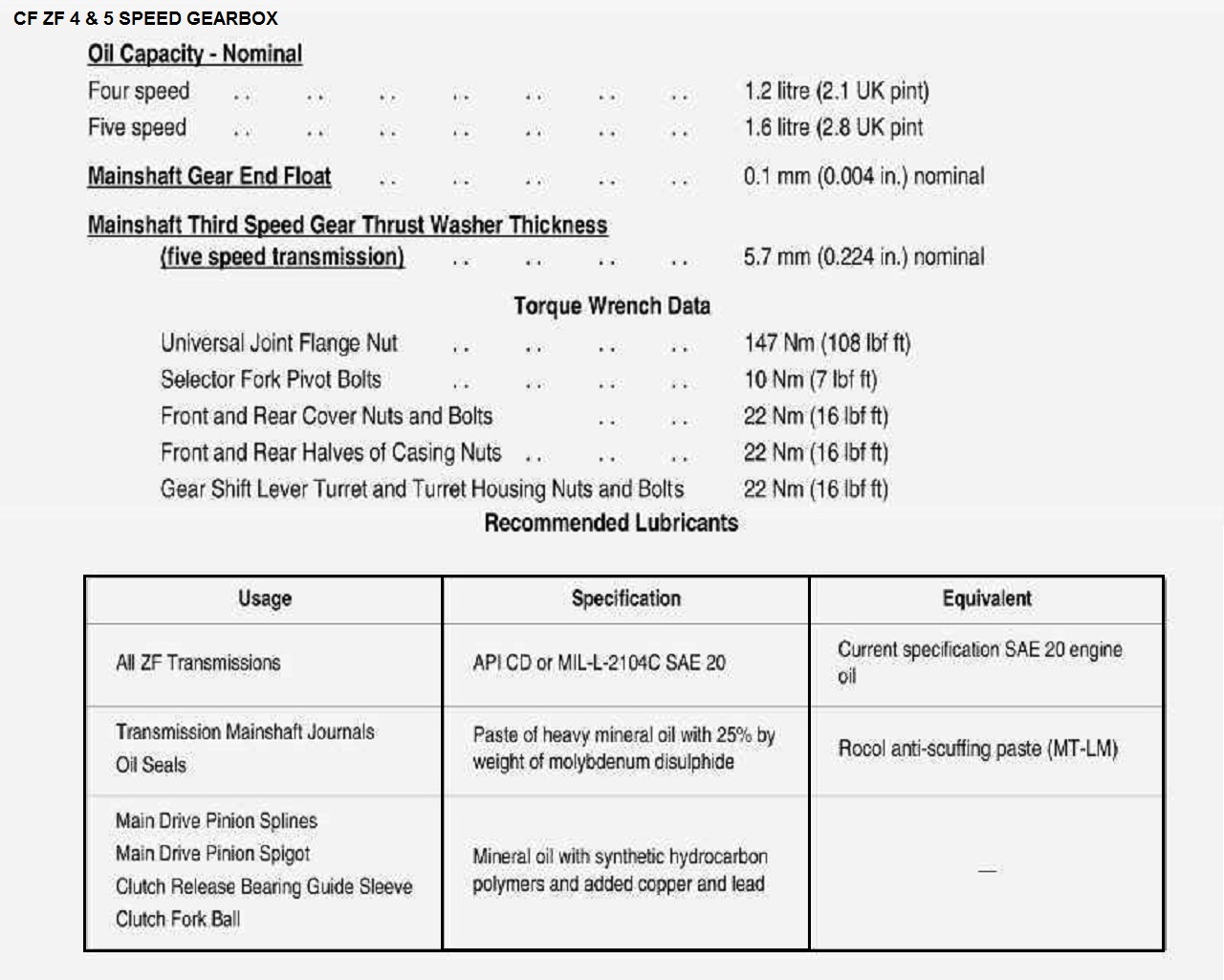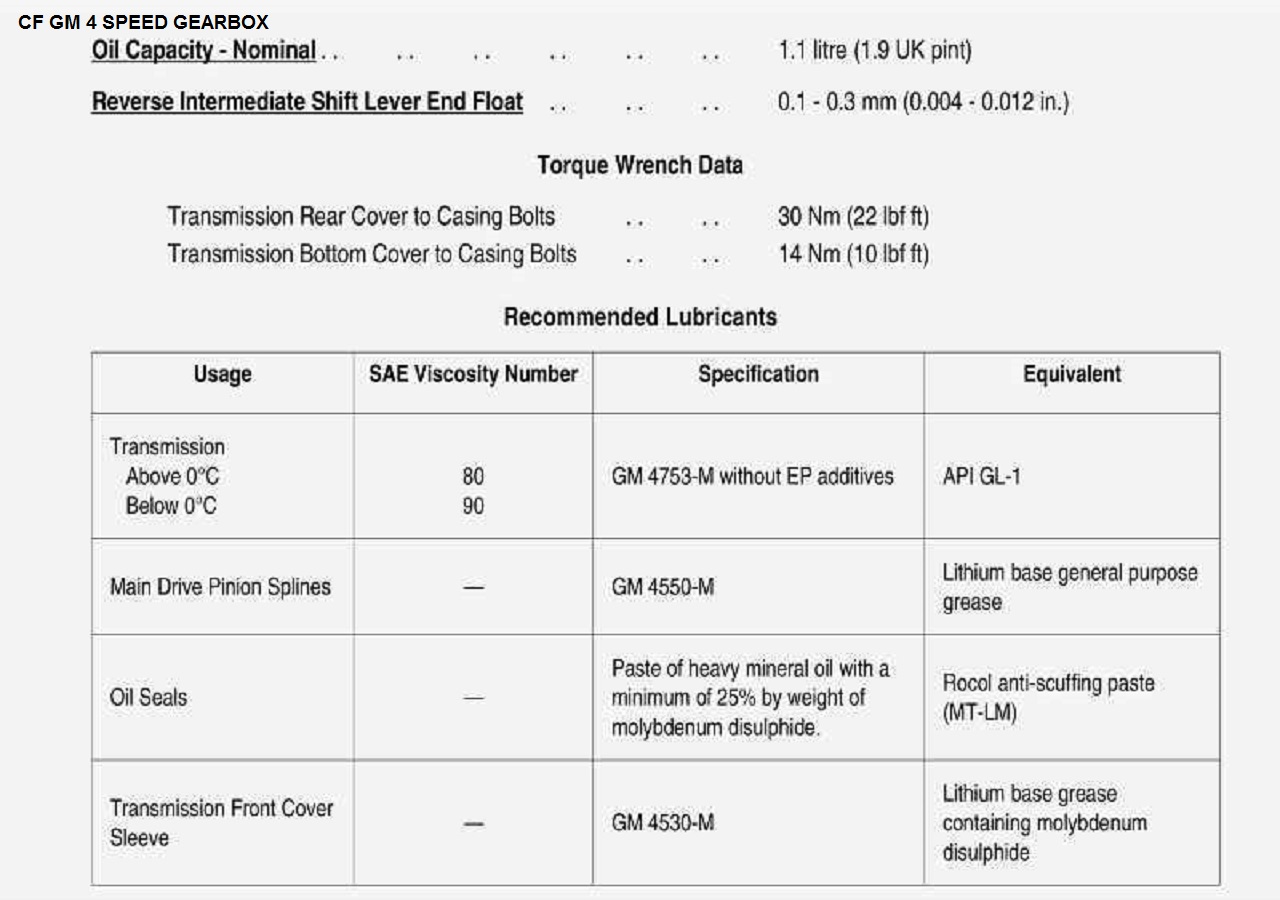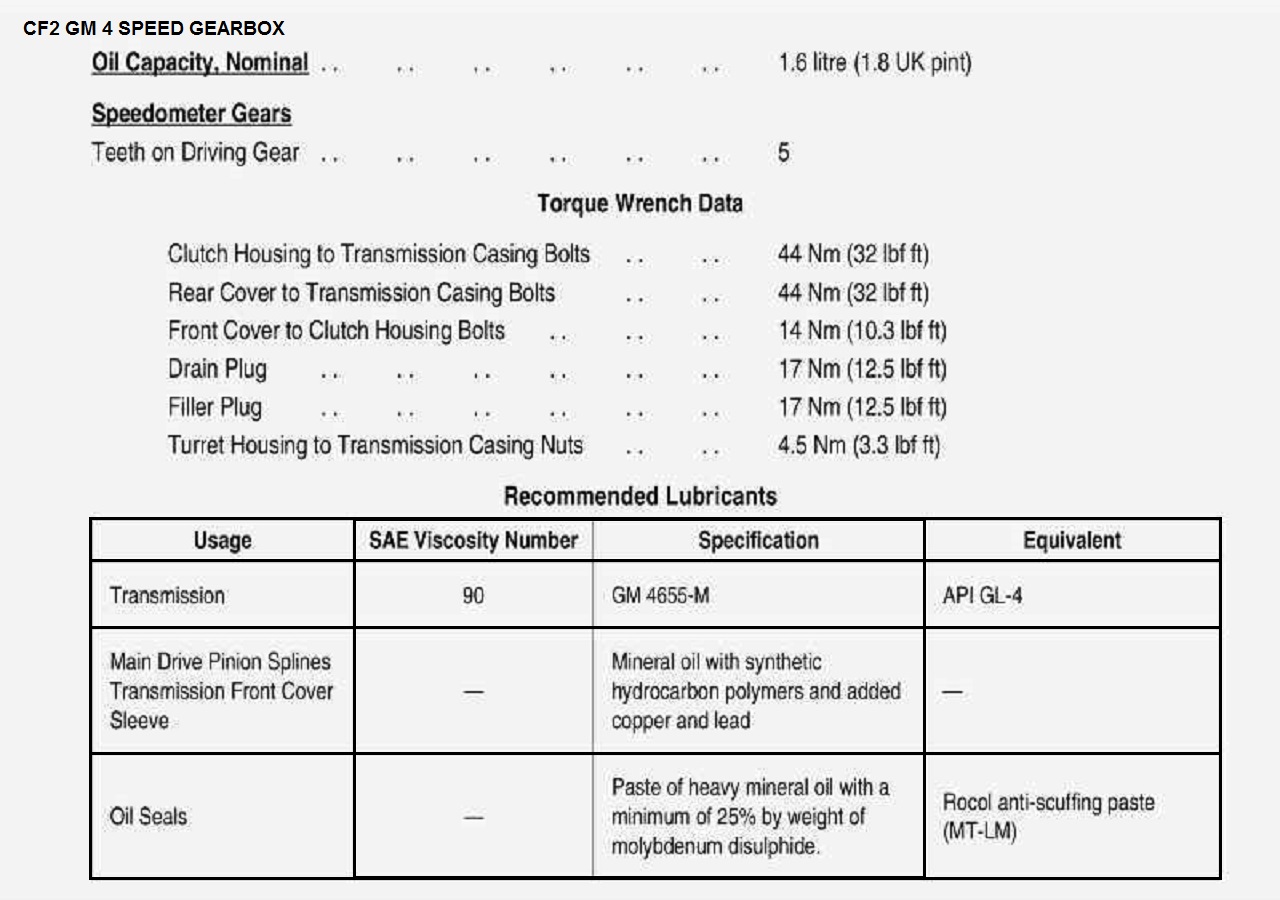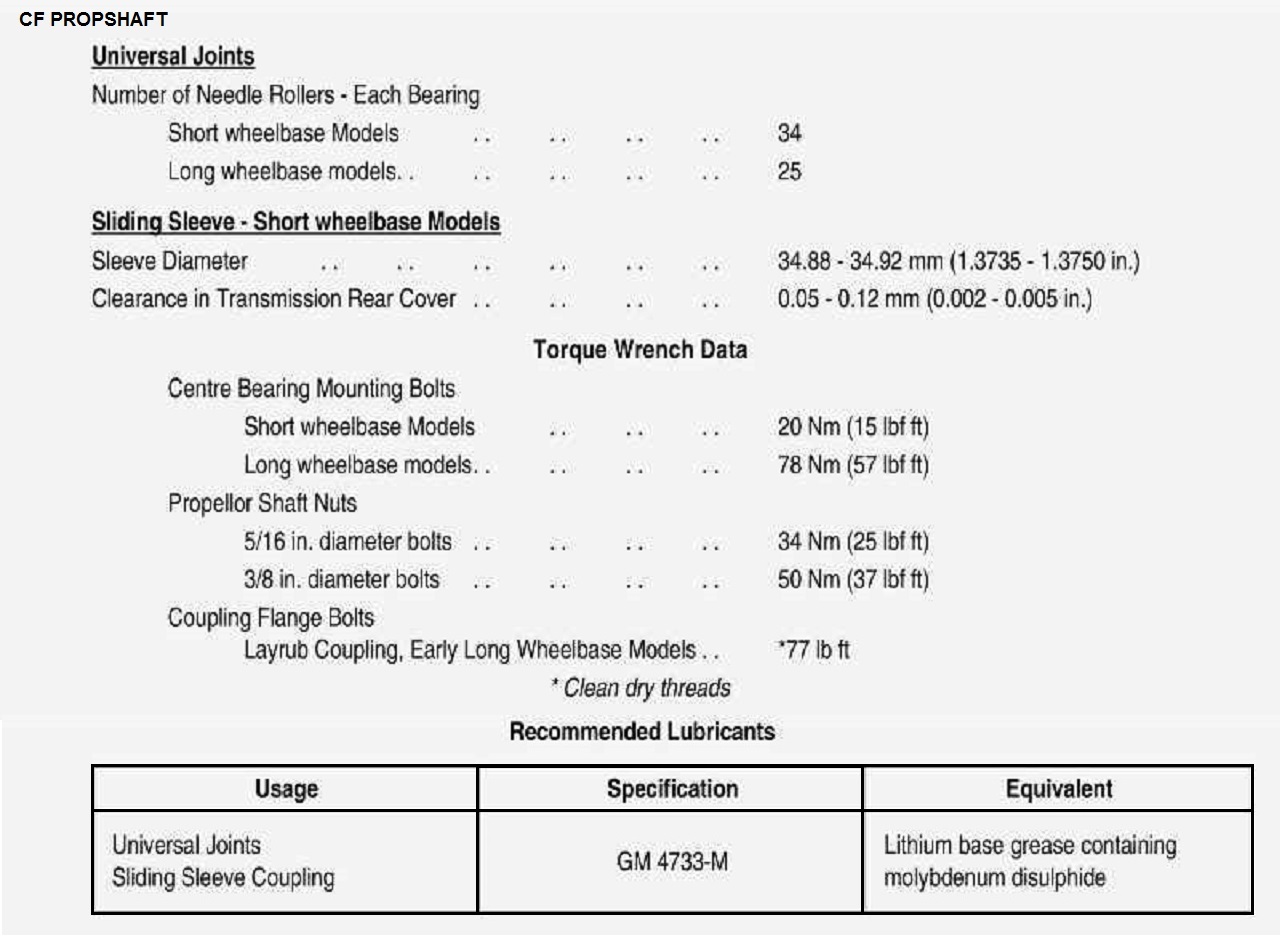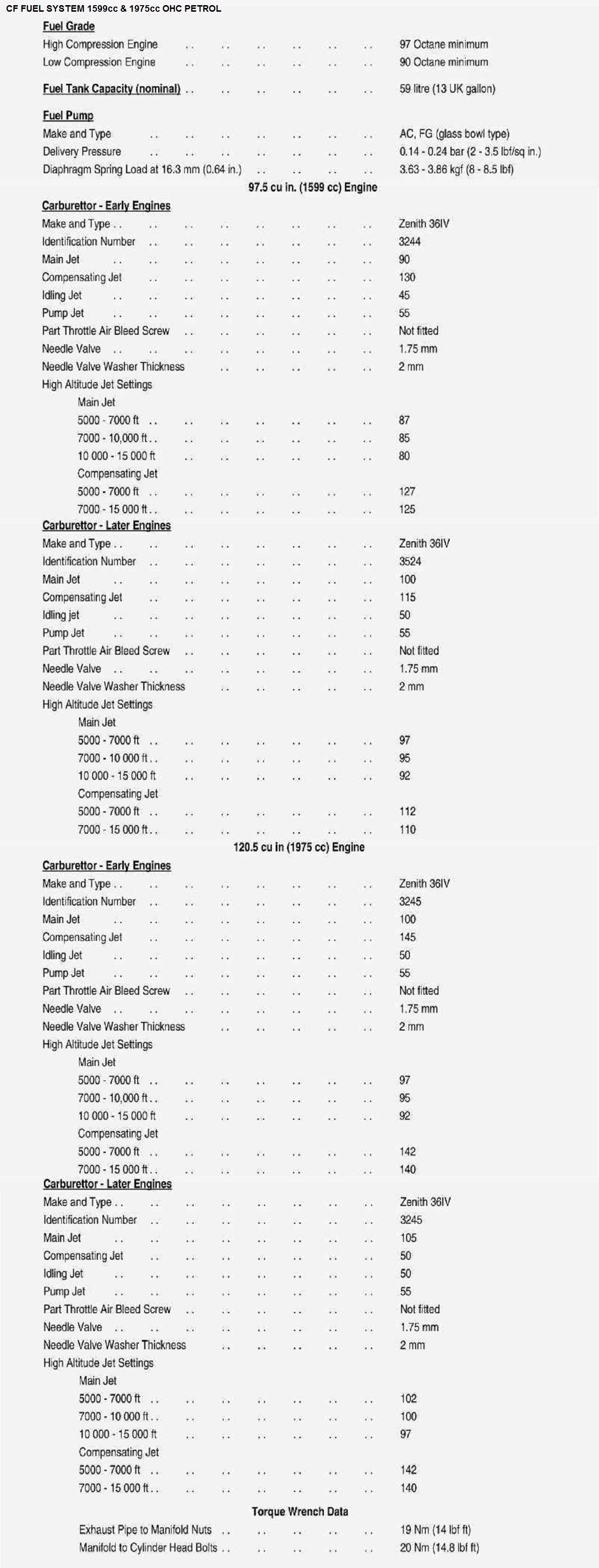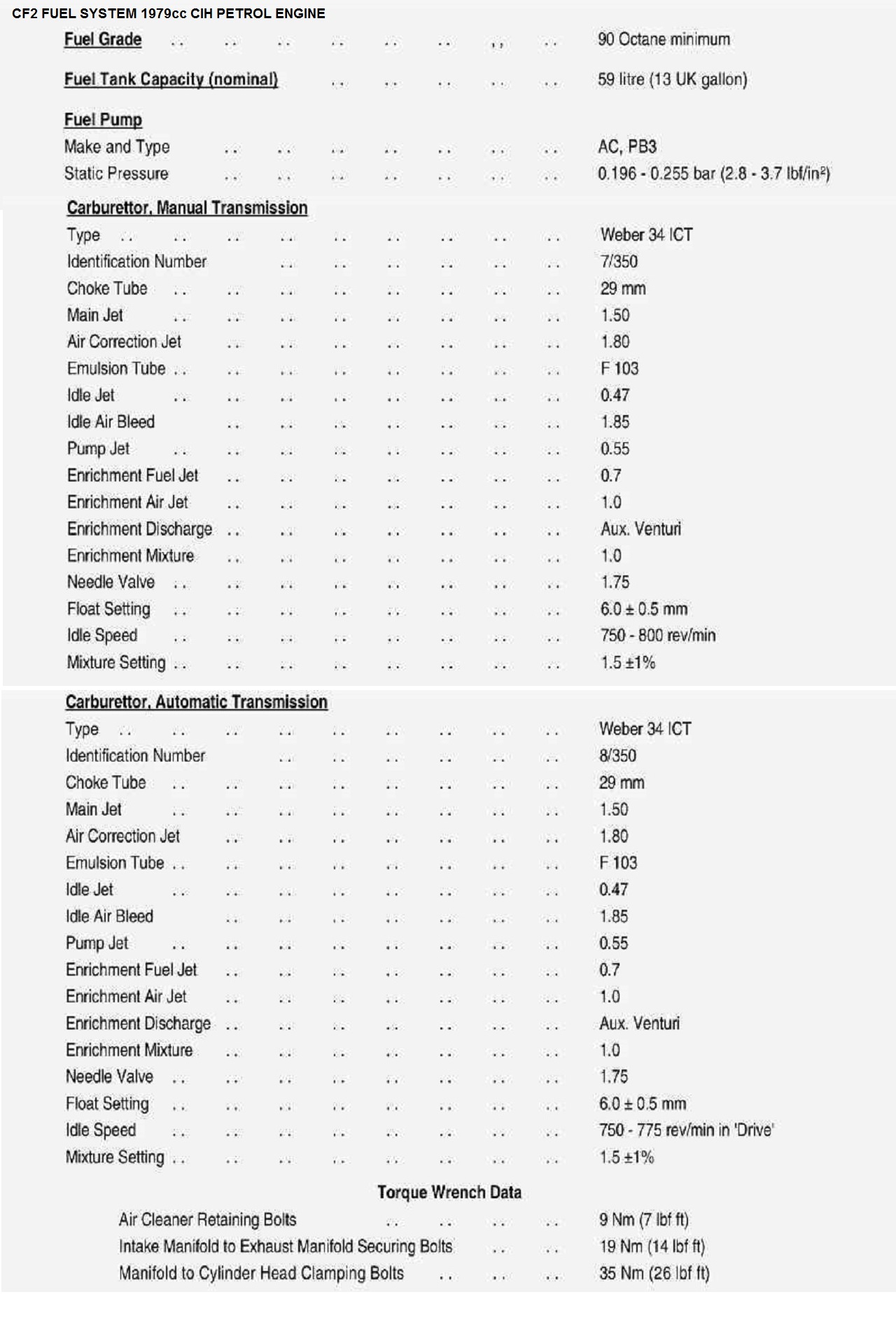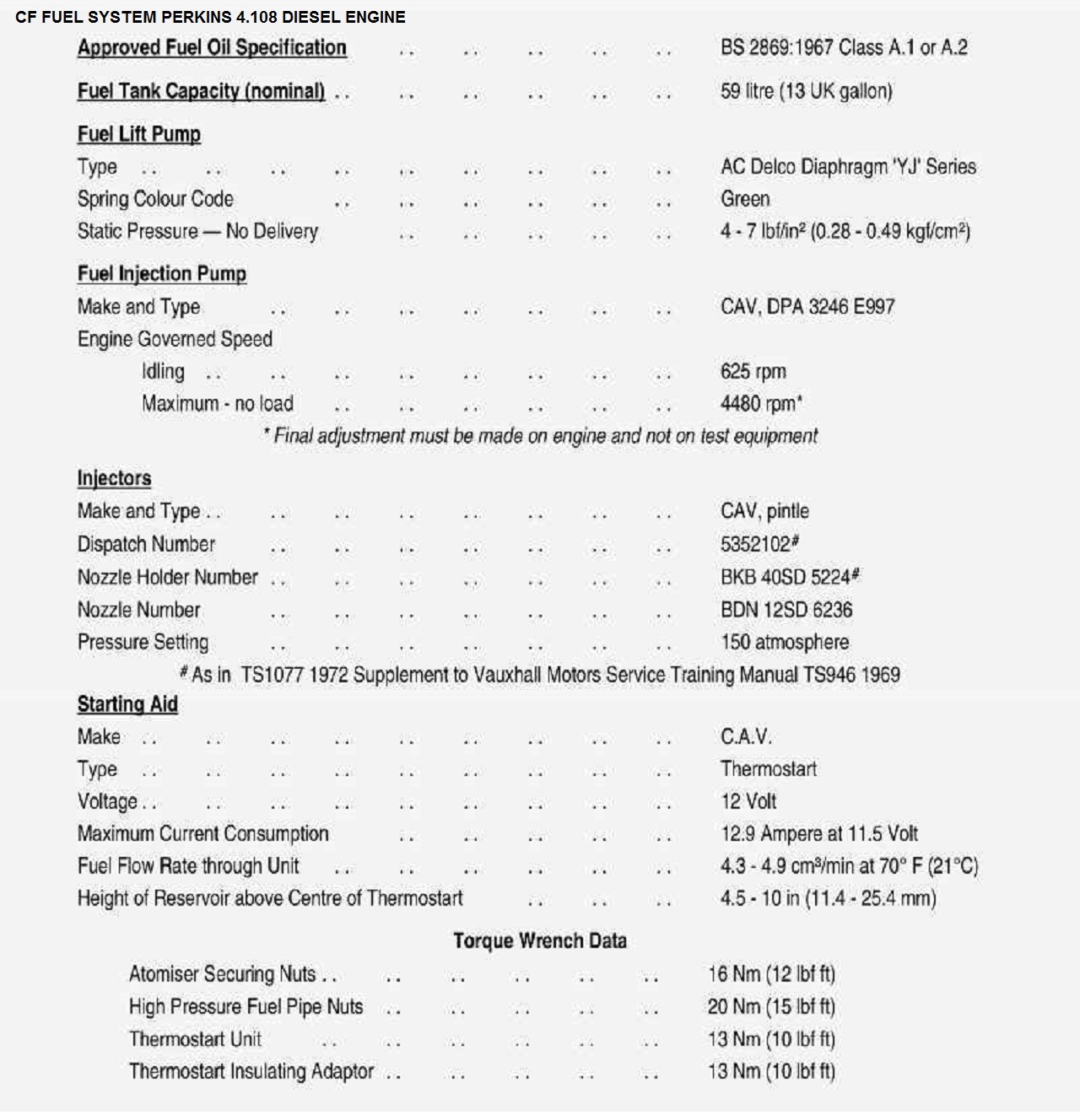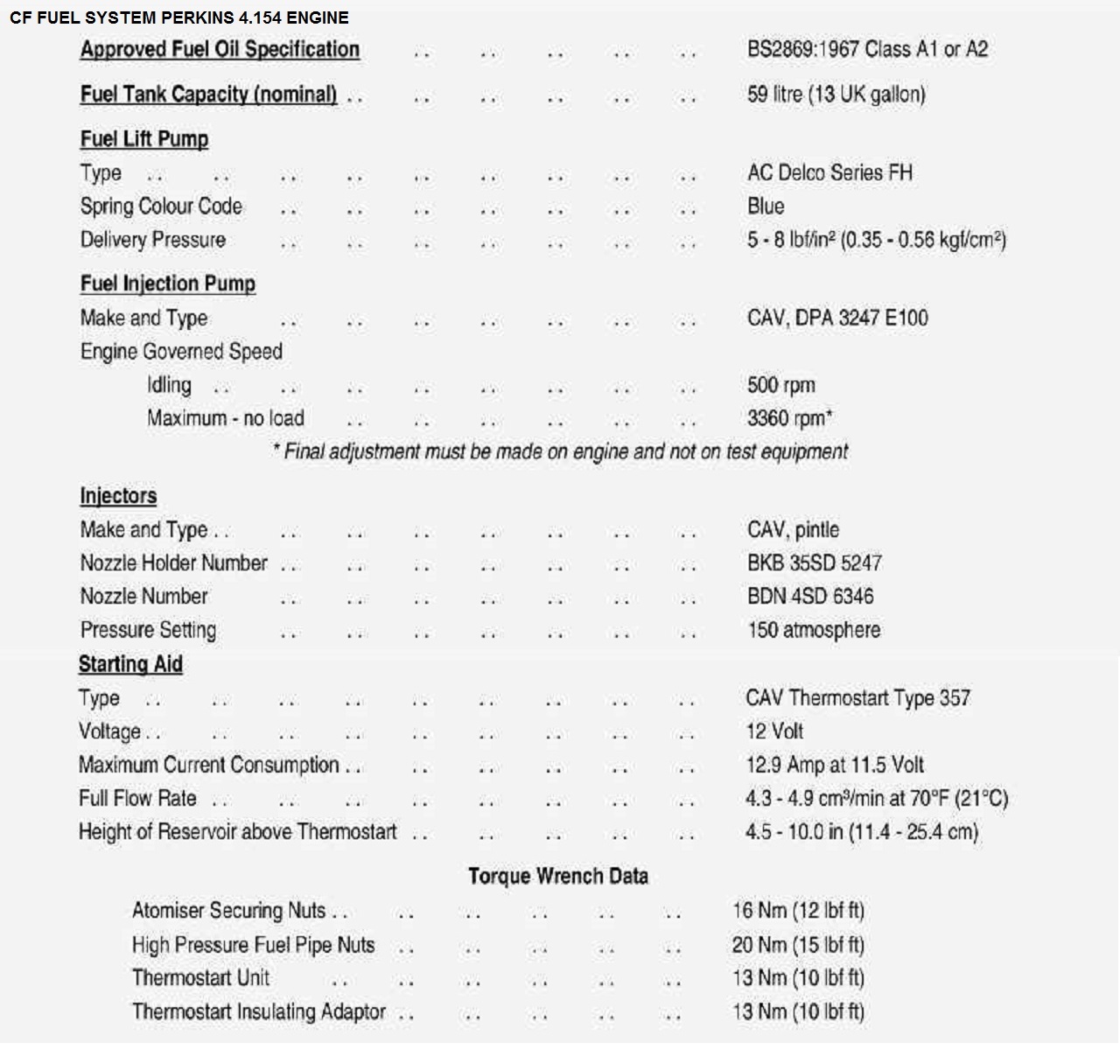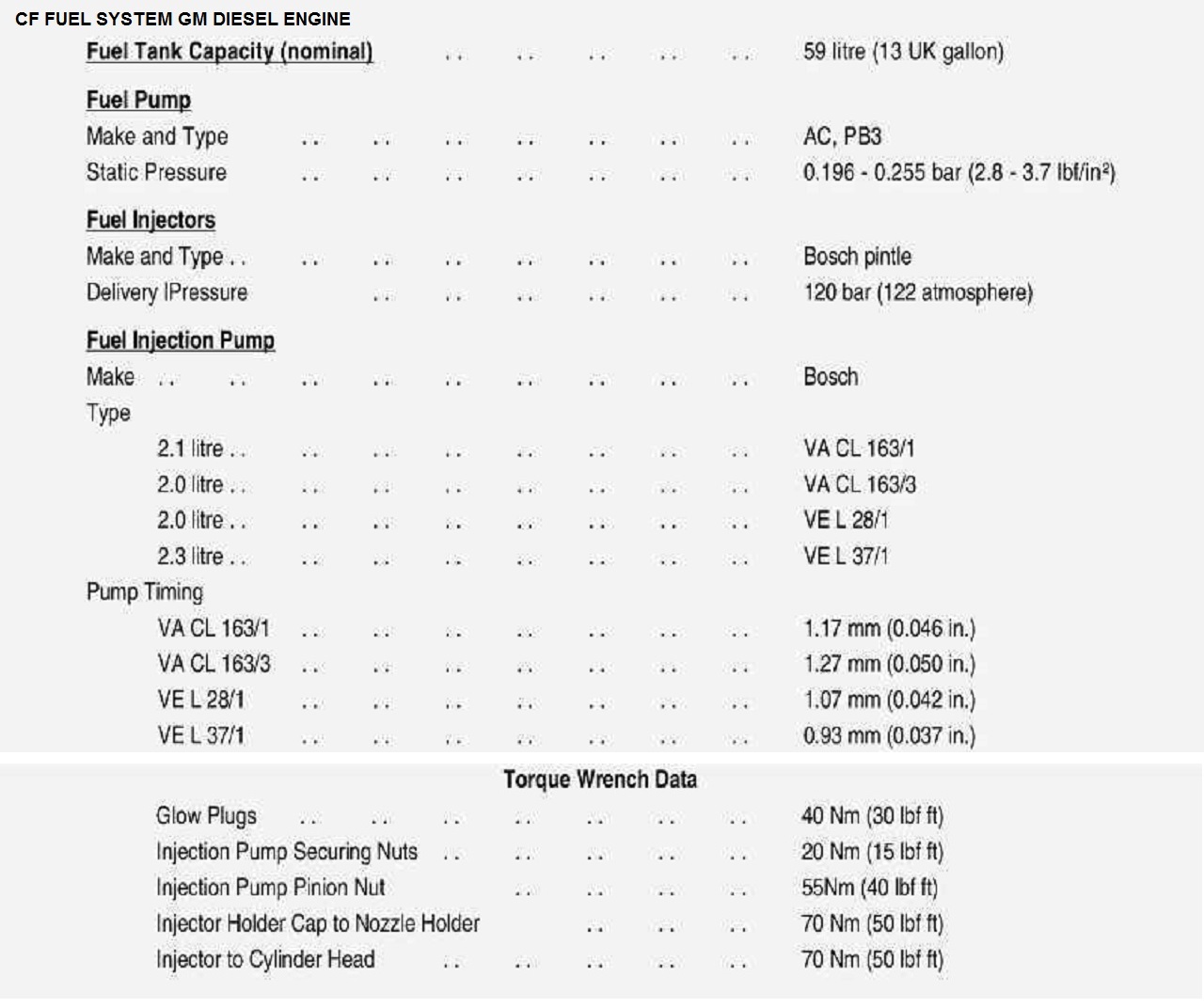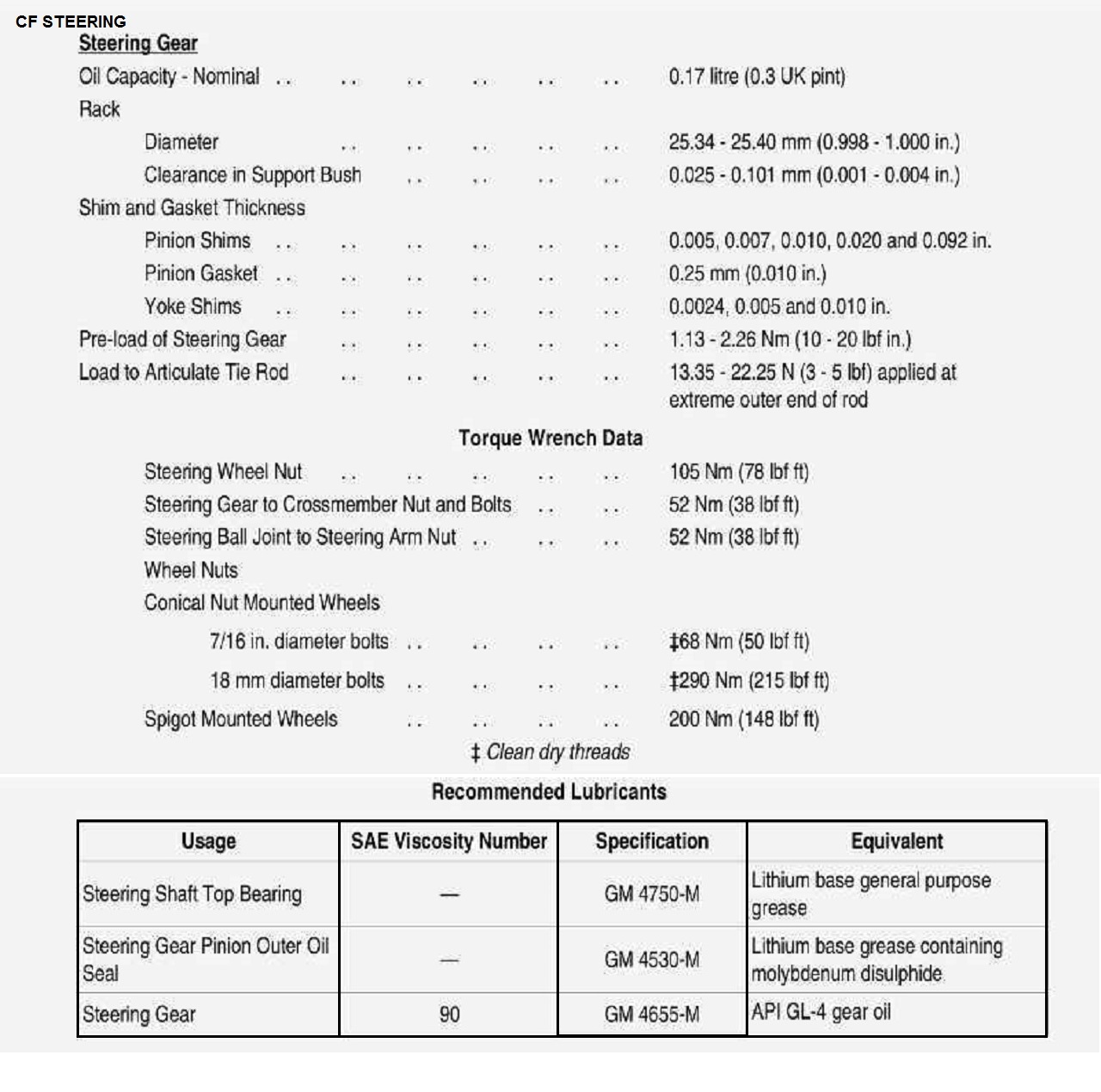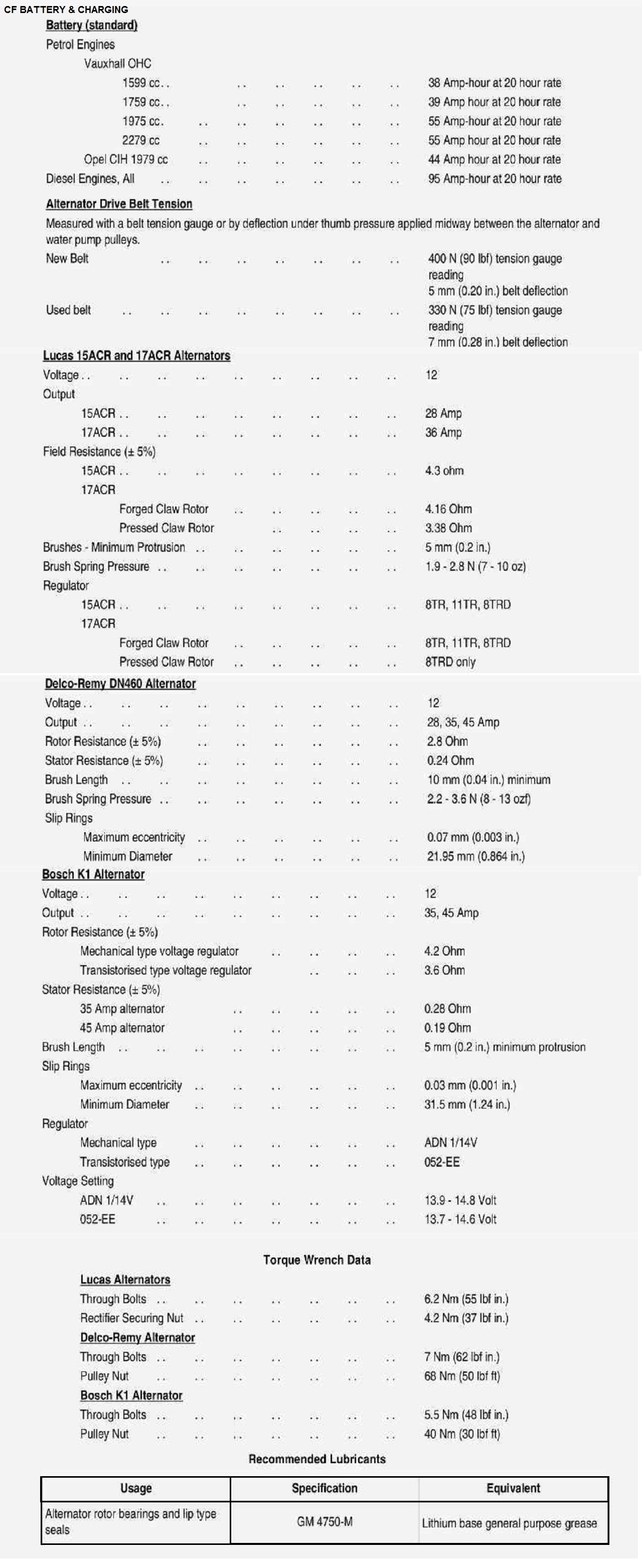
WITH THANKS TO JOHN K AT GENERAL MOTORS ARCHIVE FOR THE CONTRIBUTION TO THIS SECTION OF vauxpedia
WARNING: THOSE PICTURES MARKED "© GM ARCHIVE" CANNOT BE DOWNLOADED AND USED OR PUBLISHED ELSEWHERE

1. BEDFORD 97000 - CF BACKGROUND:
The “pug nose” Bedford CA had proven to be a remarkable success for Vauxhall, during most of its 17year production run it was the best-selling light van range in the UK and was also fairly successful in Europe & other world markets (in Canada it was also sold as an Envoy EA Van). This success was largely due to being available in a variety of weights (10, 12 & 15cwt), short & long wheelbases, slam or sliding door combinations, well proven Vauxhall OHV petrol or Perkins diesel engines which were simple & durable and the fact that it was economical to buy & run as well as being backed by a large dealer network, especially in the UK. At launch in 1952 its semi forward control layout was both advanced and unusual as was the independent front coil suspension. The popularity was also a result of some pretty crap competition from Ford, Rootes & BMC in the UK but this success was also a bit of a curse in that it gave Vauxhall little incentive to make any major changes or improvements to the CA, there were some such as the introduction of all synchromesh gears in 1957, a single piece curved front windscreen and revised grille in October 1958, a 102 ins long wheelbase version was added in 1959. The bigger petrol engines (1594cc), 4 speed gearbox option & chrome front grille in 1964 were amongst the biggest changes. The CA Van was never originally intended to be in production for so long, a fully forward control replacement, the CB Van, was planned for launch in the early 1960s and prototypes were produced but it never made it to production. The CB in any event was essentially a re-bodied version of the CA, the CB project is covered in detail in a separate section of vauxpedia. Unfortunately, the cosy light van bubble that Vauxhall was living in finally burst wide open in October 1965 with the launch of the Ford Transit Mk1, Vauxhall had assumed that Ford would launch an updated facelifted version of the Thames van, they didn’t – far from it. Vauxhall was caught out and faced a very rude awakening as CA sales nosedived in the last 4 years of its production run as the Ford Transit became the top seller and the standard to match in the LCV market, it offered a comprehensive range which eclipsed the CA Van range in almost all respects. With near panic Vauxhall began working on a direct competitor to not only match, but beat, the Transit in most critical areas of comparison, any link with the CA would be well and truly consigned to history. Here is the story
2. BEDFORD 97000 - CF DESIGN & ENGINEERING:
The new van programme did not just focus on matching or bettering the Ford Transit dimensionally but also evaluated some radical and, for a commercial van, highly advanced engineering; normal control, like the Transit, semi forward control and fully forward control all with rear or even front wheel drive. Bedford needed the new van to cover most of both the CA and TJ ranges, however, their needs were not alone. In Europe Opel had launched the Opel Blitz B in 1965 which had proved an underwhelming seller largely because no diesel engine was available, Opel had been the number one seller of commercial vans in Germany in the early 1960s but had been on a downward spiral ever since and so the planned Bedford replacement was to be the basis for a new Blitz van for which Opel would design their own body. As if this wasn’t enough, in the USA Chevrolet had launched the unusual rear engine “CorVan” in 1961 based around the Chevrolet Corvair car mechanicals (not a wise choice) but by 1965 had launched the much larger G Series Van and phased out the CorVan in 1966 which had left a gap for a smaller van to sit below the G Series so in the very early design stages a Chevrolet version of the new Bedford were included in the programme.

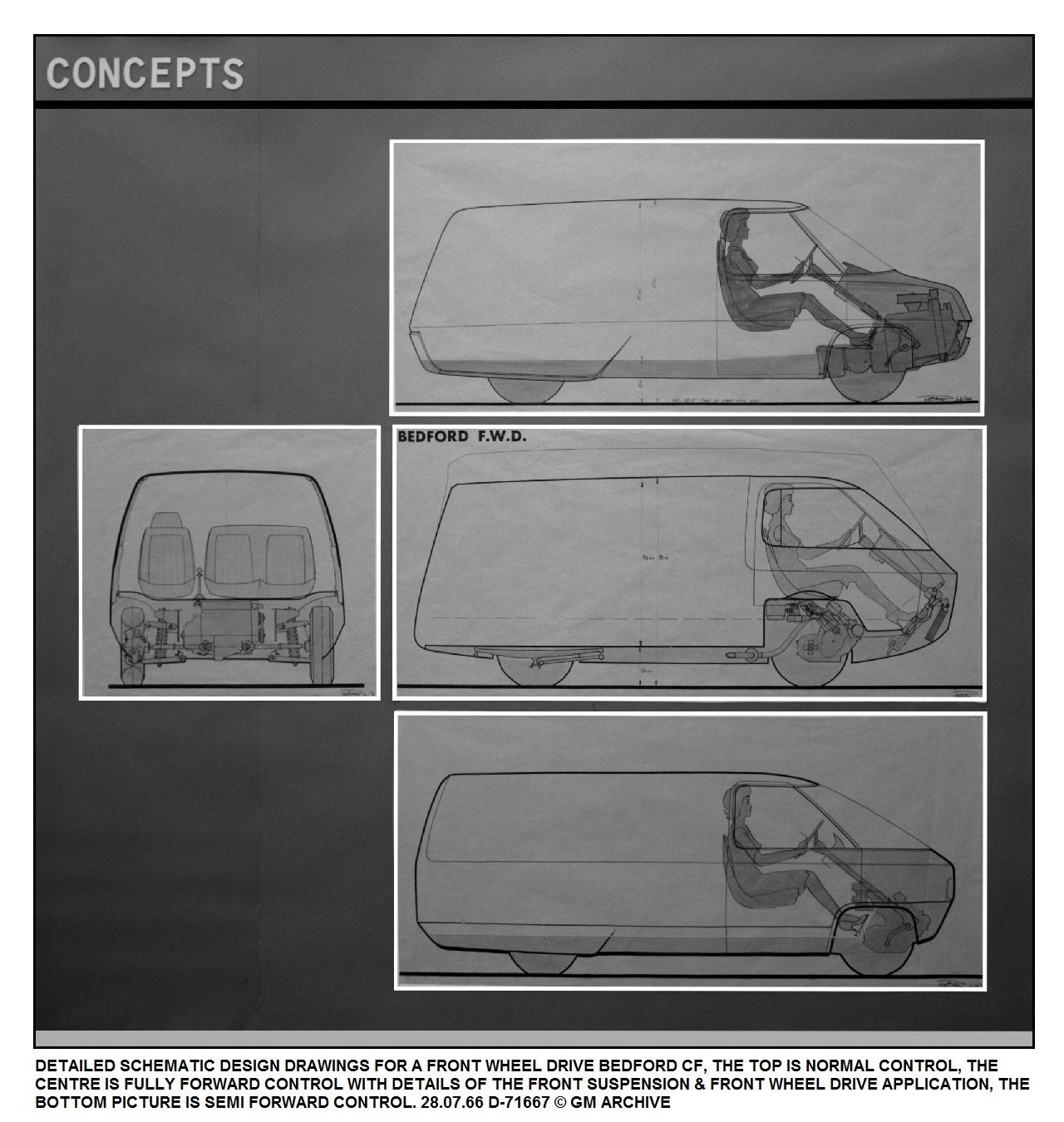
Design work began on the new CF programme began in earnest in July 1966 and were subject to a design review in September 1966 with a target introduction date of Autumn 1969. Chevrolet were still included at this stage and Opel were also planning their own design based on the Bedford chassis to be introduced a year after the CF launch. By the end of 1966 and early in 1967 Chevrolet dropped out of the programme and a separate Opel designed model was rejected by the GM Board because the sales volume did not justify the investment, instead Opel would continue to limp on with their Blitz B until the 1973 model year when it was planned to be replaced with an Opel badged version of the Bedford CF Van.
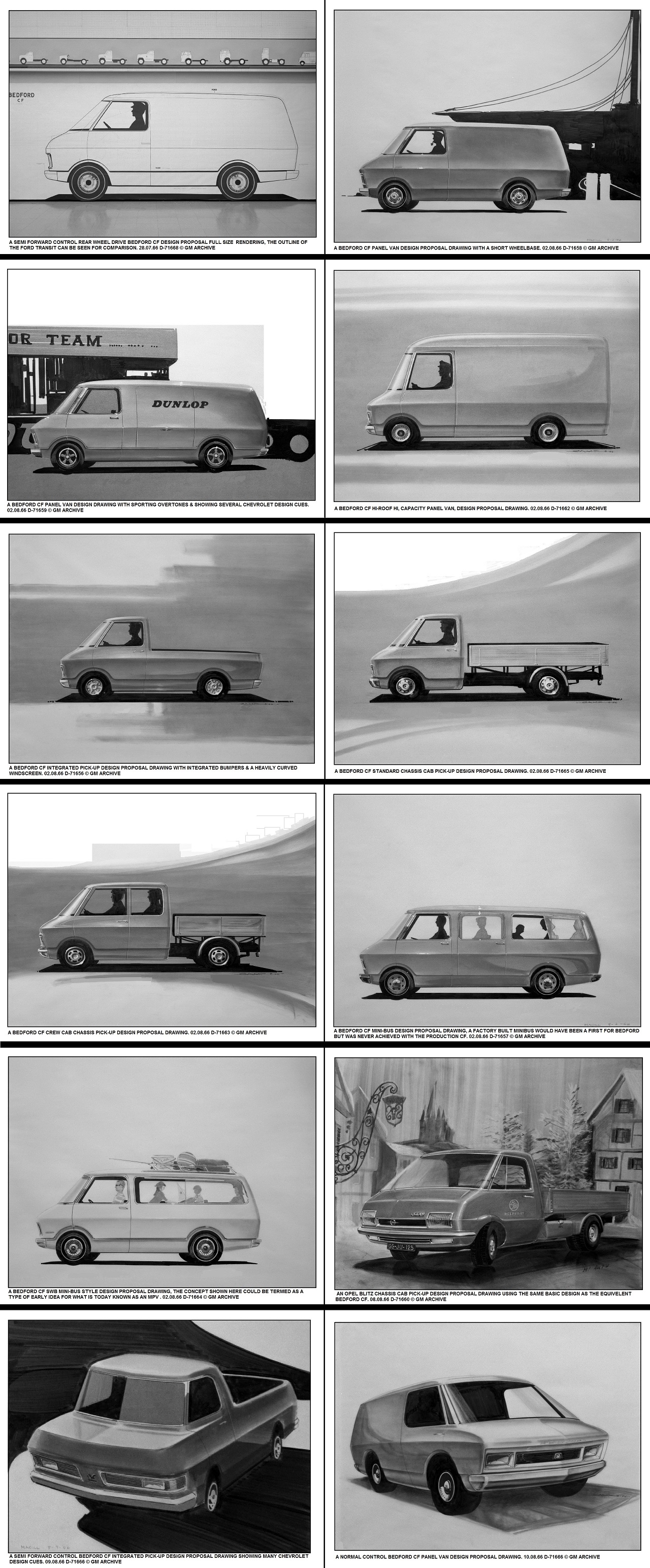
The final design parameters were set early in 1967, the CF
would be a rear wheel drive, semi forward control van that was
longer, even in SWB form, and considerably wider than the previous
CA and crucially its critical load dimensions were better than
those of the Ford Transit. The proposed CFT truck variation to
replace the TJ Series didn’t get any further than a design scale
model. Both Leo Pruneau and Wayne Cherry worked on the design under
the guidance of David Jones and it showed, when the Bedford CF was
launched it had something that neither the Transit nor any of its
major competitors had - style - and bags of it too. There were some
corporate GM design cues, particularly Chevrolet, but for once they
were all positive. Mechanically the CF used very few carry over
components from the CA, the 3 & 4 speed gearbox being the main
one. The engine choice went up from 2 to 4 and included the new
1599cc & 1975cc slant 4 OHC engine that was fitted to the
Vauxhall Victor along with a choice of two Perkins diesel units,
the smaller version was the 1760cc engine previously offered in the
CA, the larger power unit was 2524cc. However, this diesel option
could have been very different because the development of the slant
4 OHC unit also included diesel versions - the full story is dealt
with in a separate section of vauxpedia. The fully independent
front suspension was also new and was a beefed up adaption of that
fitted to the Vauxhall Victor. Another unusual feature was the
fitment of rack & pinion steering. Two-wheelbase lengths were
offered – 106ins & 126ins – compared to 90ins & 102ins for
the CA, also the weight range was widened to run from 14cwt to
35cwt, the largest 35cwt used a modified TK back axle with twin
rear wheels for the first time on a Bedford light van. There has
been much discussion surrounding why the van was named CF and not
CE (there had been CB & CD projects), well the answer is
because of the number of components from the (F)D Victor it was
decided to jump straight to C(F). The CF underwent a huge testing
programme prior to production which included both Chaul End and the
GM Millford Proving Ground as well extensive on road cold and hot
weather testing of prototypes.
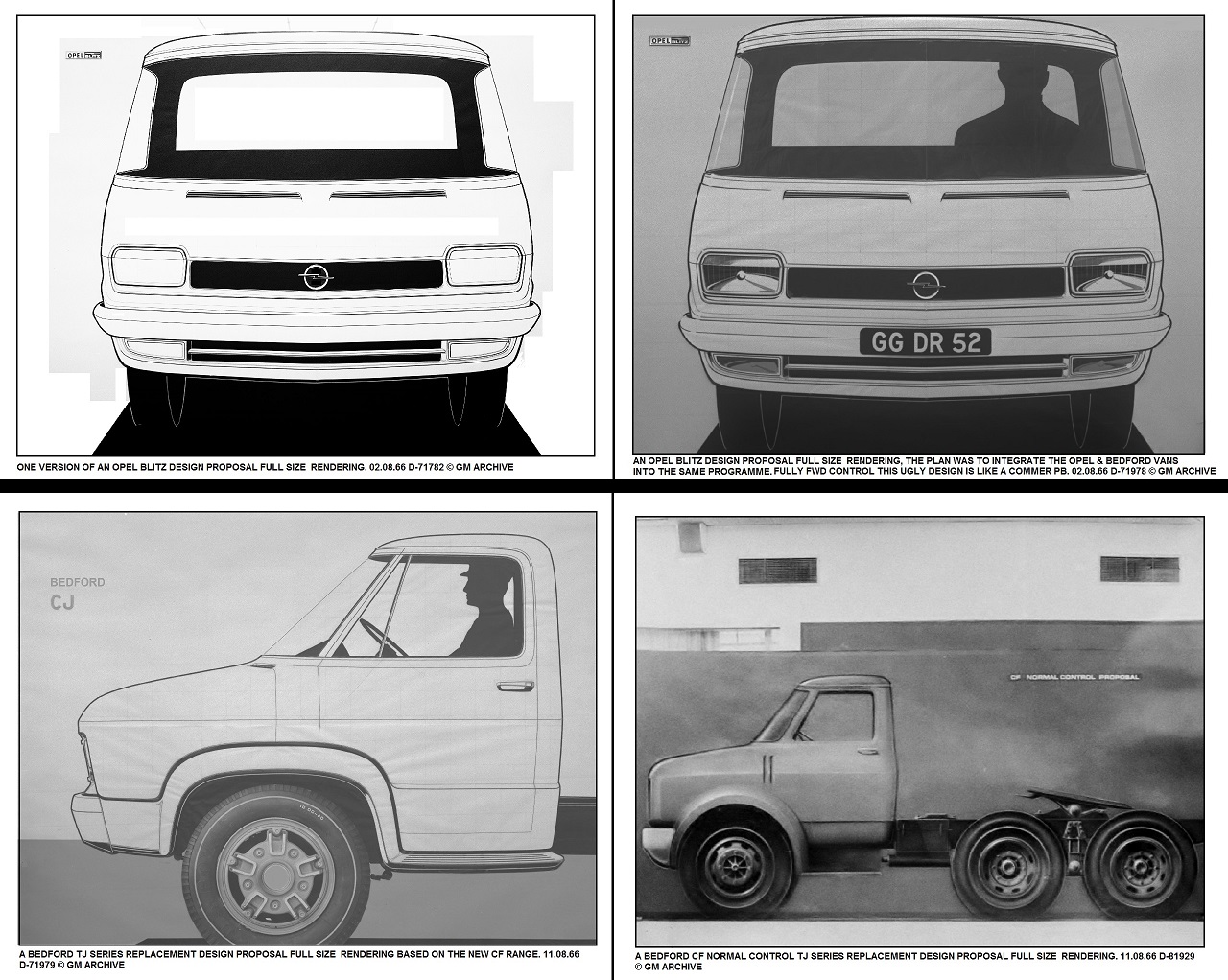
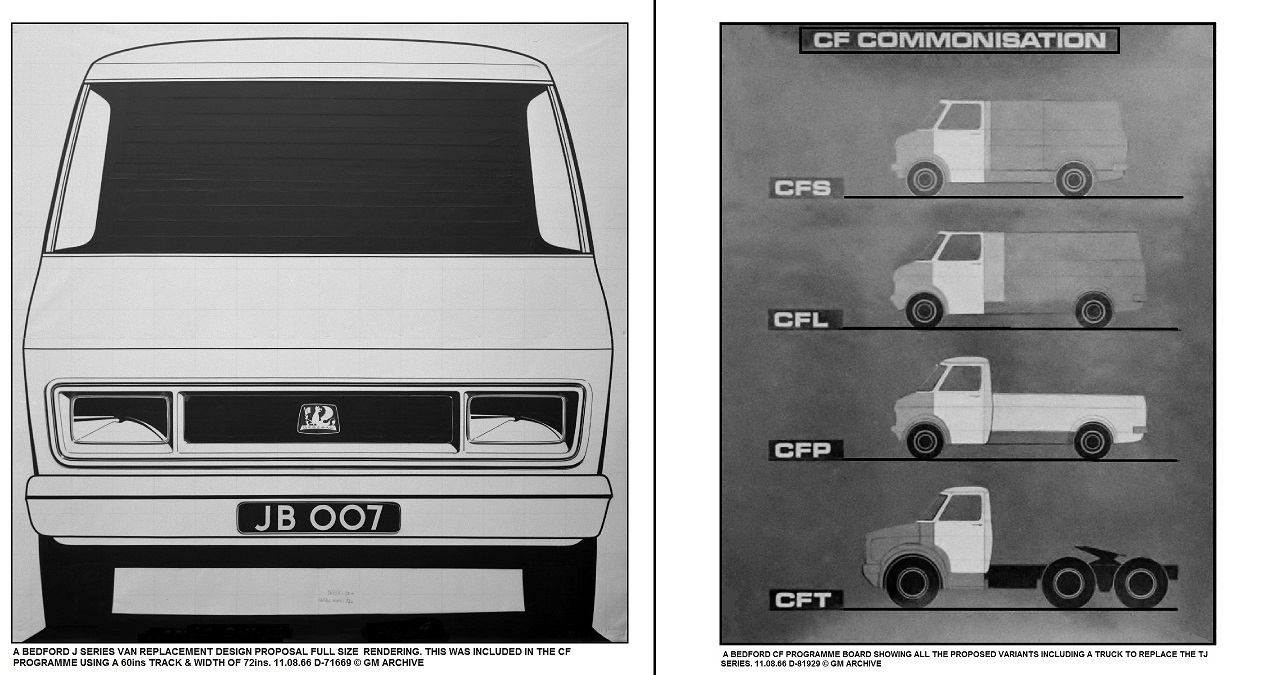
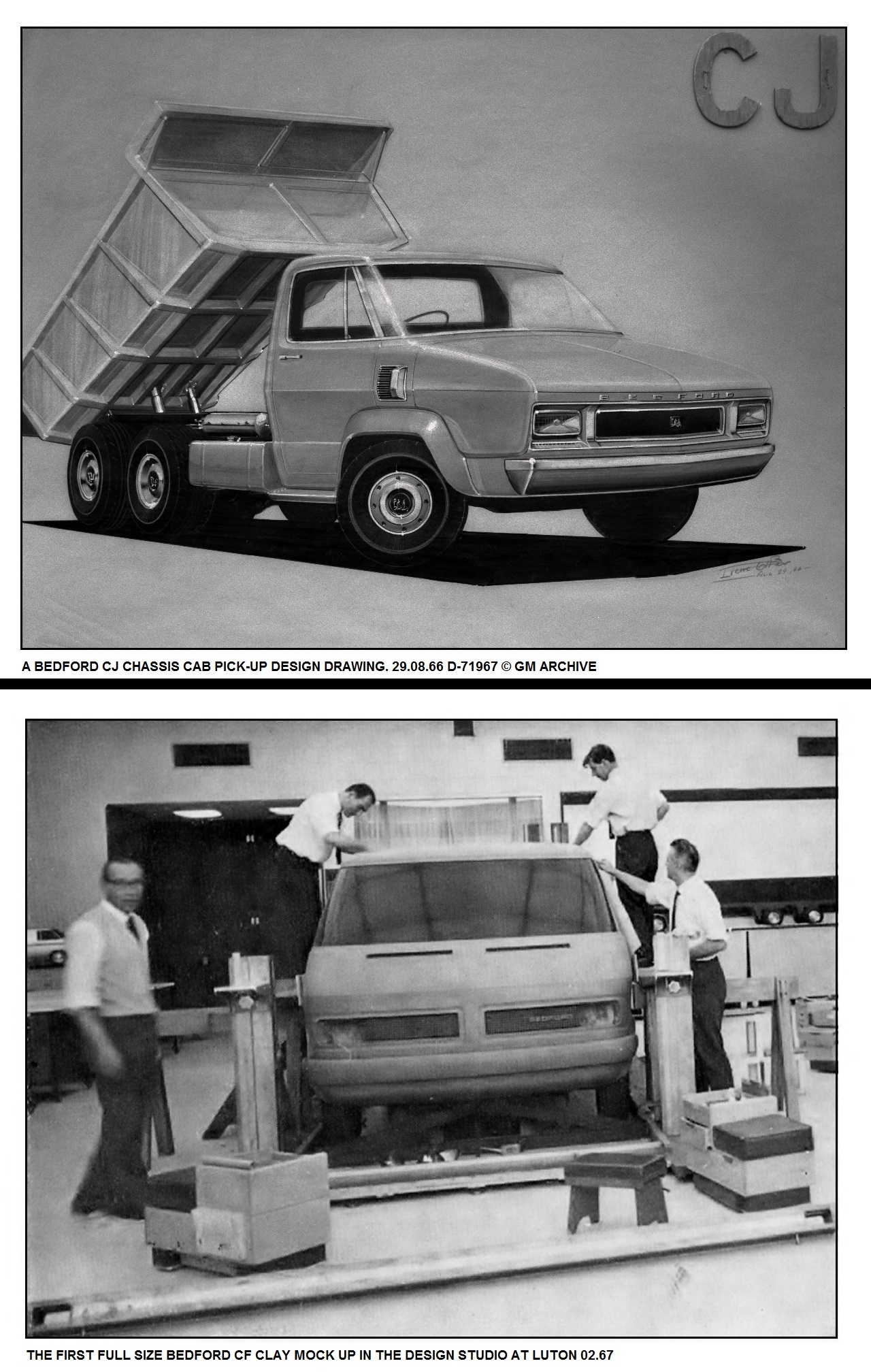
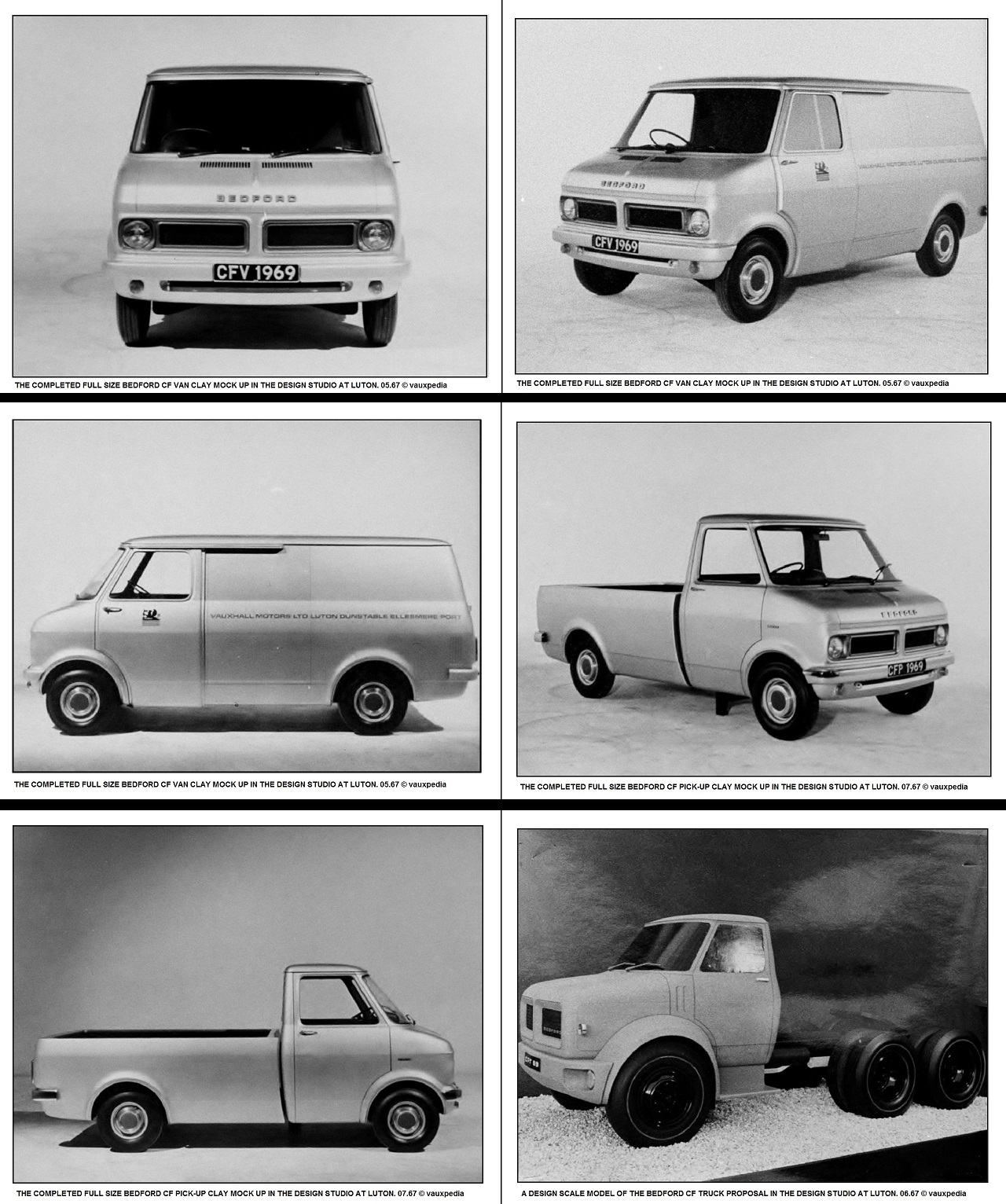
3. BEDFORD 97000 - CF PUBLIC LAUNCH 10.69:
Prototypes of the new Bedford CF were first shown to Vauxhall-Bedford Dealers and select large fleet operators in May 1969 and got an enthusiastic reception, the first public showing was at the London Motor Show in October 1969 with a full press release issued on 31 October 1969. The 25 model CF range replaced all CA models and some of the lighter versions of the TJ Series but model was still available in the UK & Europe until 1975 after which it was only offered for export, mainly in African markets. With up to the minute styling, belt driven OHC petrol engines, a choice of 2 diesel power units, rack & pinion steering and fully independent coil front suspension the CF specification made it one of the most advanced commercial vans available anywhere at the time. It either matched or beat the Transit in all critical areas and was literally light years ahead of the antique BMC J4 & JU and the Commer PB etc.
At launch the CF was listed as available in 5 weight
versions, 14, 18, 22, 25 & 35cwt. Two wheelbases – 106ins for
14, 18 & 22cwt models – 126ins for 25 & 35cwt models. A
choice of 4 engines – 1599cc OHC petrol standard or Perkins 4.108
diesel optional for 14,18cwt models – 1975cc OHC petrol standard
& Perkins 4.108 diesel optional for 22cwt models – 1975cc OHC
petrol standard & Perkins 4.154 diesel optional for 25cwt &
35cwt models. Gearbox choices were – 3 speed manual & optional
4 speed & 1975cc engine for 14,18cwt models – 4 speed standard
for 22cwt models – heavy duty 4 speed manual standard on 25 &
35cwt models. Body options were the same for all models – Panel
Van, Chassis Cab or Chassis Cowl. On the panel van there were 3
door configurations for all models – hinged cab doors standard,
sliding cab doors or hinged cab doors with side loading door
optional. Two cab trims – Standard & Deluxe, and three seat
configurations – Drivers seat standard, single or double passenger
seat optional. Production initially started with the 14, 18 &
22cwt versions with the 25 & 35cwt versions in build about a
month after launch. Also available shortly after the CF
announcement was the new GM Strasbourg 3 speed Automatic
transmission, initially as a SVO option due to shortage of supply,
but within a short time as a normal RPO option on 2000cc engines
only.
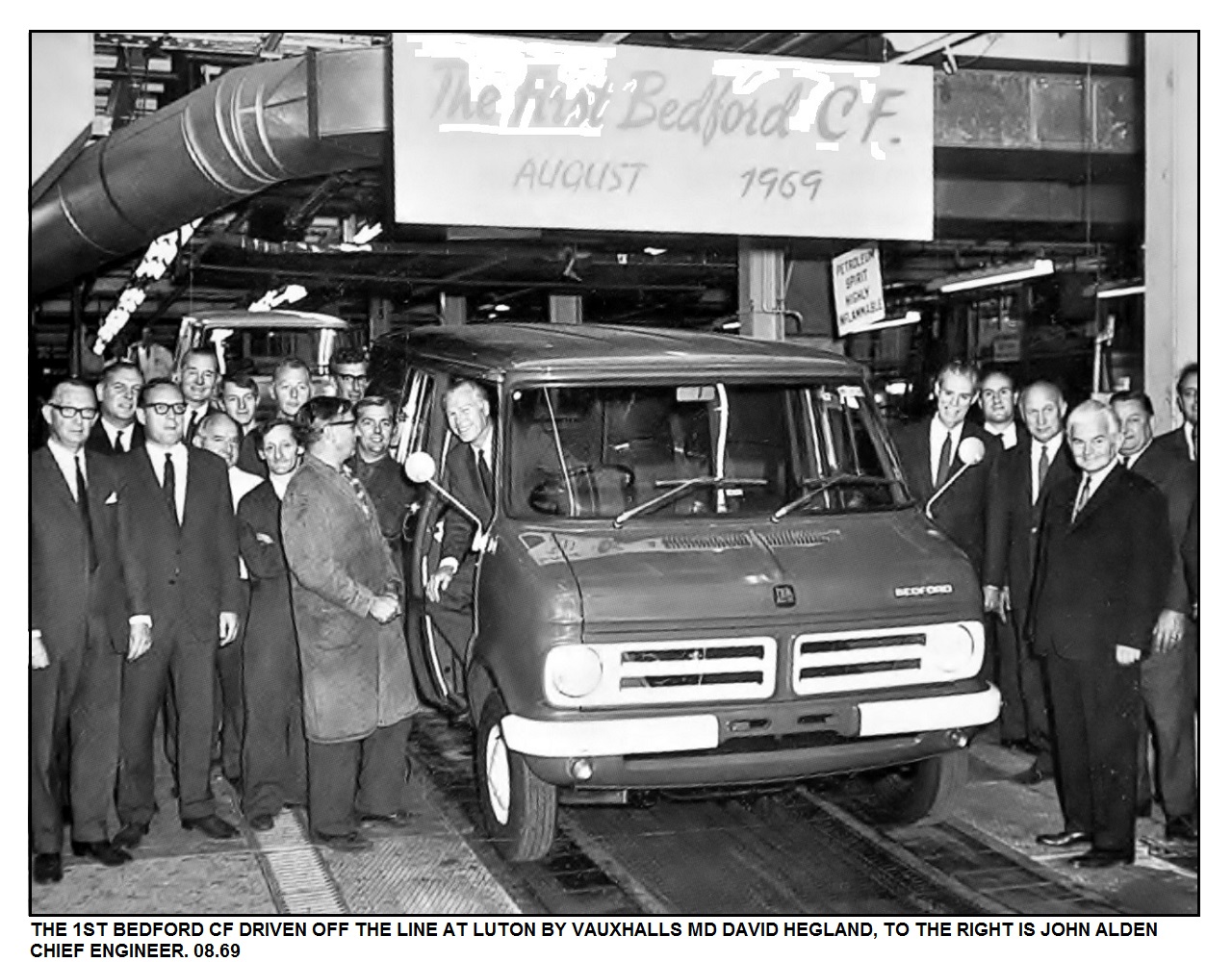
4. BEDFORD 97000 - CF LAUNCH PRESS RELEASE 31.10.69:


5. BEDFORD 97000 - CF PRESS LAUNCH ARTICLES:
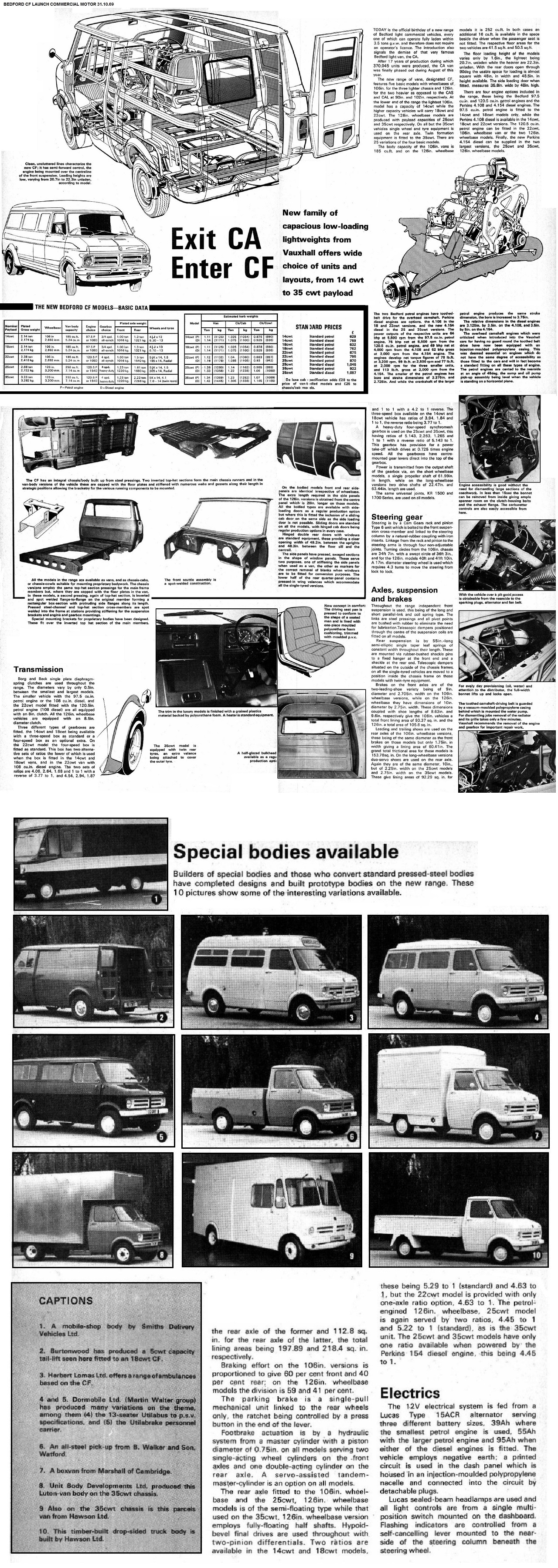
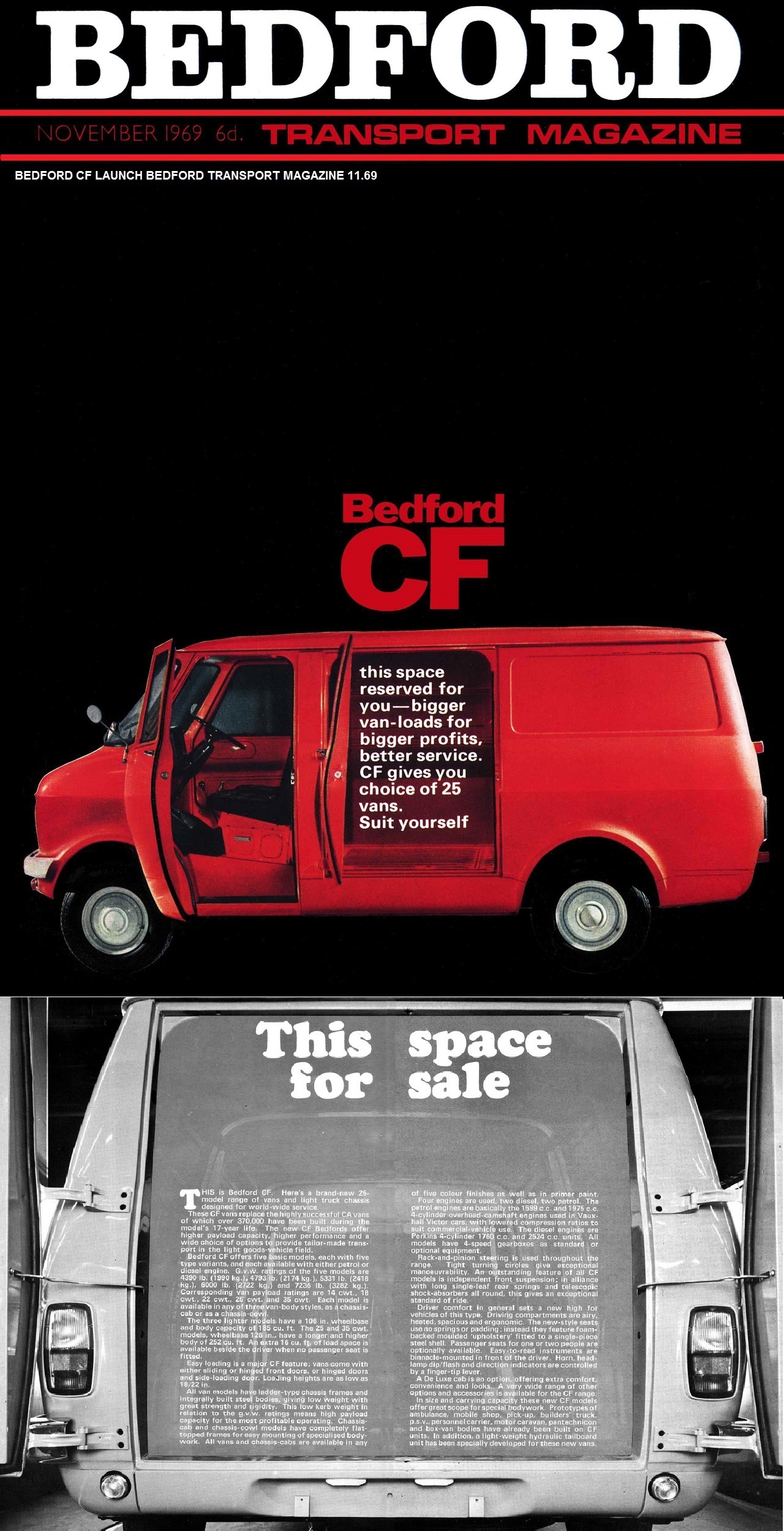
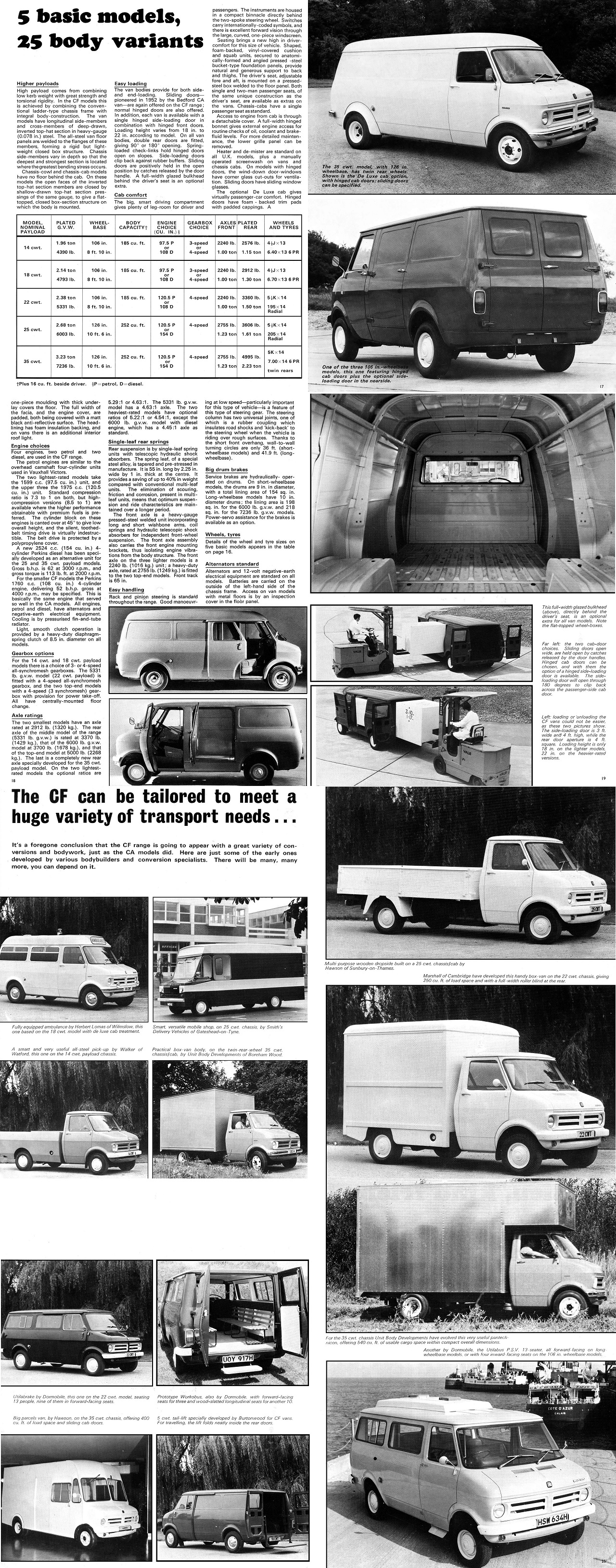
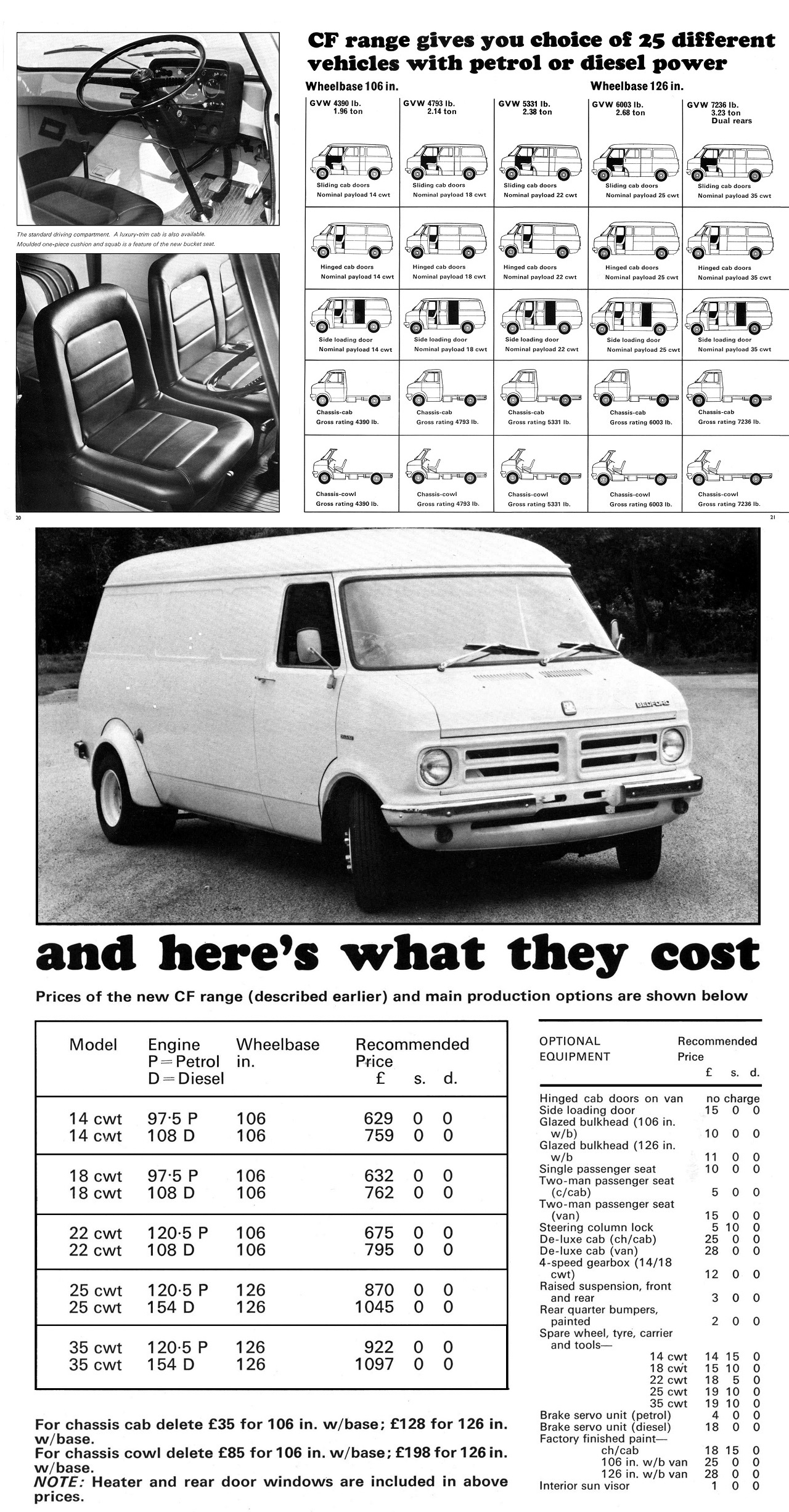
6. BEDFORD 97000 - CF PRODUCTION HISTORY:
Following the Bedford CF launch in October 1969 the model remained
virtually unchanged until the first major production change which
came in March 1972 when the CF petrol engines were enlarged, in
parallel with the launch of the Vauxhall FE Range, from 1599cc to
1759cc & 1975cc to 2279cc respectively, a new safety cover for
the cam belt had been introduced during 1971 . The 2.3litre CF now
became one of the fastest vans on the market and was popular with
drivers, particularly those involved in longer distance work. The
14cwt was also dropped from the UK range making the 18cwt the entry
weight model, although the 14cwt was still available in some export
markets.
The 3 speed manual gearbox standard on 18
& 22cwt models was one of the few CF weak points, even when
launched, and was rarely fitted as most customers opted for the 4
speed manual for the minimal extra cost. The 3 speed gearbox would
have been dropped sooner were it not for a large factory inventory
but was eventually deleted in March 1973 and the 4 speed became
standard ending once and for all the Vauxhall-Bedford predilection
for 3 speed manual transmissions that dated back to the Vauxhall 10
in 1938. In the same month Bedford began exporting CF vans &
chassis cabs to West Germany, badged as the Opel Bedford Blitz, it
was sold through the Opel dealer network & replaced their own
ageing Opel Blitz B van which dated back to 1965. The Opel Bedford
Blitz was initially available in 3 versions, 1.8litre CF97170 Van
with a GVW of 3240kg and 6.70 13 C tyres, 2.3litre CF97370 Van with
a GVW of 2540kg and 195R 14 C tyres and 2.3litre CF9370H Chassis
Cab with a GVW of 2740kg and 205R 14 C tyres. All models featured
the Deluxe specification cab but the one-piece moulded driver’s
seat, which looked more comfortable than in reality, was replaced
by a high backed fully adjustable seat in perforated Ambla. The
standard 2-man passenger seat was the same as in the normal CF, but
this was replaced within months by a single passenger seat of the
same design as the
drivers.
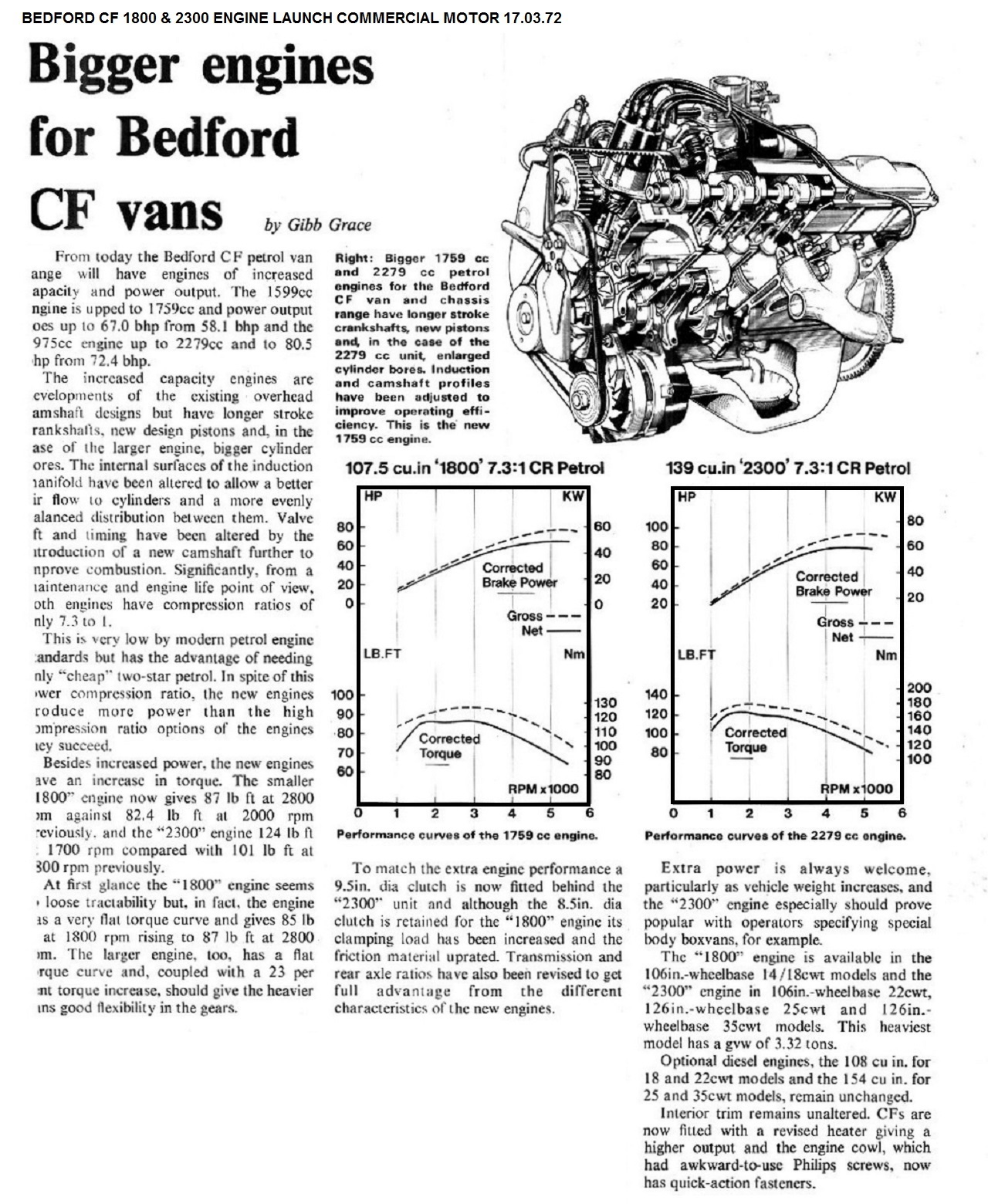

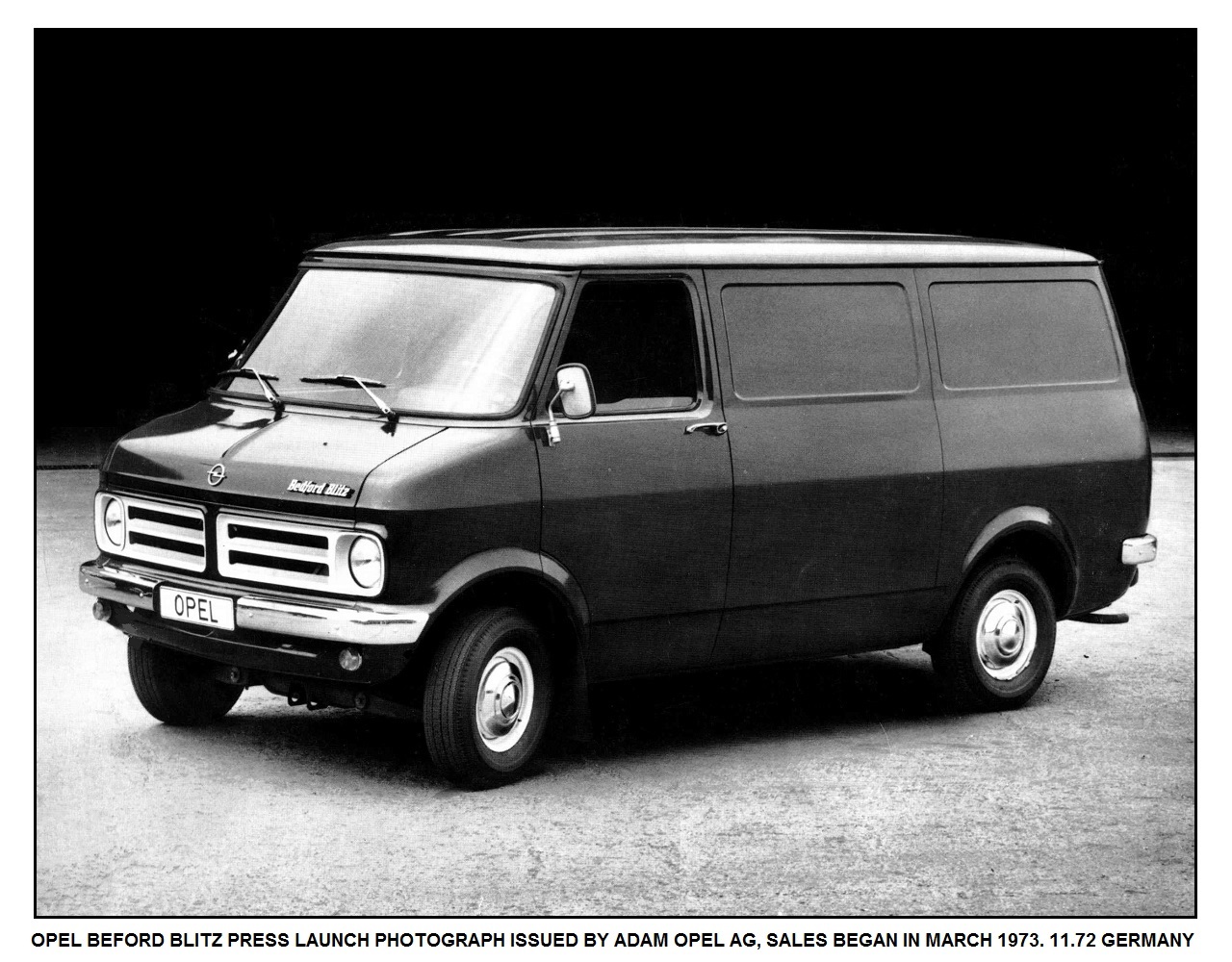
For the 1974 model year the heavy duty 4 speed Bedford TK gearbox
fitted to the petrol engine 25 & 35cwt CF models were replaced
by a 4 speed ZF gearbox as standard or a 5 speed ZF as an extra
cost option. The diesel CF versions continued to use the TK gearbox
with synchromesh on upper 3 ratios. Unusual for the time, overdrive
now became an available option on the CF 18 & 22cwt petrol
models. In Australia, Holden had been selling locally produced
Bedford CF petrol models since 1970 which were assembled largely
from CKD kits supplied by the Luton plant with the OHC 1600 &
2000 engines being fully imported, the 1600 was even fitted to the
Holden Torana LC from July 1971. Due to the operating conditions in
Australia and the fact that the OHC Slant Four engine was a complex
unit for some of the more remote servicing agents who were used to
the reliable, rugged simplicity of Holdens own OHV engines, and
also in an effort to increase the local content of the CF, Holden
engineers shoehorned their own 112bhp 2.85litre (173cu.in) straight
six engine & gearbox into the CF Van. Launched in July 1973,
for the 1974 model year, the range consisted of 18 & 20cwt vans
on a 106ins wheelbase and a 35cwt on a 126ins wheelbase, with
chassis cab versions available to special order. The Holden 3speed
manual gearbox was standard on the SWB versions and 4speed for the
LWB version, the Holden 3speed Tri-matic automatic transmission was
optional on SWB models. All CF van models were fitted with sliding
doors with slam type fitted to the chassis
cabs.
The 1975 models were re-named according to their
gross vehicle weights (GVW) – the CF 18cwt, 22cwt, 25cwt &
35cwt became the CF 220, 250, 280 & 340 with an identification
badge on the front wings. The standard 220 & 250 cab now
included electric screen wash, chrome hub caps and the one-piece
moulded cab seats were replaced in all models by the more
comfortable design that had been introduced for all German market
models in 1973. Deluxe models with slam doors also featured new
full door trim. An additional LWB 140ins wheelbase model was also
added to the range, the CF 350, available as a chassis cab or cowl
with the 2279cc petrol or the optional 4.154 Perkins diesel engine.
In June 1975 the new Opel 2.1litre diesel engine became an option
for an expanded Bedford Blitz van range in Germany. Due to the
production demand for the first Opel designed diesel engine being
fitted to cars across Europe, Germany remained the only market
where the 2.1litre diesel engine was offered in any CF model for
almost a year. In October 1975 a limited edition CF Special was
launched, it was based on the standard CF250 with the 2.3litre
engine and added factory white paint, chrome bumpers front &
rear, rake adjustable driver’s seat, passenger seat, inertia reel
seat belts, matt black deluxe trimmed cab, vinyl headlining with
twin matching sun visors, full width floor matt, interior mirror
and a cargo area light all for a special price of £1789.00 with GM
Automatic for another
£127.00.
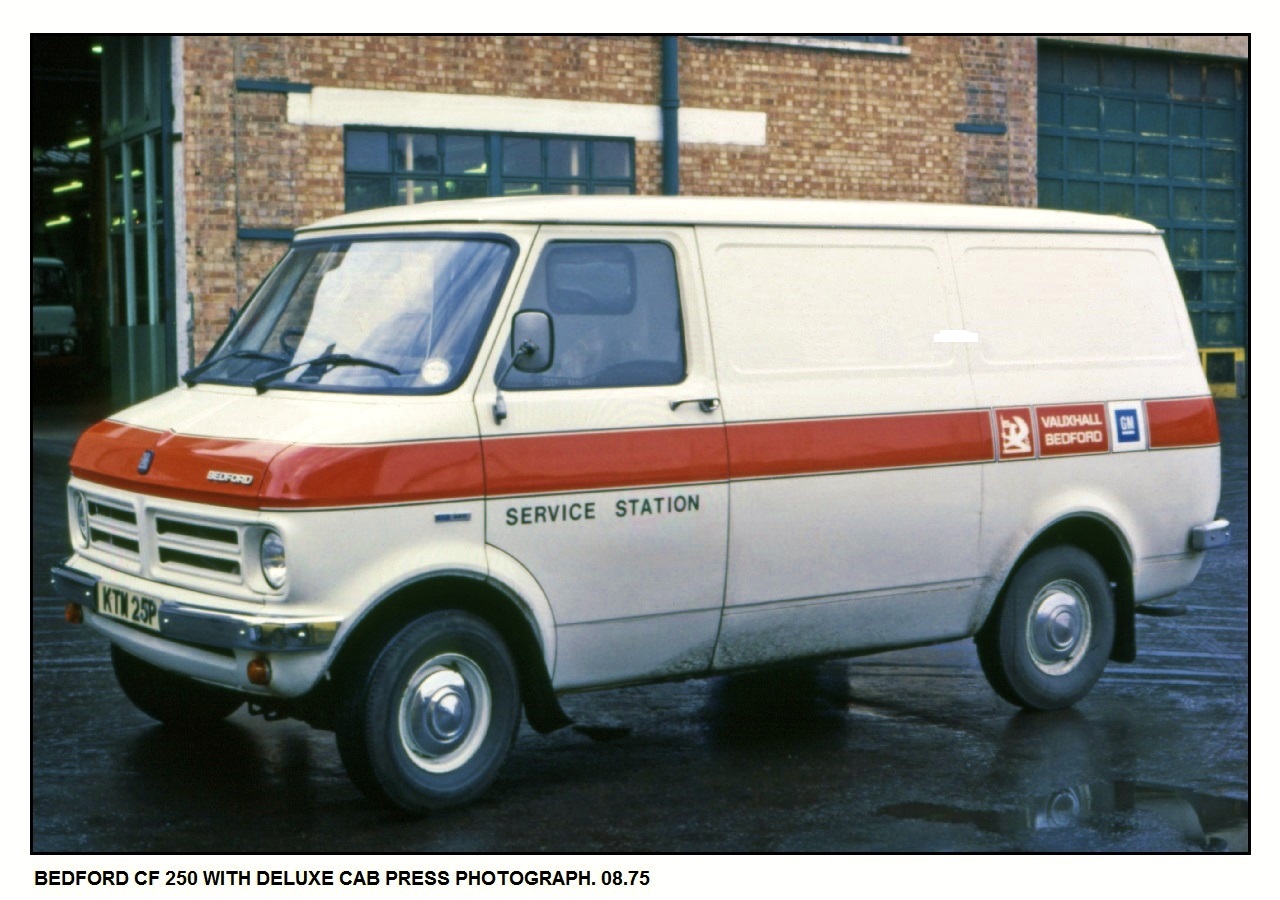
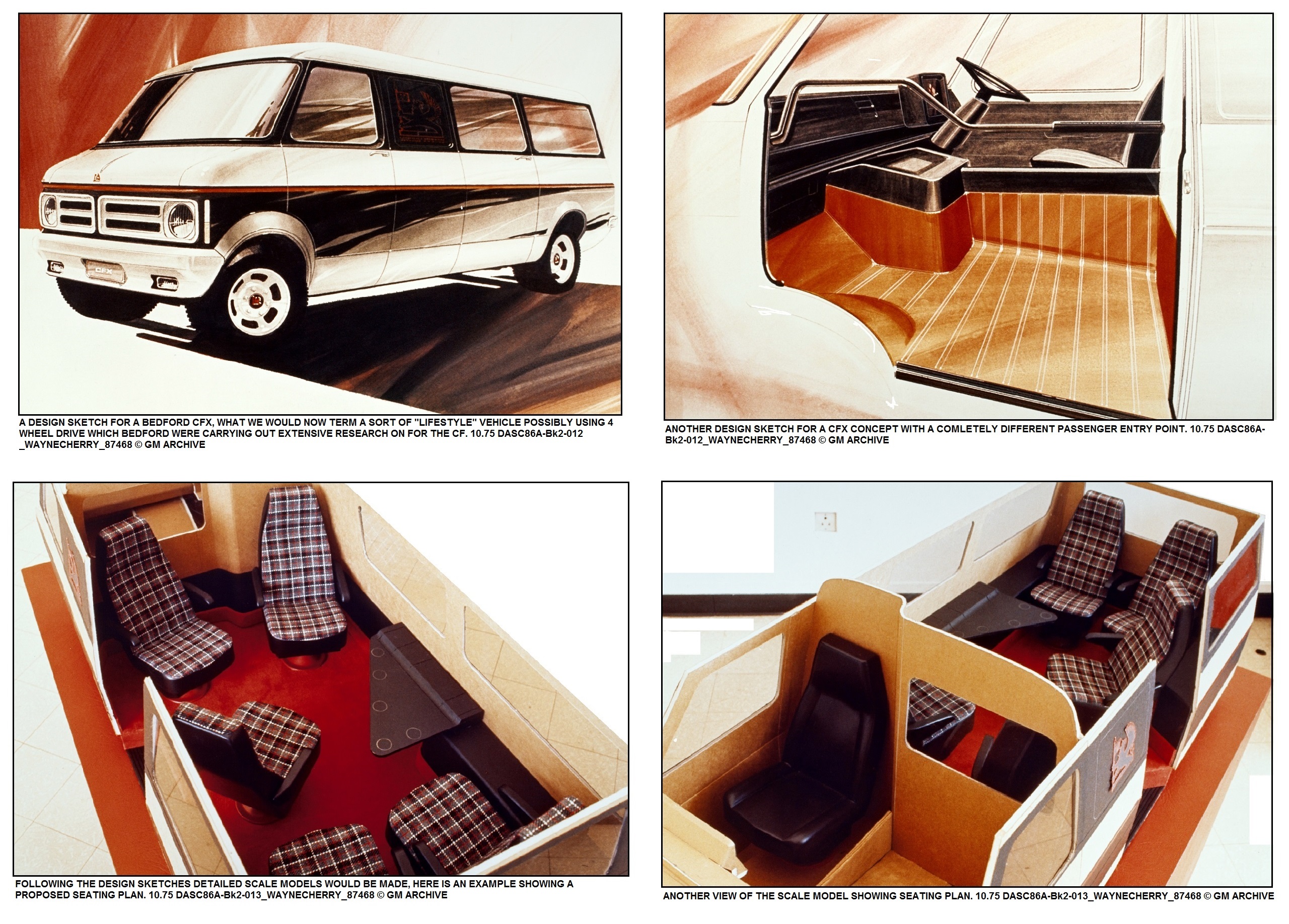
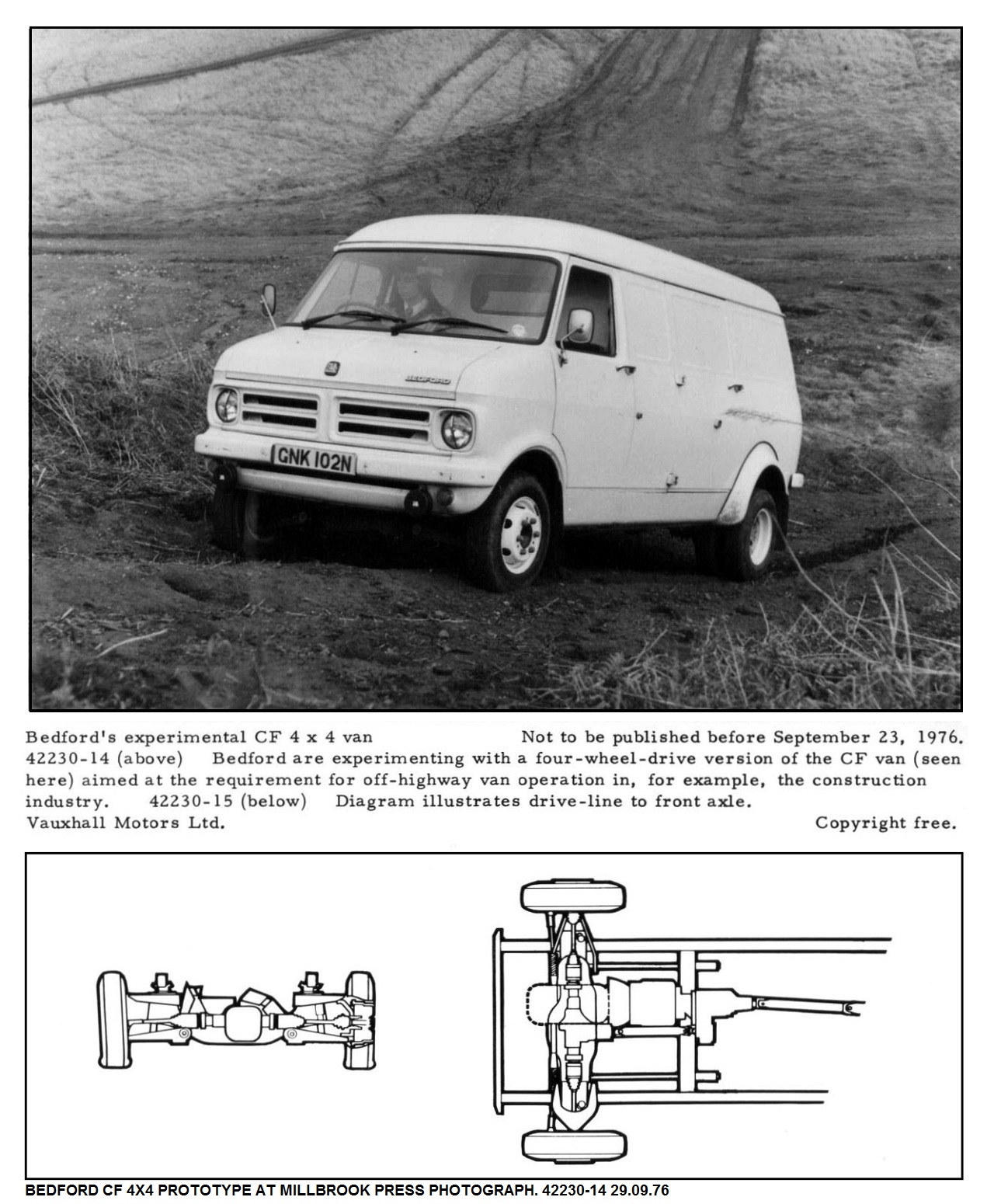
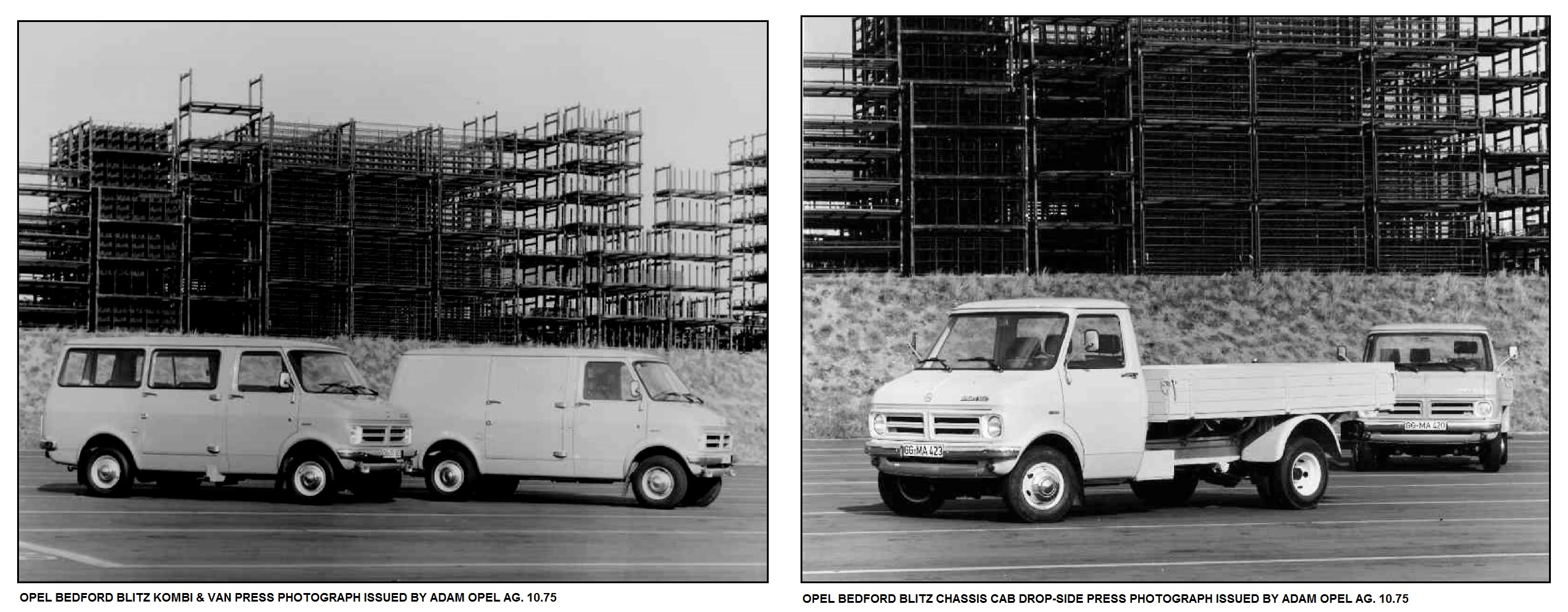
The Bedford CF for 1976 came with only minor
visible changes, non-reflective wiper arms and on Deluxe models a
5-way adjustable driver’s seat along with additional sound
deadening, revised floor trim, engine cowl and doors - with
armrests fitted to slam door versions. The standard warranty was
still 1 year but now had no mileage limitations. The OHC petrol
engine models benefitted from the changes made for the introduction
of the Vauxhall VX Series in February 1976, this included a revised
cylinder head which featured larger valves with rotators,
repositioned spark plugs and a thermostatically controlled air
intake system. Both engines now produced 0.5bhp more power at the
same engine speed, torque figures remained the same but the 1759cc
engine produced its maximum at 2000rpm instead of 2800rpm. In
European export markets both the Perkins diesel engines were
gradually withdrawn from May 1976 onwards and replaced by the
2.1litre Opel diesel which was also available in 1.9litre form for
certain markets where engine size was a taxation issue, CF sales
across Europe increased by 40%. Also in 1976 Bedford began
experimenting with a 4-wheel drive CF, initial design and
development was done at Luton with testing at Millbrook Proving
Ground but the limited market potential meant this work was
eventually completed by the specialist manufacturer FF Developments
who eventually put the vehicle into limited production and was sold
officially through the Vauxhall-Bedford dealer
network.
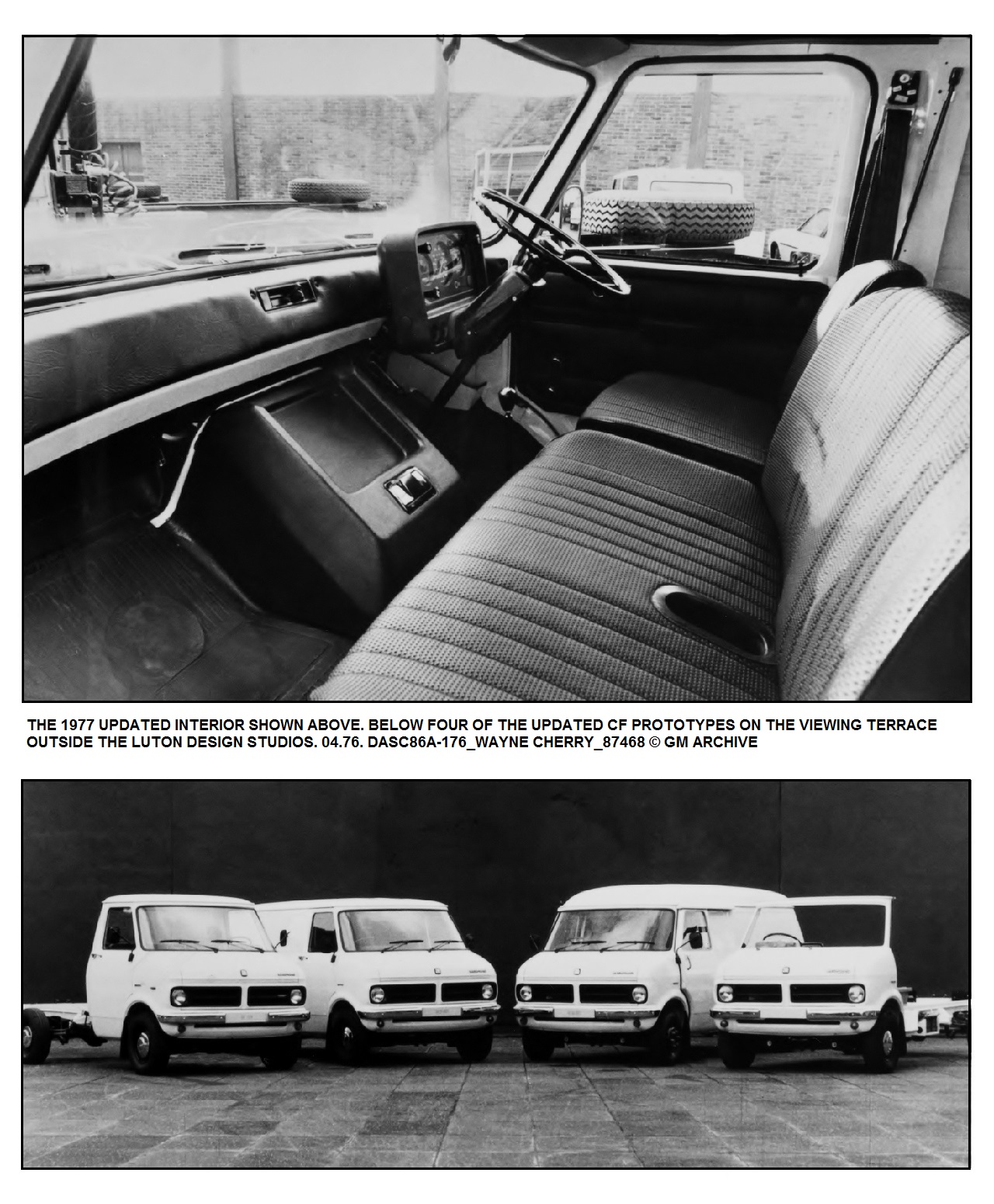
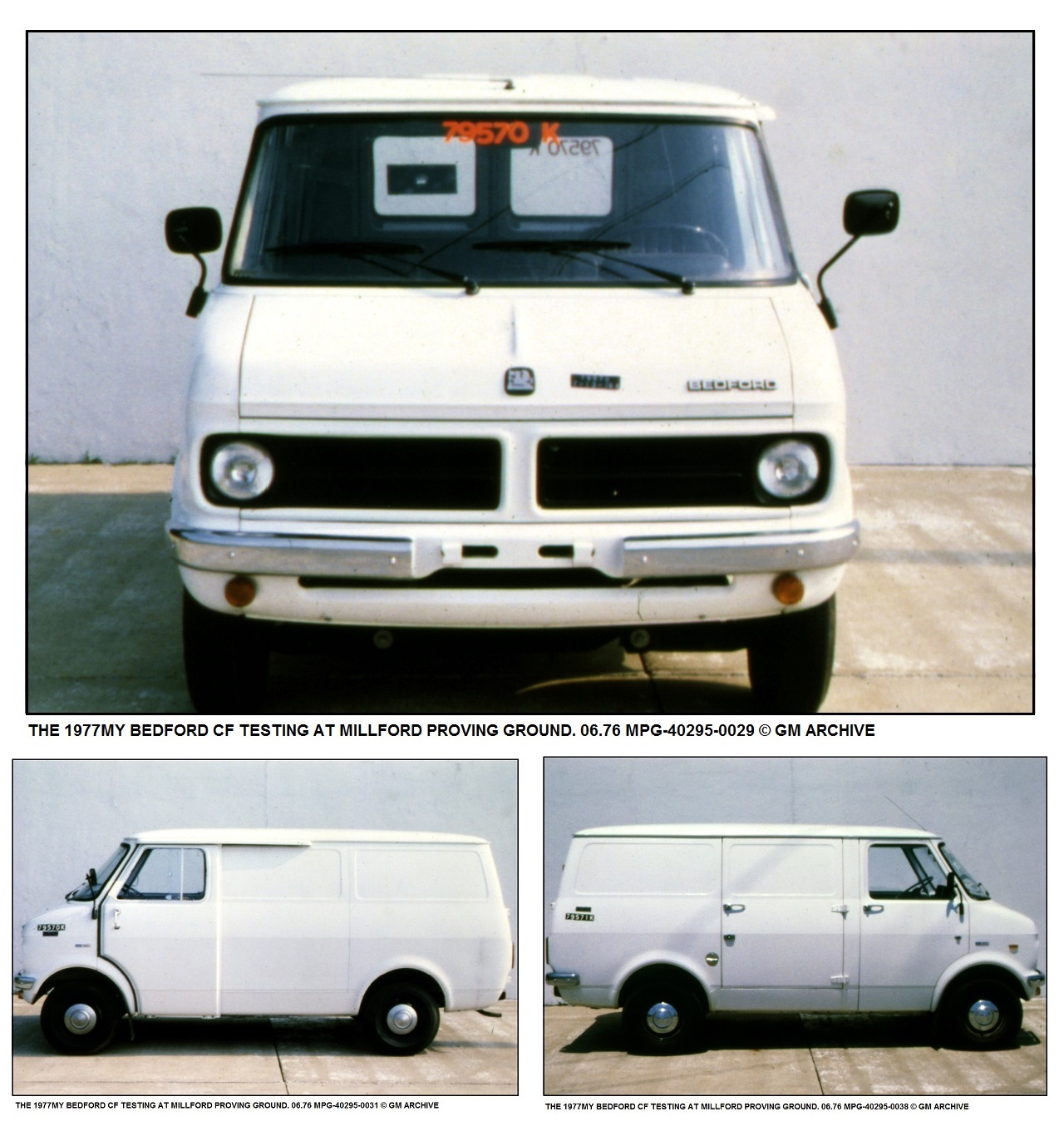
The first facelift, what Bedford internally called an
interim update, was introduced for the 1977 model year. Externally
the front grille was painted as standard in black both sides with a
“Diesel” badge on the left hand side when fitted. The Perkins
diesel engines, already withdrawn in European markets, were now
replaced by the more refined 2.1litre GM diesel engine in the UK as
well, producing 59bhp @ 4400rpm & 87ft.lbs @ 2200rpm torque
meant it was 1bhp short of the previous largest Perkins unit and
crucially giving an extra 10.5bhp and 7.5ft.lbs compared to the
smaller Perkins diesel. A 2.0 and 1.9litre version was available in
certain export markets depending on local taxation applying to
engine size. For the first time the GM 3speed automatic
transmission could be specified on the CF 220, 250 & 280 models
with the diesel engine option. All the 280, 340 & 350 models
came as standard with ZF 4 speed gearbox with the 5 speed optional,
these replaced the heavy duty Bedford 4 speed gearbox, overdrive
was now an SVO option on the CF 220 & 250 with the 1759cc
engine on CF 220 and 2279cc engine on CF 250. CF 220 & 250
models featured a 2 piece propshaft and 20% uprated rear
differential along with upgraded suspension components also fitted
to the 280 which improved ride & handling. 340 & 350 models
were fitted with larger diameter shock absorbers, but a soft ride
option was available for passenger carrying vehicles. The 280 &
340 petrol models also featured a driveline mounted flywheel fitted
between axle pinion flange & the propshaft for smoother
running. All models were fitted with dual line braking systems
fitted with a vacuum servo unit. The CF cab was improved with
additional sound deadening to the headlining, engine cover and
floor covering. Only one trim level was offered with the seating in
a choice of perforated Ambla or optional Plaid cloth trim, hinged
cab doors also used plastic caps on the rear lower corners. A
change to higher quality body primer and zinc based primer to the
roof bows & cant rails improved body protection. One handed
rear door operation and a chrome petrol filler cap finished off the
changes.
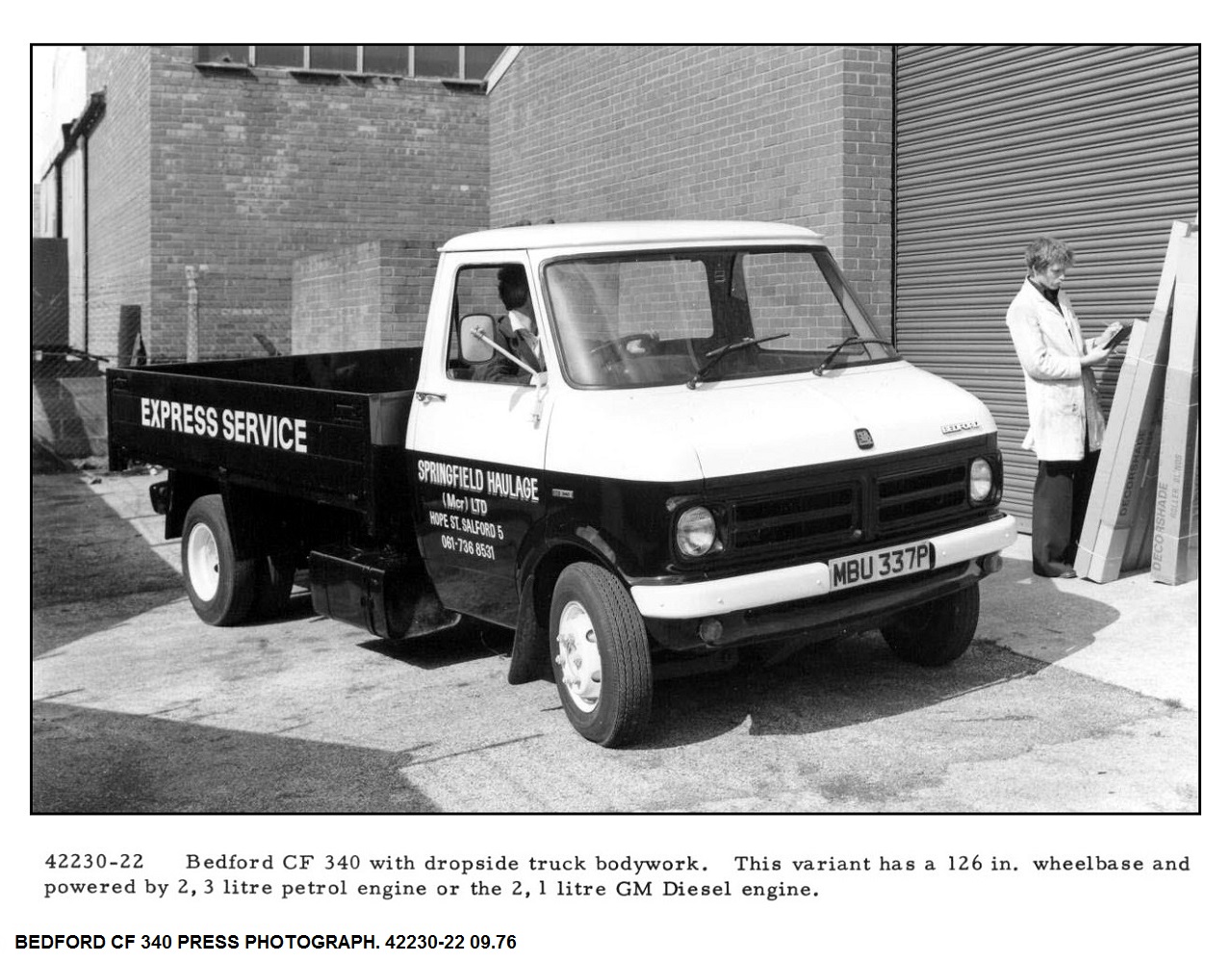
There were no major specification changes to the Bedford CF models for the 1978 model year apart from the heater & demister controls were usefully moved from the hard to reach centre of the dashboard to an additional binnacle next to the instrument pod and within easy reach of the driver. It was during 1978 that work began on a major facelift scheduled for 1980 introduction, this was to involve new front end styling and a new interior & dashboard. The first prototype featured the updated interior but an only mildly altered front end, this didn’t address the CFs one remaining major weakness – engine access for major servicing, on petrol engine models in particular. It was decided to let John Taylor & Geoff Lawson work on a more radical redesign for the front end.

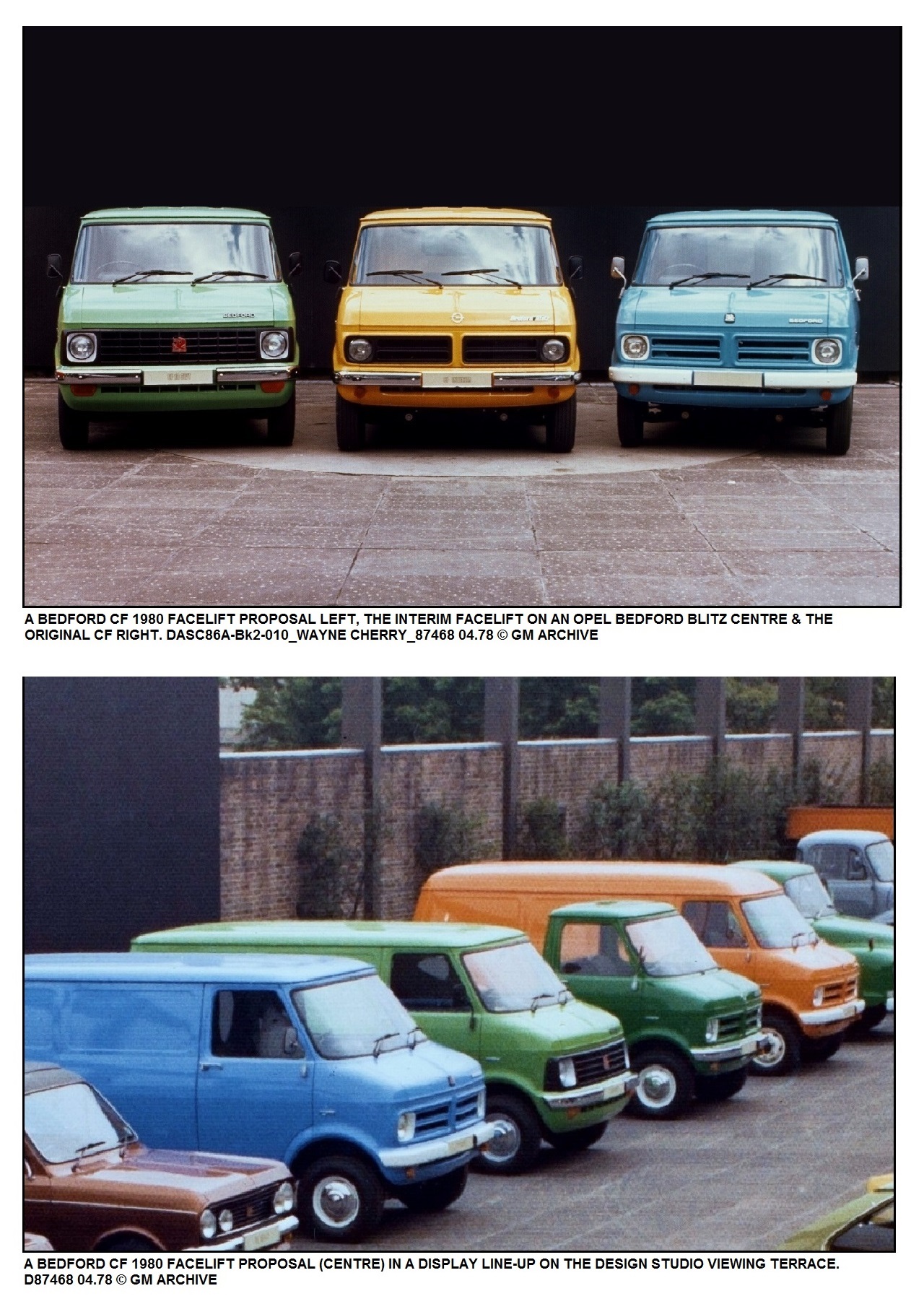
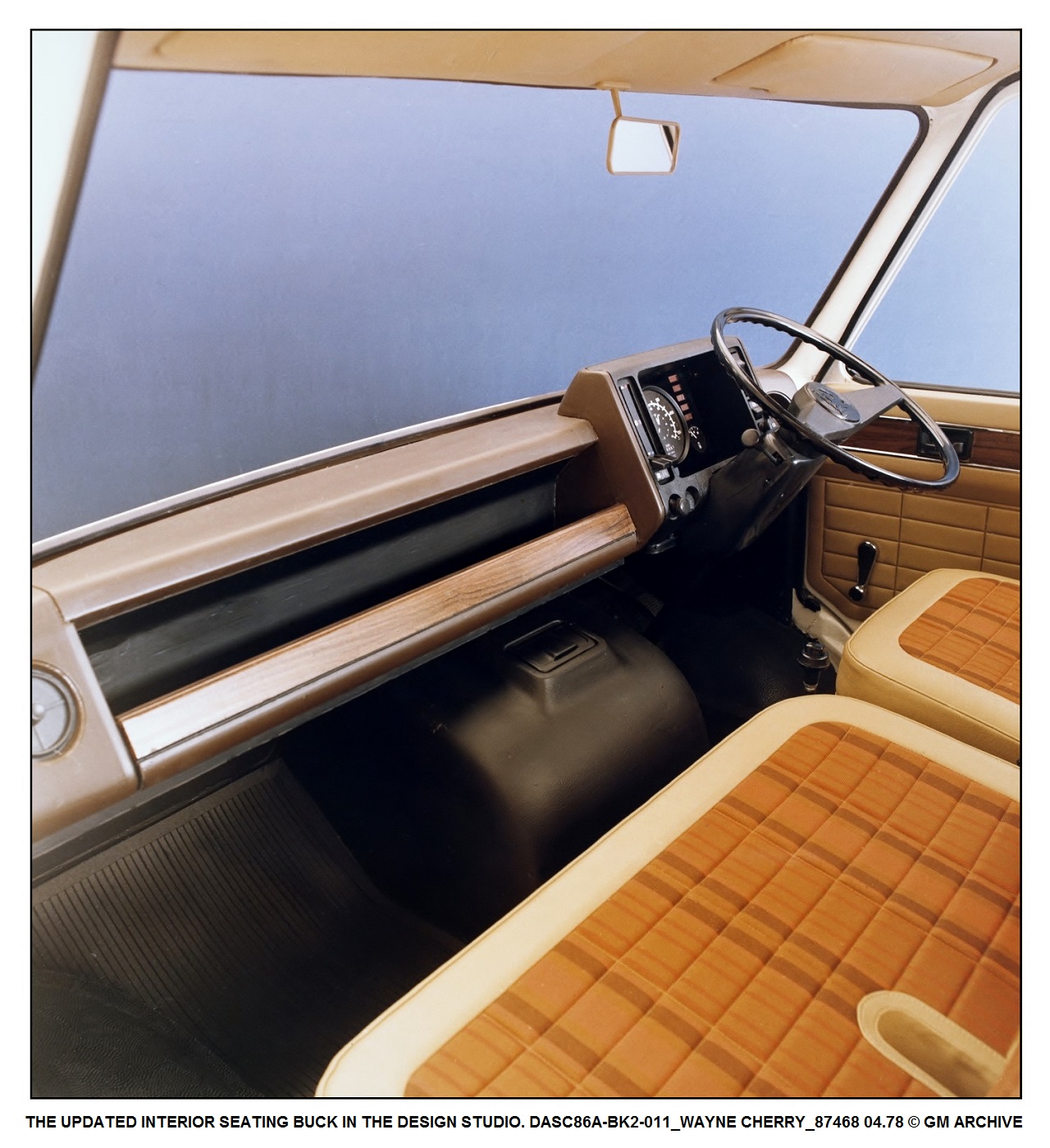
The 1979 model year was pretty much devoid of any significant specification changes to the Bedford CF range. Inertia reel seat belts replaced the static versions, a steering column lock became standard and the GM diesel engine was slightly reduced in size – from 2064cc to 1998cc with the same power but a slight drop in torque from 87ft.lbs to 86 at the same 4400rpm as before.
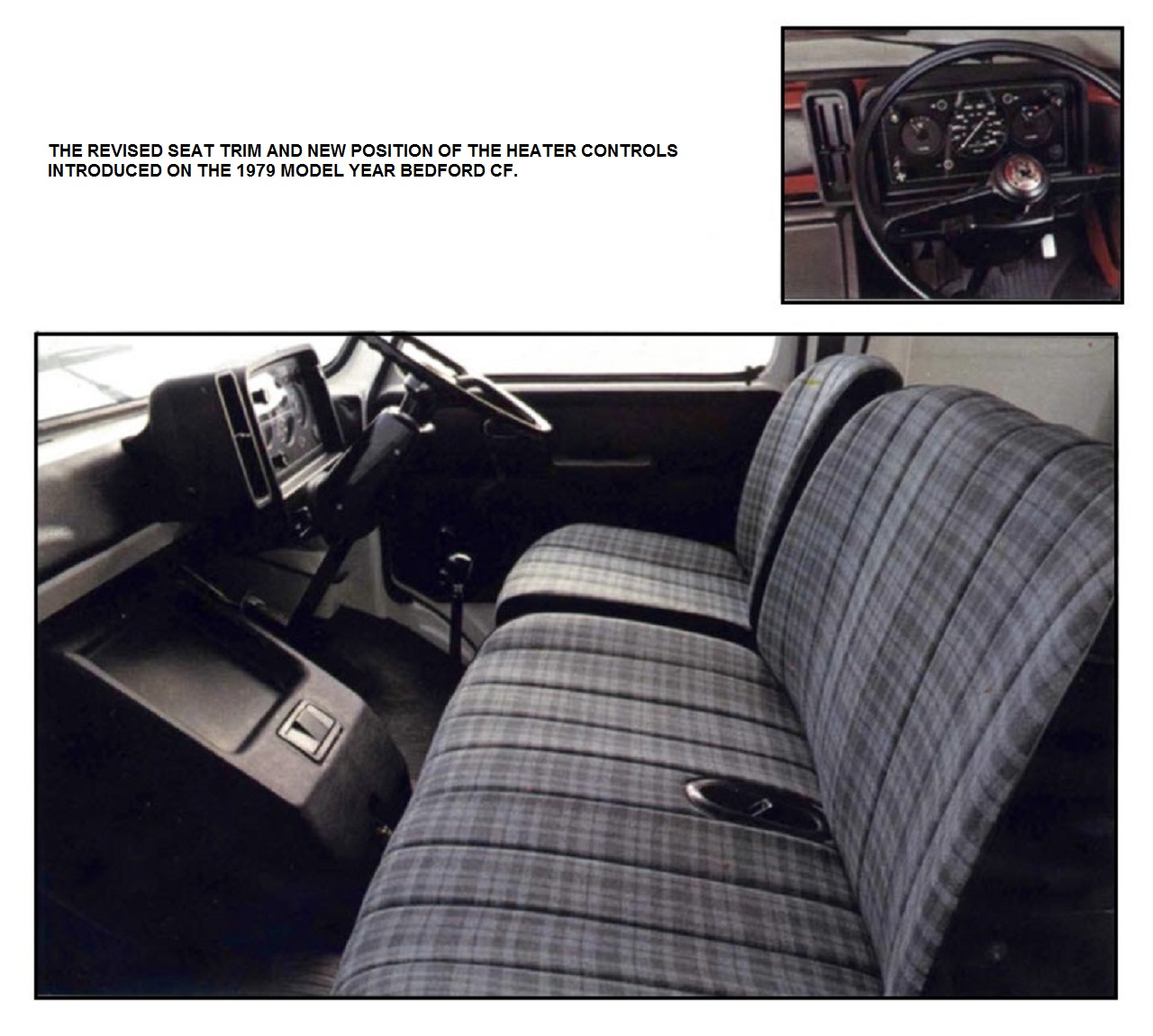
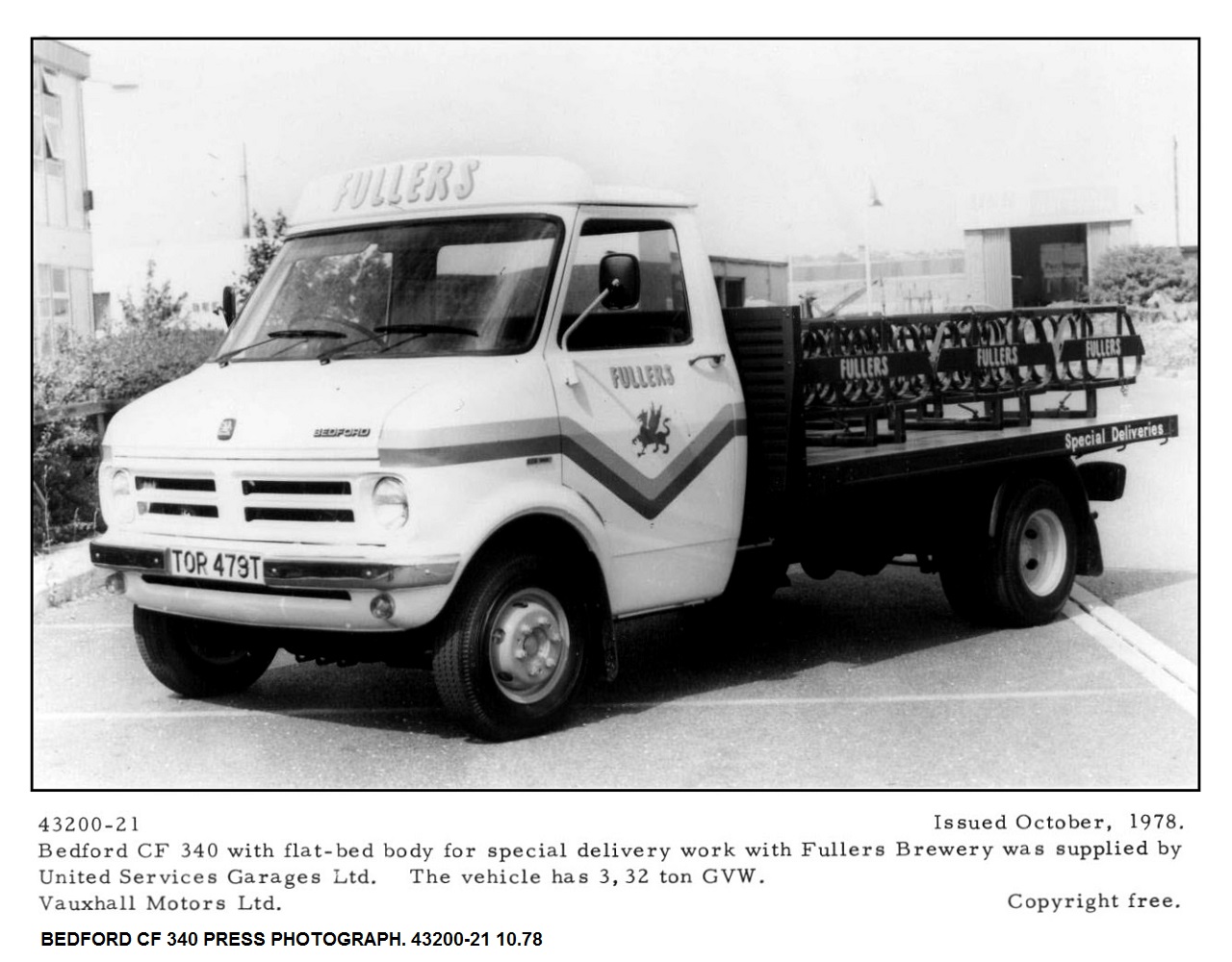
Launched at the Frankfurt Motor Show in September 1979 the 1980 model year CF featured a stylish, completely new and redesigned dashboard facia which was a significant upgrade compared to the previous model and accommodated new legal and operational requirements. A new instrument housing included a speedometer and factory fitted tachograph if required, new fuel & temperature gauges along with a stem of warning lights to monitor ignition, hydraulic brake pressure, brake wear, oil pressure and indicator lamps. The new housing also included built in heater controls which had been moved in the previous model year. As well as a new soft feel 2 spoke steering wheel there were new switches for the lights and hazard flashers as well column stalk operation for washers & wipers including a pulse wipe feature. New eyeball fresh air vents were added at each end of the dashboard which now included a 6ins deep parcel shelf with provision for radio fitment for the first time and a wood effect trim on the leading edge. Sound deadening was improved by new insulated foam backed one-piece moulded rubber floor covering, foam backed vinyl headlining and increased foam backing for the new design engine cover. Colour matched new style door trim & armrests complimented the new seating in plaid cloth with vinyl side trim, there were also A pillar trim covers fitted for the first time. As far as van interiors go the overall effect transformed the CF driver environment and was typical of Wayne Cherry, Head of Design, being stylish, practical and cost effective. The CF220 model was upgraded to CF230 and the 140ins version of the CF350 was now designated CF350/L. A new optional sliding side loading door was available on all but CF350 models. Chrome bumpers now became an option on all models.
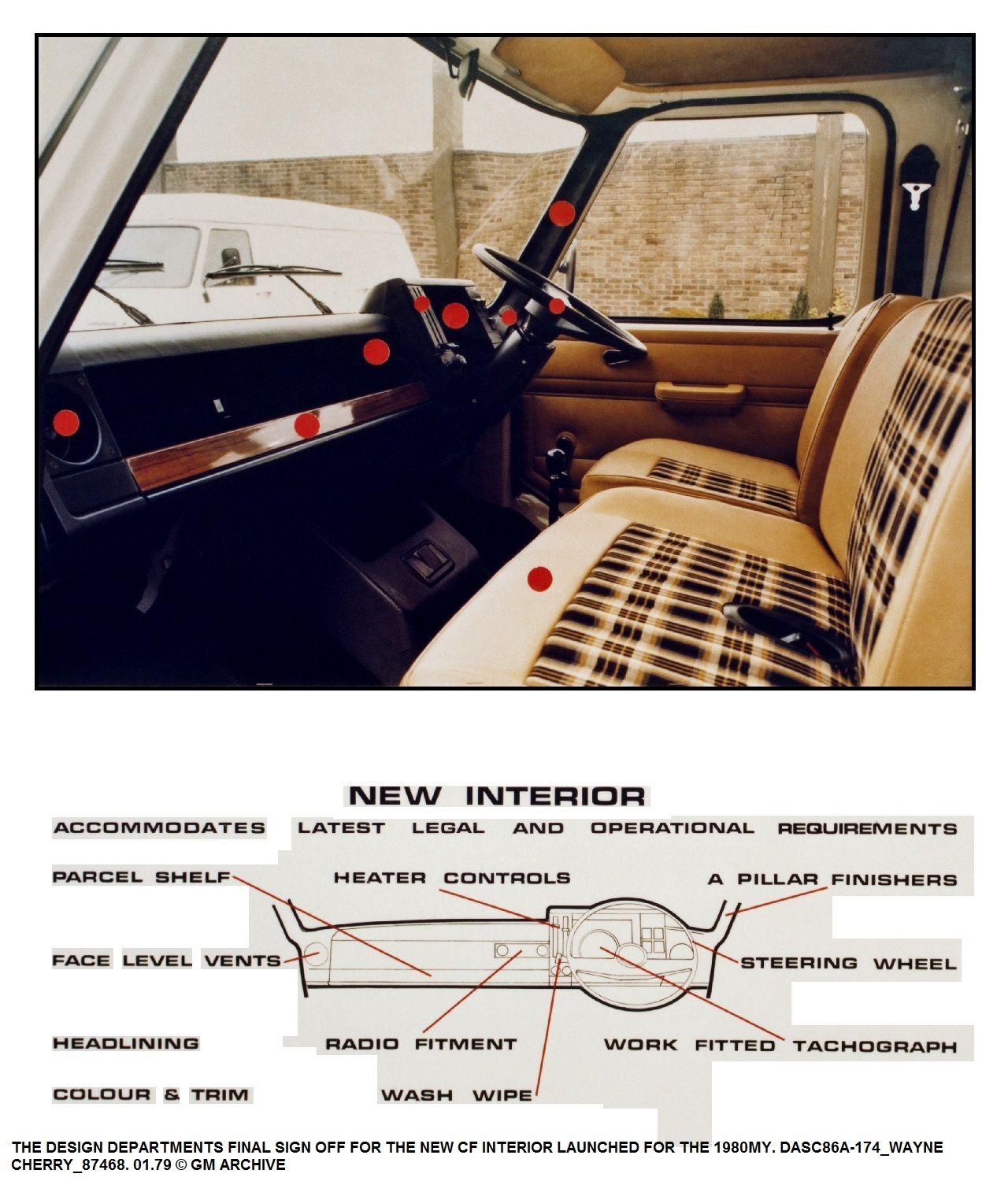
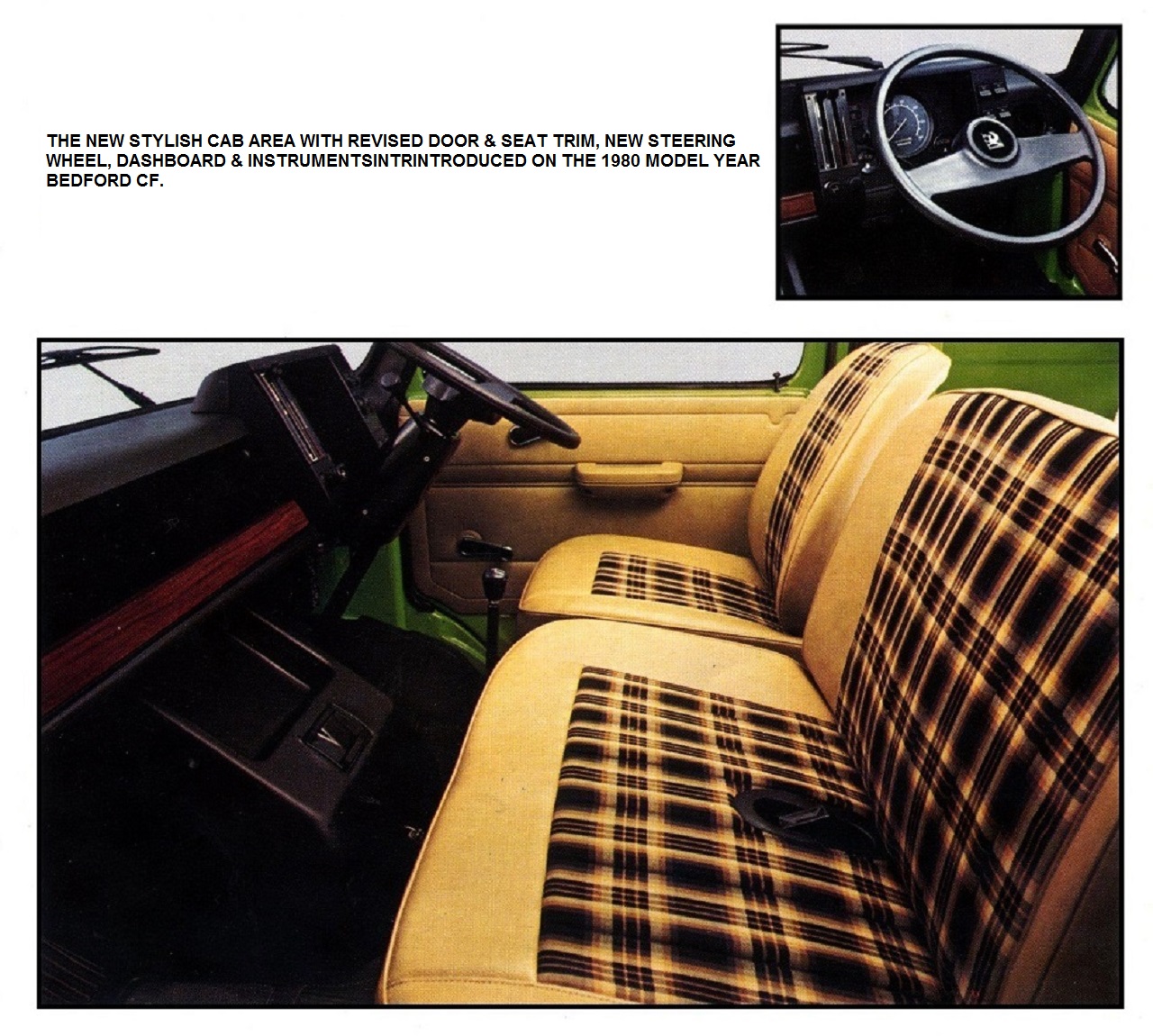
Launched at the Frankfurt Motor Show in September 1979 the 1980 model year CF featured a stylish, completely new and redesigned dashboard facia which was a significant upgrade compared to the previous model and accommodated new legal and operational requirements. A new instrument housing included a speedometer and factory fitted tachograph if required, new fuel & temperature gauges along with a stem of warning lights to monitor ignition, hydraulic brake pressure, brake wear, oil pressure and indicator lamps. The new housing also included built in heater controls which had been moved in the previous model year. As well as a new soft feel 2 spoke steering wheel there were new switches for the lights and hazard flashers as well column stalk operation for washers & wipers including a pulse wipe feature. New eyeball fresh air vents were added at each end of the dashboard which now included a 6ins deep parcel shelf with provision for radio fitment for the first time and a wood effect trim on the leading edge. Sound deadening was improved by new insulated foam backed one-piece moulded rubber floor covering, foam backed vinyl headlining and increased foam backing for the new design engine cover. Colour matched new style door trim & armrests complimented the new seating in plaid cloth with vinyl side trim, there were also A pillar trim covers fitted for the first time. As far as van interiors go the overall effect transformed the CF driver environment and was typical of Wayne Cherry, Head of Design, being stylish, practical and cost effective. The CF220 model was upgraded to CF230 and the 140ins version of the CF350 was now designated CF350/L. A new optional sliding side loading door was available on all but CF350 models. Chrome bumpers now became an option on all models.
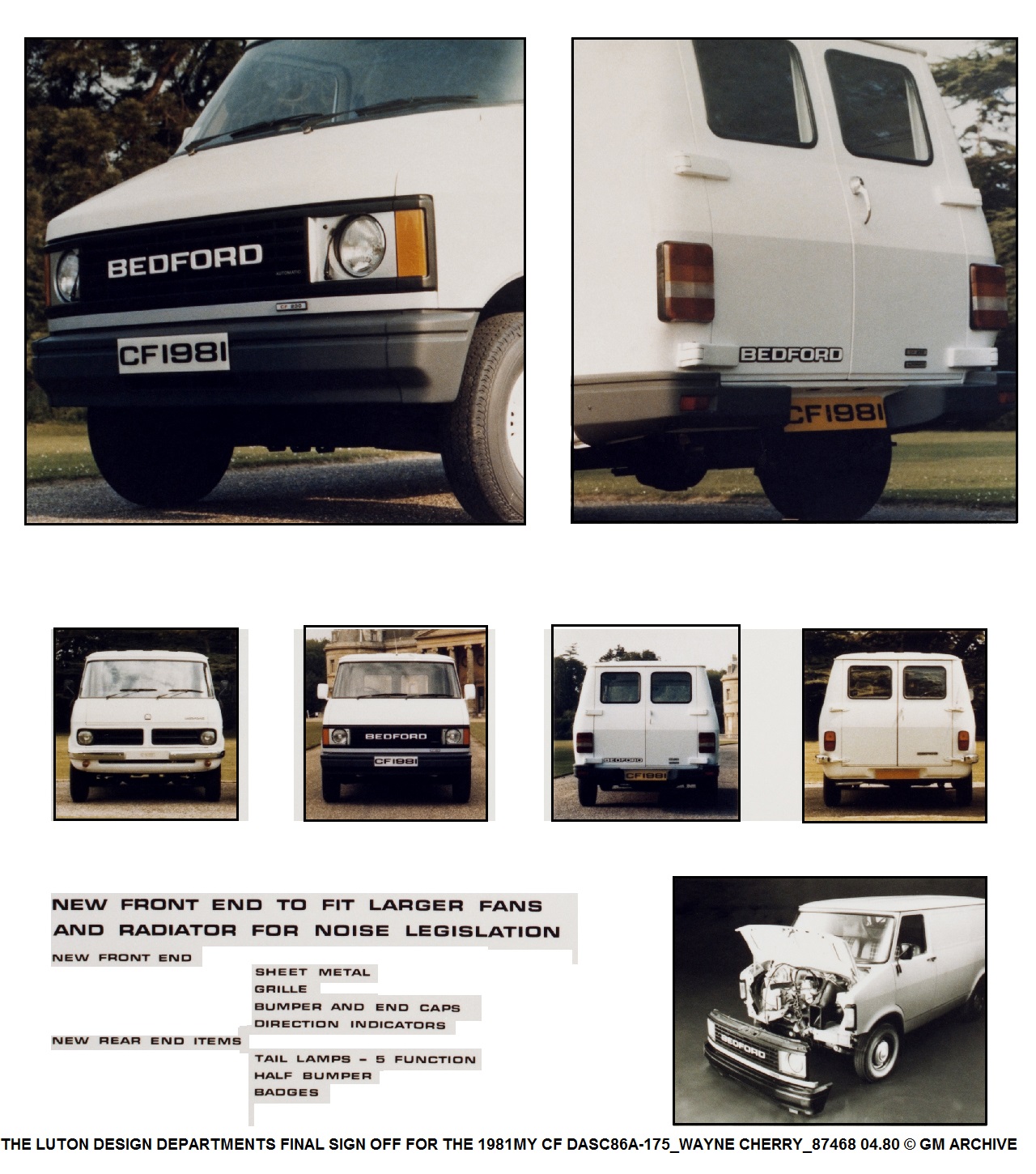
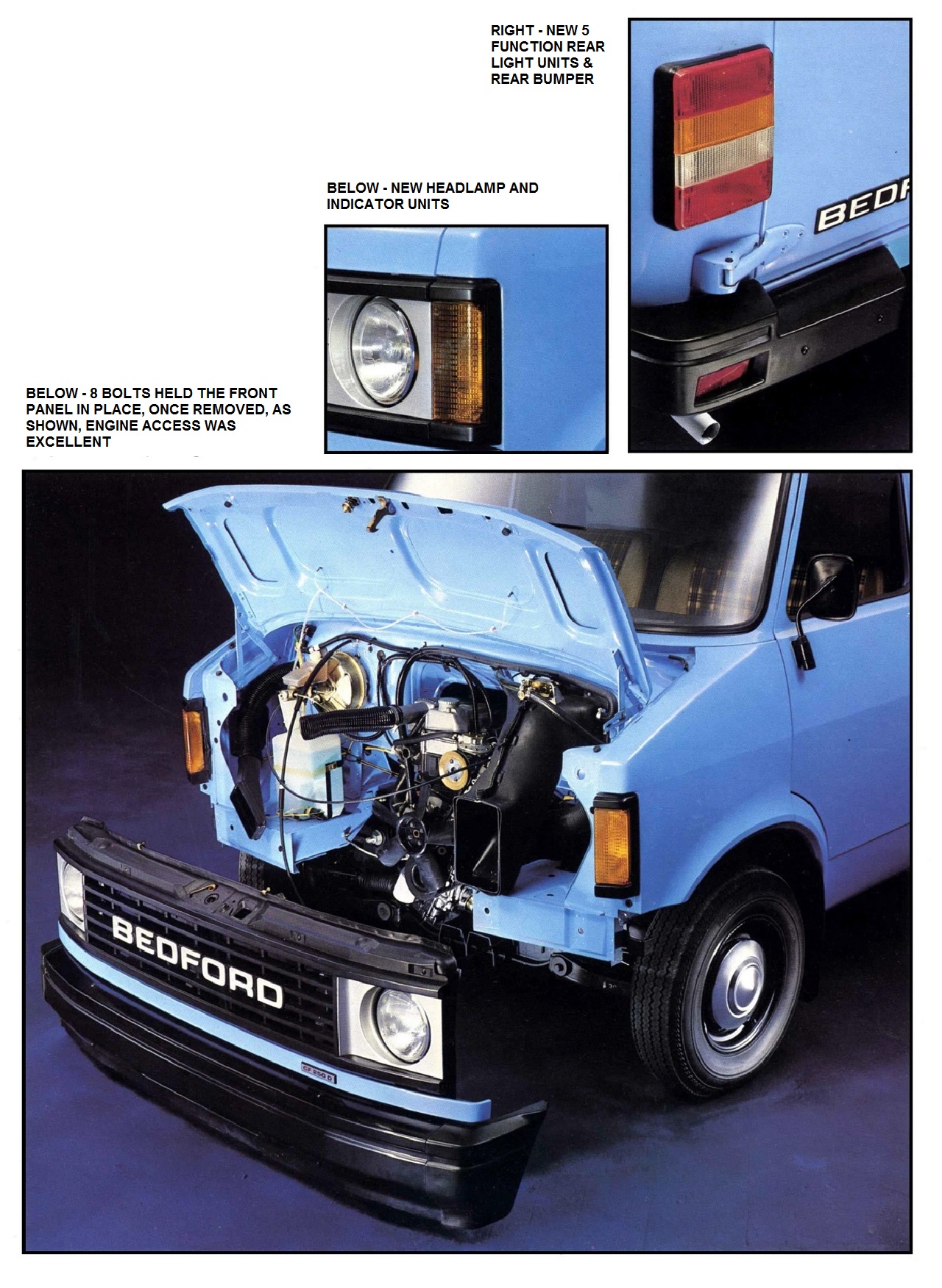
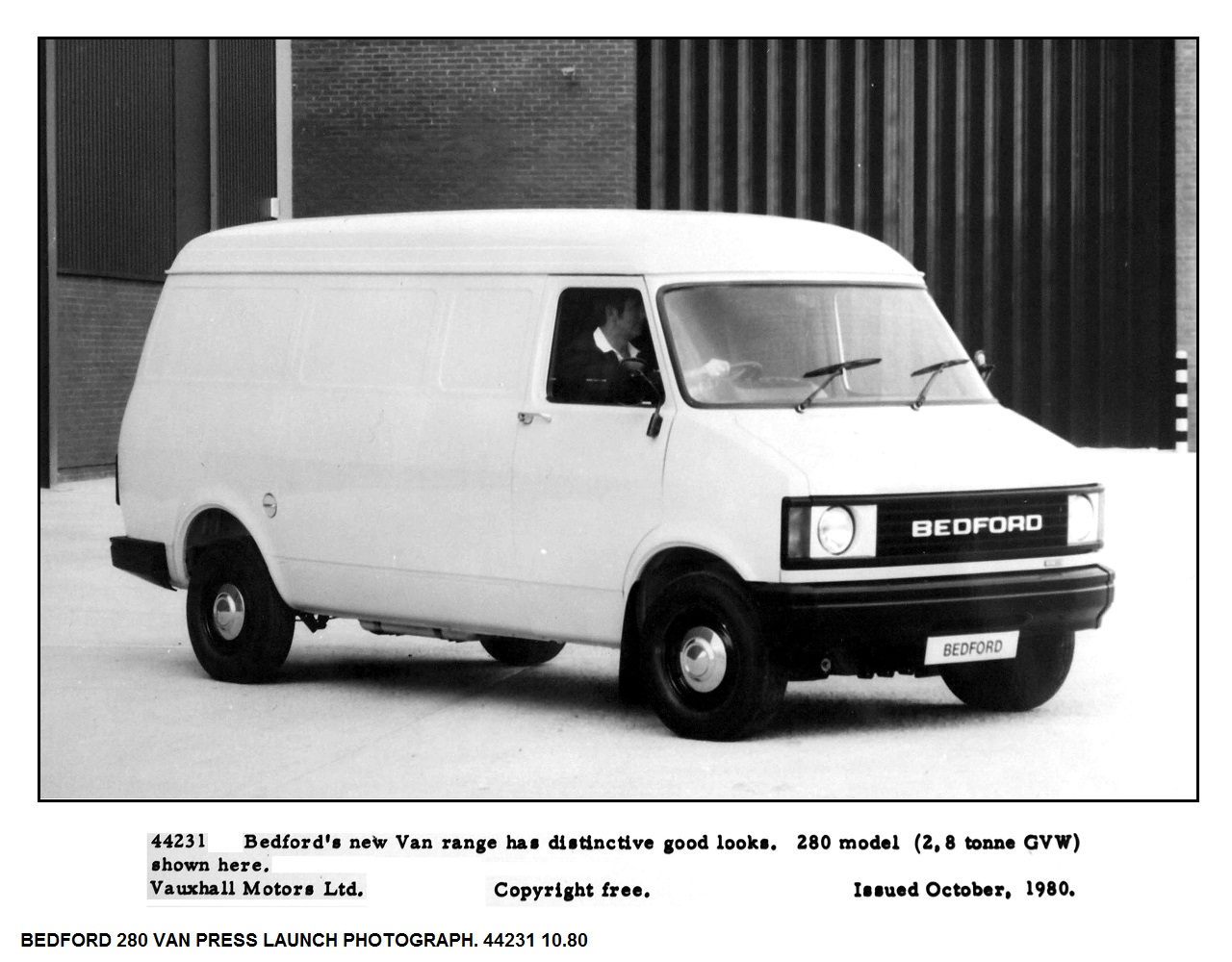
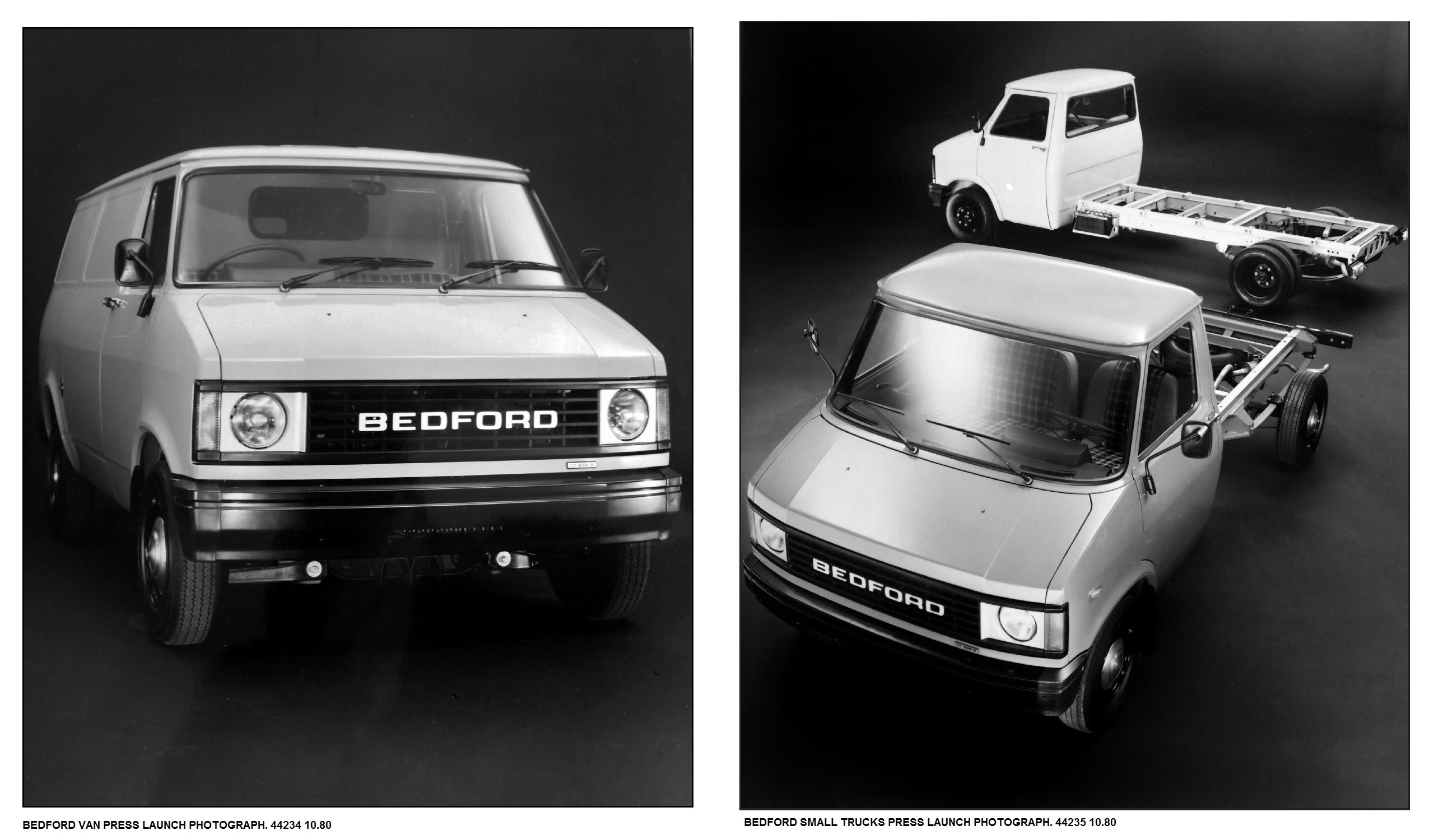
No changes were made to the 1982 model year specifications apart from the CF name was re-introduced following pressure from dealers but a new model was added – the Bedford CF 4 X 4. This was a joint collaboration between Vauxhall Motors and FF Developments and was a conversion available on all 250, 280 & 350 fitted with the 2.3litre 80P engine and could be had with 4 or 5 speed ZF manual or GM 3 speed automatic gearboxes.
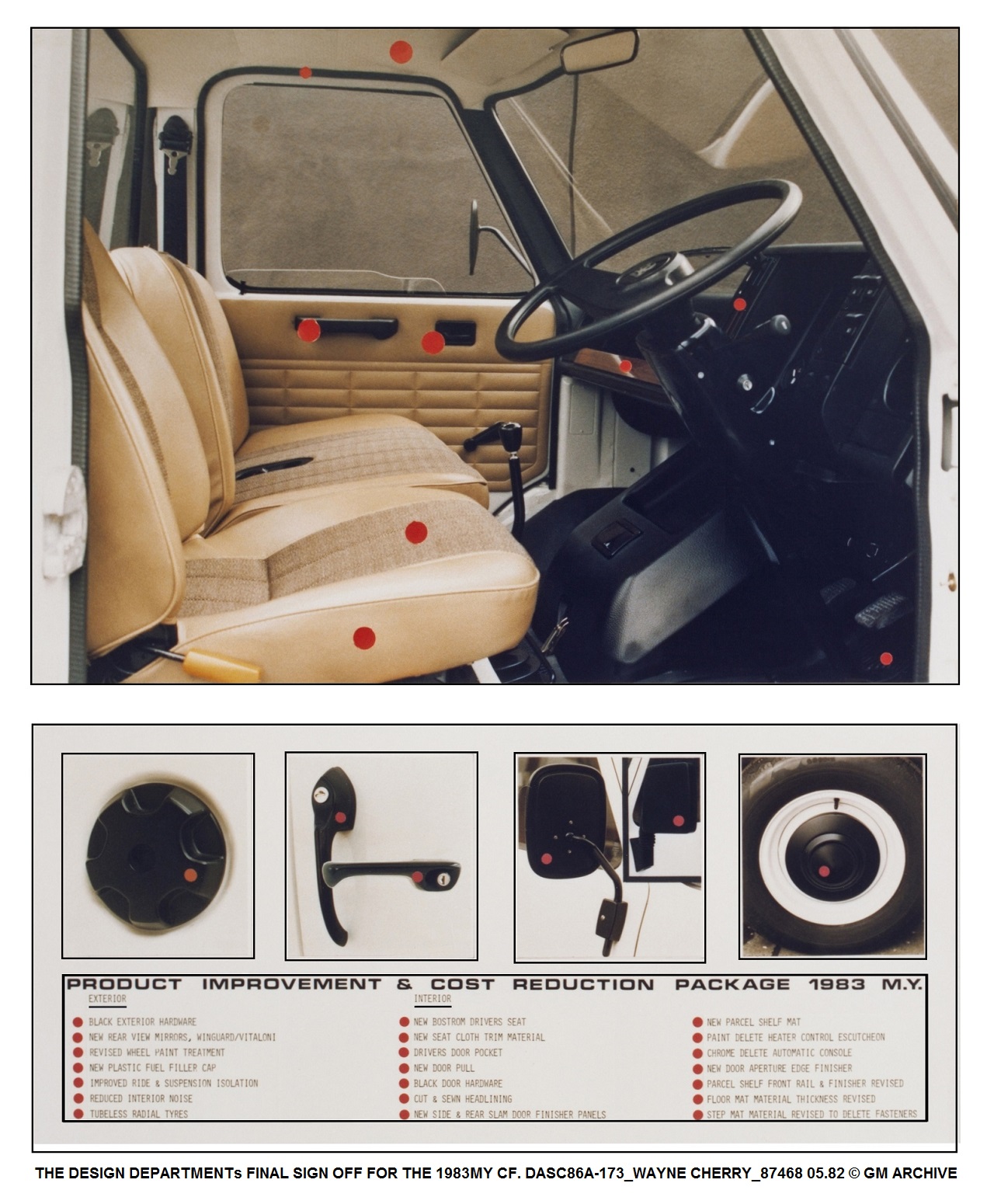
The Bedford CF models for the 1983 model year are generally acknowledged by CF enthusiasts to be the best of any production year. The Design Department at Luton were tasked with making some worthwhile improvements whilst making cost savings to counter the additional expense whilst the Engineering Department needed to cope with new noise legislation that required a 33% reduction in cab noise and led to some strange changes to achieve the required level. 1983 would, alas, be the last year of production for the 1.8 & 2.3litre slant four OHC engines. Never the quietest of engines the Bedford Engineers established that much of the mechanical clatter came from the top of the engine and so a rocker cover was fitted with sound deadening pads glued on the outside and then sprayed silver, sounds bizarre but it was particularly effective. On the underside of the cab each square metre was coated with 2.25kg of baked on bituminous compound. The rear springs used revised mountings, engine & driveline mountings were revised in order to isolate noise & vibration. All the OHC petrol engines were now fitted with Bosch electronic ignition, something that is now much sought after by anyone with any slant four engine vehicle. The choice of engine & gearbox remained as before except the automatic option on CF350 & CF350/L with the 60D engine was dropped completely. Tyres were tubeless radials as standard for all models. Interior and exterior changes were signed off by the Design Department in May 1982. All exterior fitments were now black including a plastic fuel filler cap, black Winguard rear view mirrors (replaced by Vitaloni black plastic replacements didn’t become available in production until early in 1983), wheels were painted white with black hub caps on CF230 & CF250 models and all door handles were black in place of chrome. Inside the CF cab featured a new Donegal tweed trim and as standard a new Bostrom driver’s seat, new driver door pocket, new style door pulls & handles and also new cut & sewn headlining, new side & rear slam door tri panels, a parcel shelf mat, new door aperture finishing and a thicker moulded floor mat. All the changes combined meant the CF was still more than a match for any van on the market at the time. The last change prior to the launch of the CF2 models was the introduction of the CF230 Fleet Van in January 1984, this was only available with the 65P engine, no hub caps & vinyl trim and offered at a special low price. In reality it was to us up the large factory inventory of 1759cc engines but ironically it proved to be a sales success and was included in the CF2 range from the start.
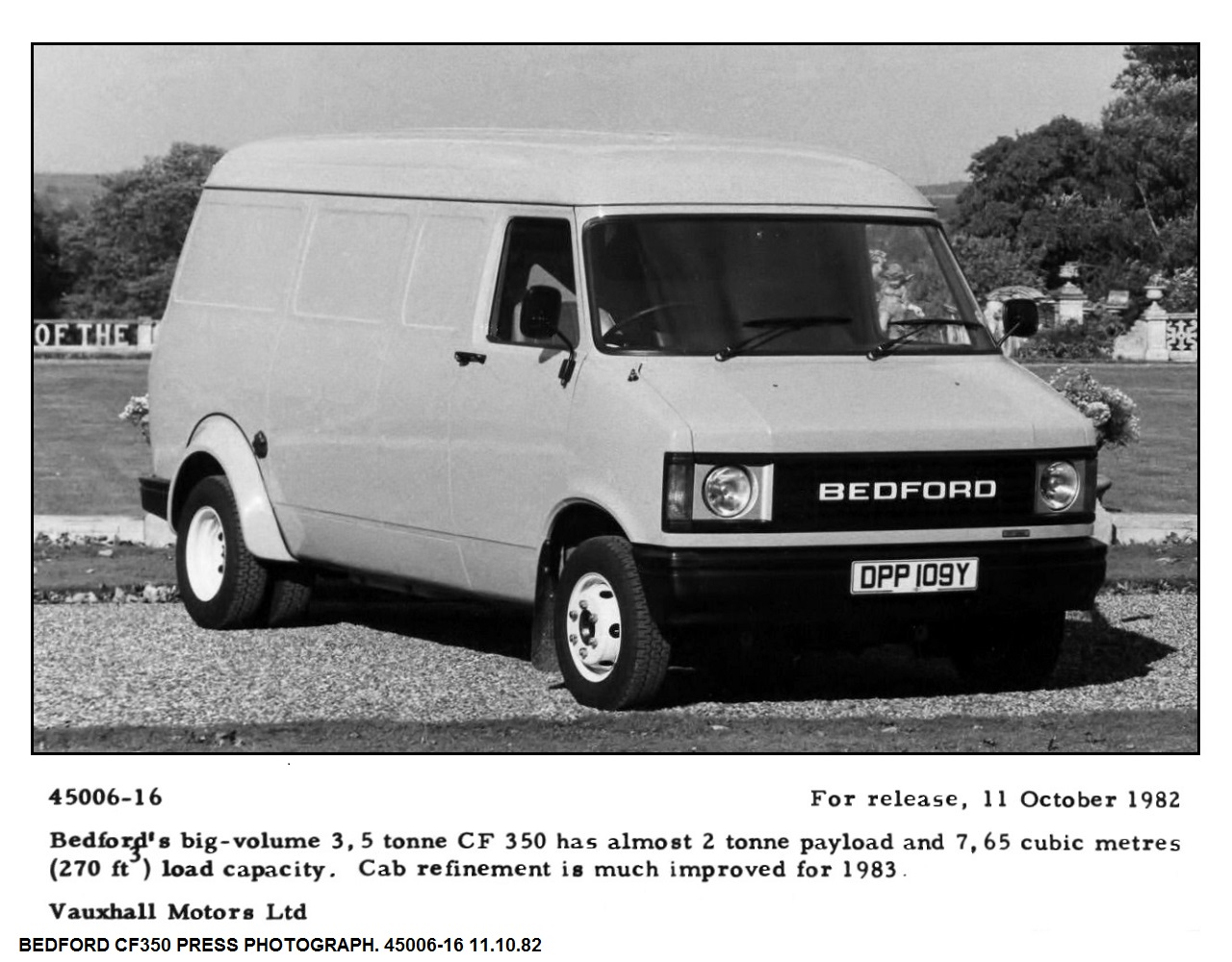
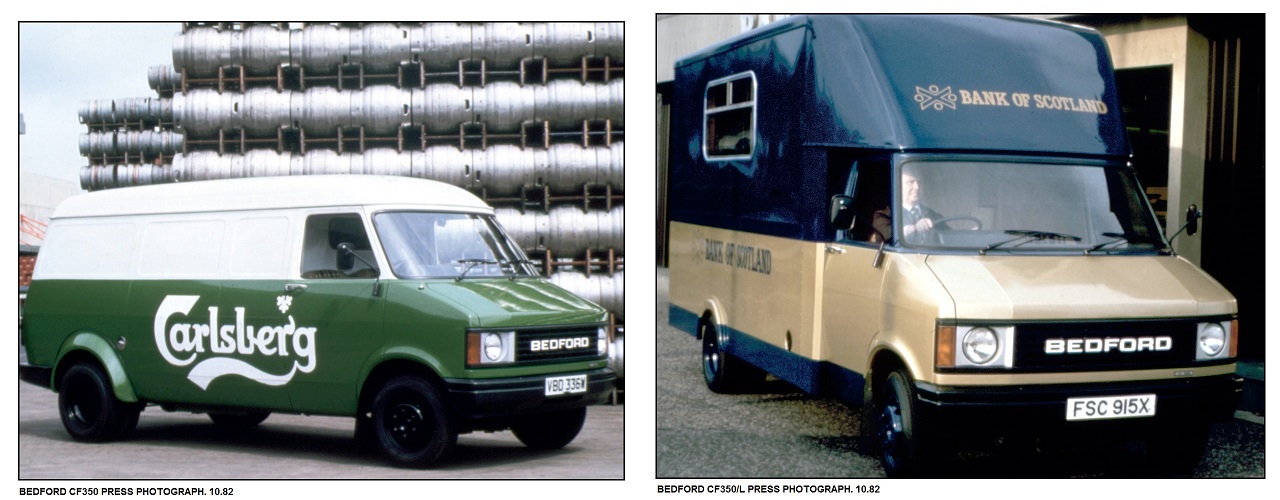
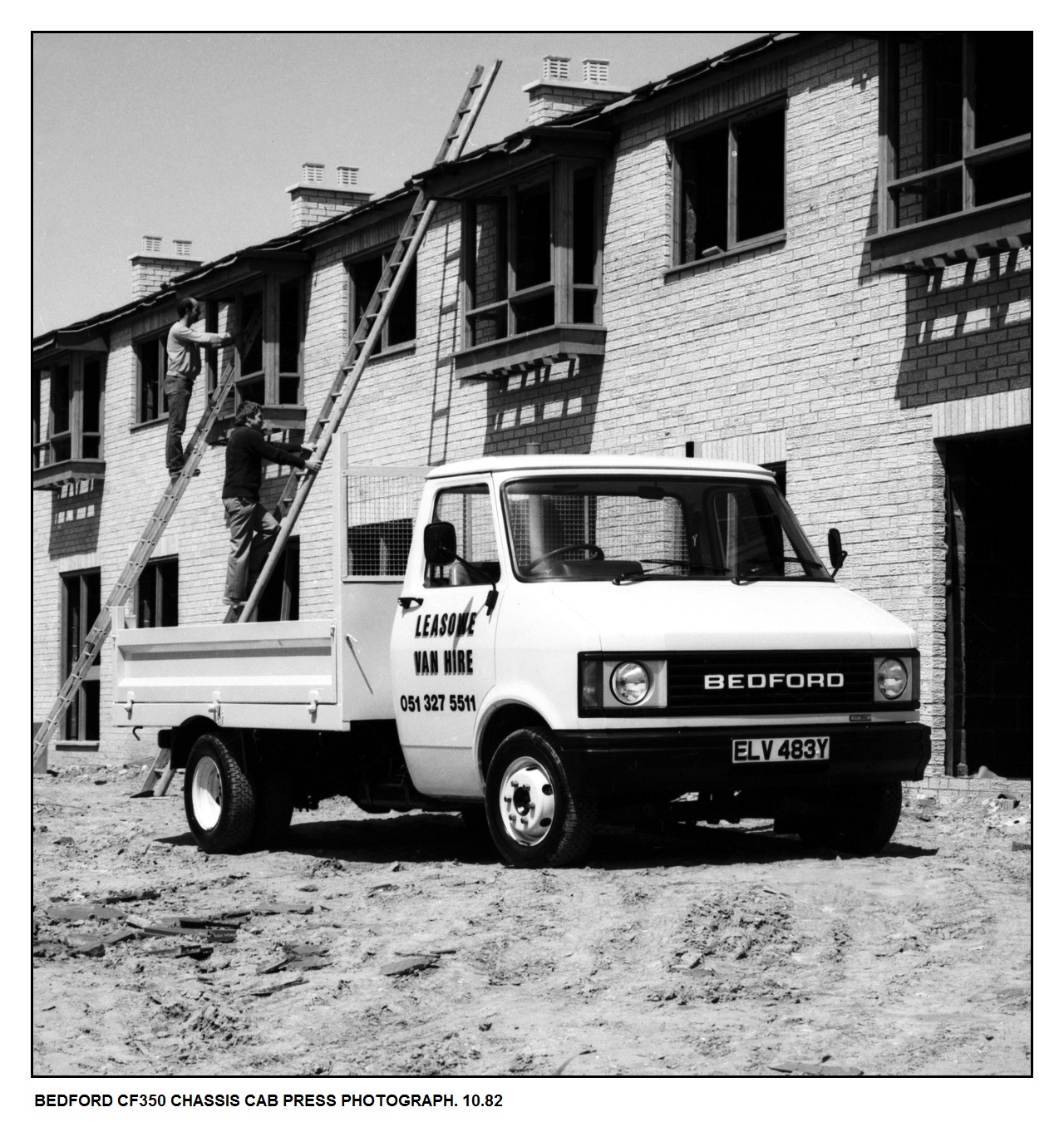
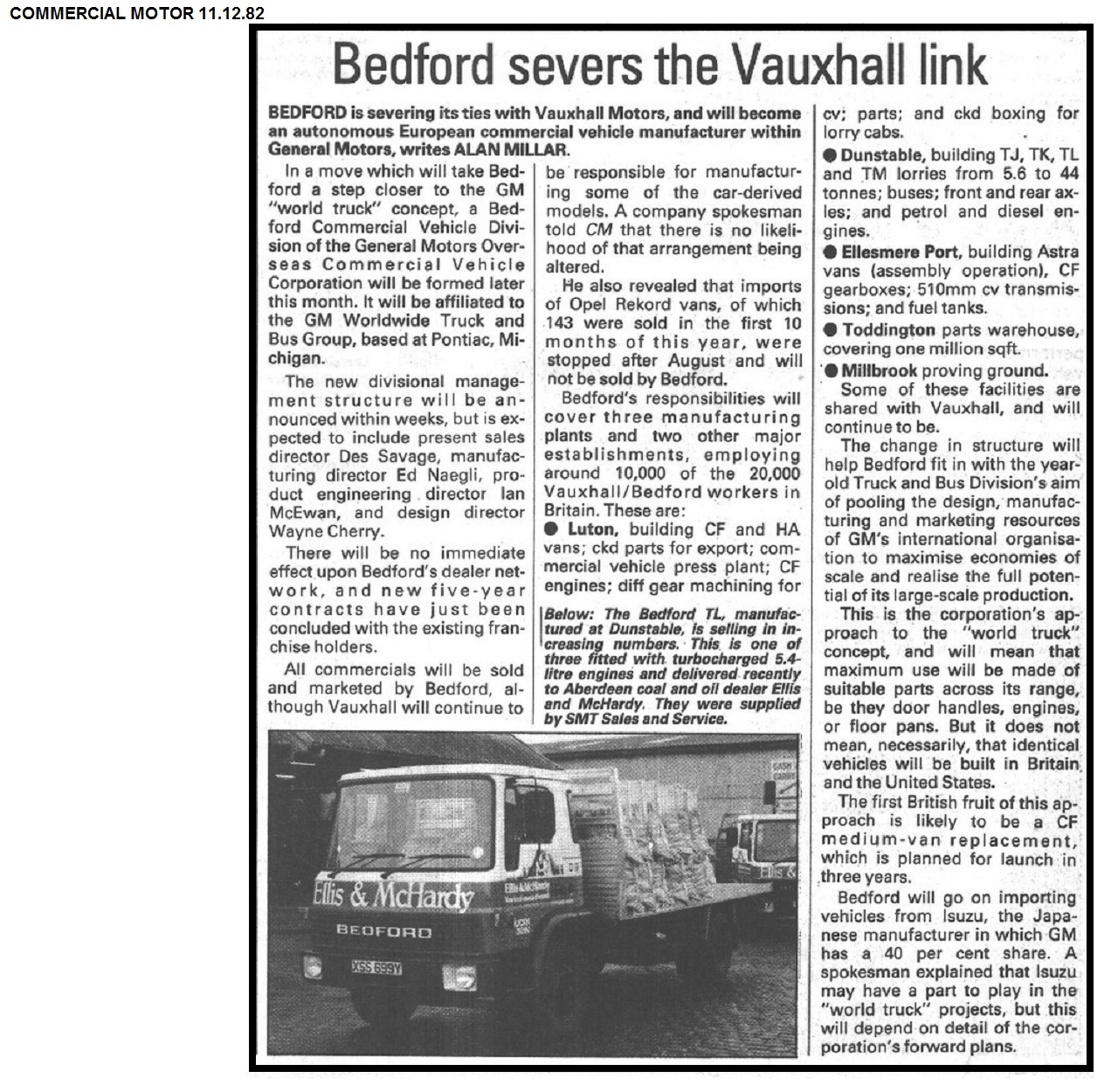
7. BEDFORD 97000 - CF2:

By 1983 the Bedford CF had been in production for 14 years and despite some very clever and worthwhile updates was starting to be outclassed by more modern rivals, particularly as regards routine maintenance, just changing the plugs was a bitch of a job on the slant four petrol engine, and also the build quality was falling below what the market now expected even in a commercial vehicle. Early in 1983 Bedford was split from Vauxhall Motors Ltd and became part of the General Motors Overseas Commercial Vehicle Corporation which in turn was a division of GM Truck & Bus Group. The Luton van plant that produced the Bedford CF needed new investment and this came in 1983 with a £50m upgrade to the plant and included new automated and computerised production line facilities as well a new paint shop.
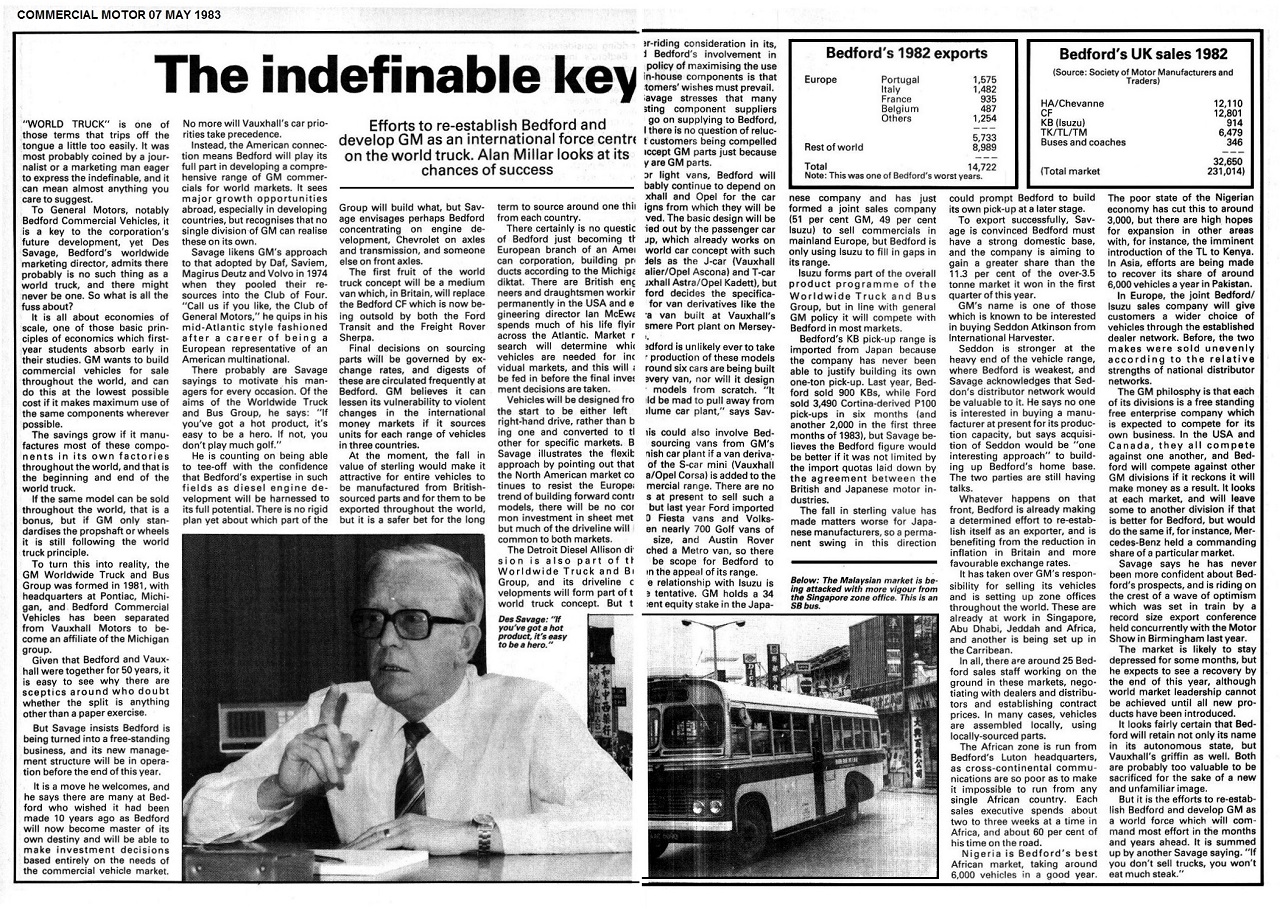
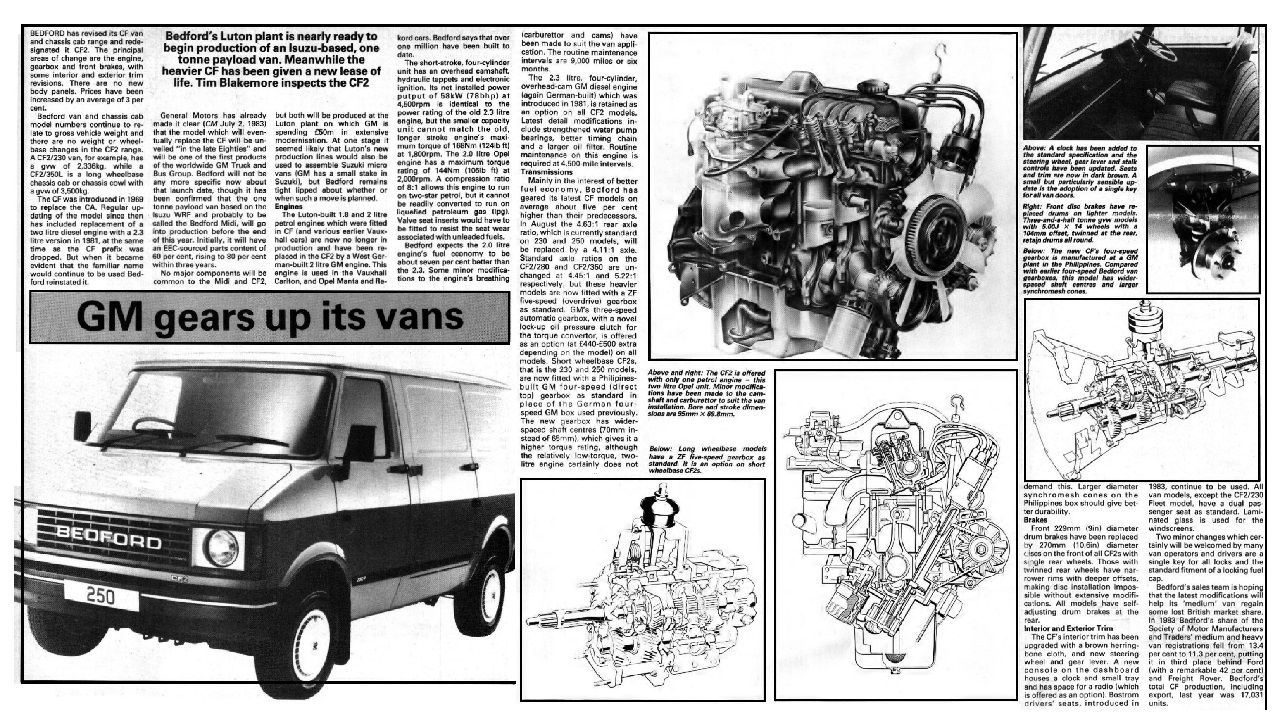
The first product of this investment was the launch of the CF2 for the 1984.5 model year, although it was announced to the commercial press in June 1983 sales didn’t start until May 1984. Planning for the CF2 had started by Design Team early in 1982 as Project PP3229 with other associated departments involved from September 1982. The engine choice was made when the decision to end the 1759cc & 2279cc engine production was taken and which also coincided with a big drop in demand for the Opel CIH engine because the new Vauxhall Cavalier MK2 & Opel Ascona C used a new range of OHC engines. The design changes of the CF2 were all done at the Luton Design Department but the engineering changes necessary for the CIH engine, new gearbox and brakes were done by Opel in Russelsheim with prototype and D.O.T Type Approval testing done by Bedford engineers working at Millbrook.
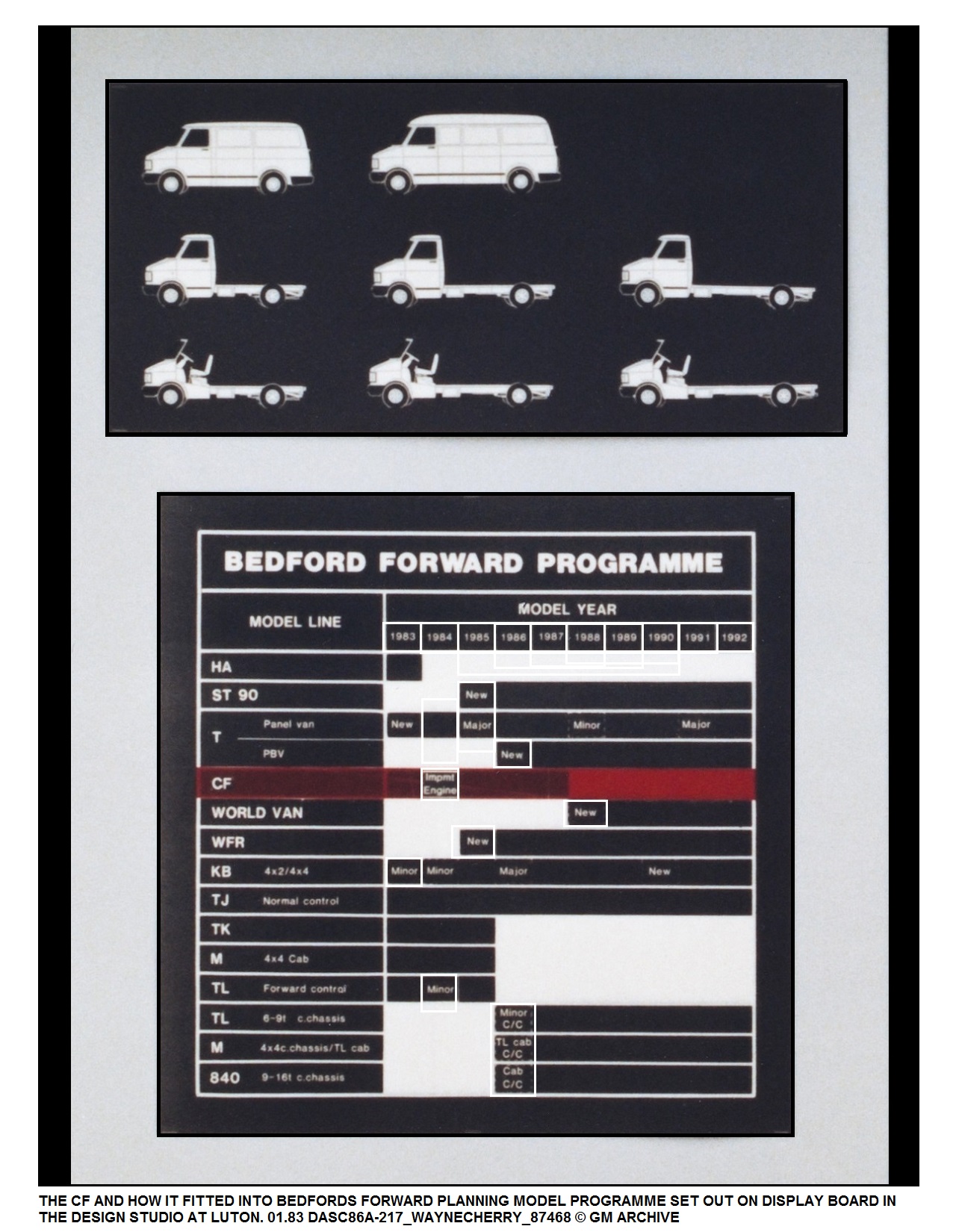

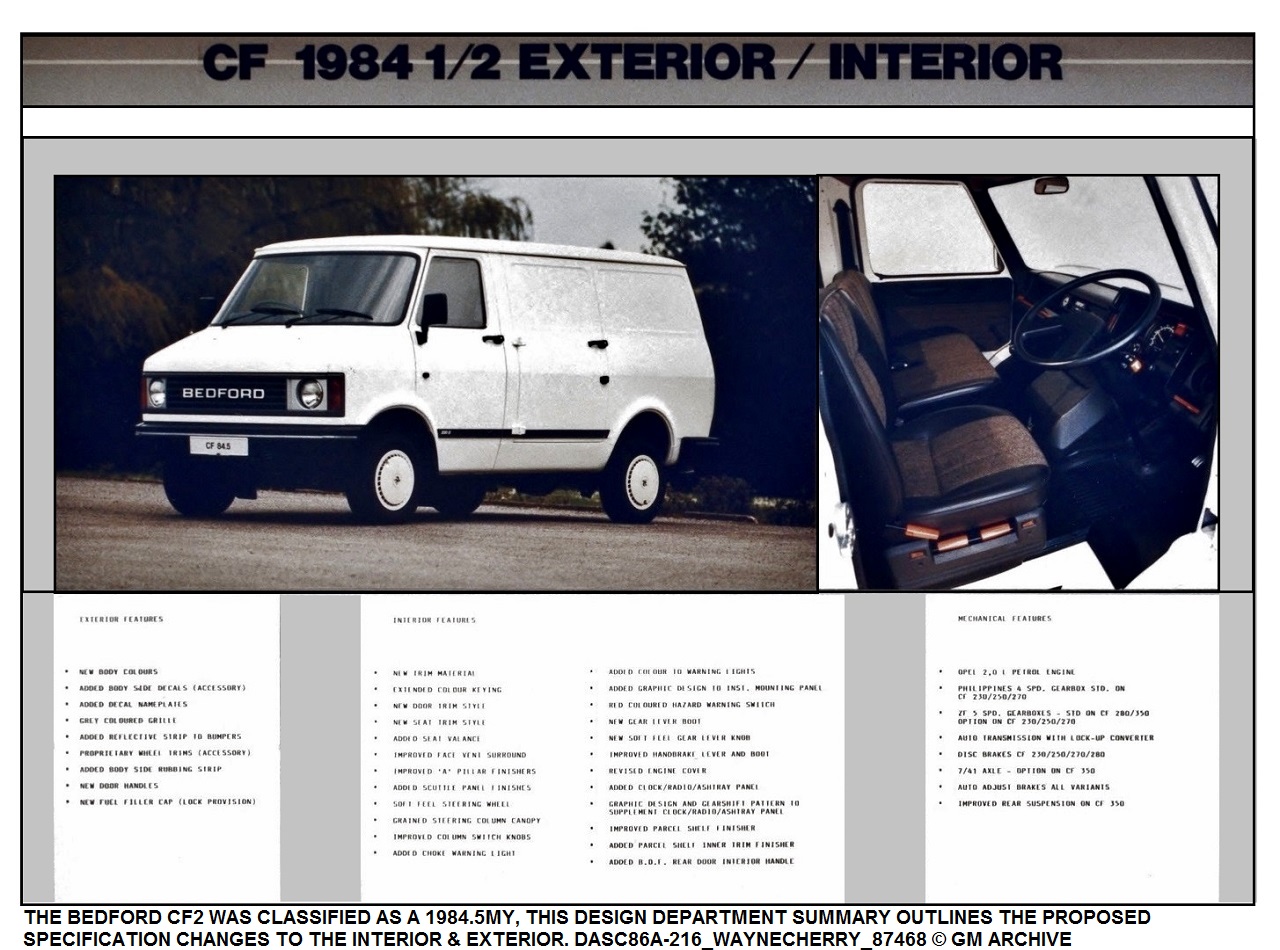
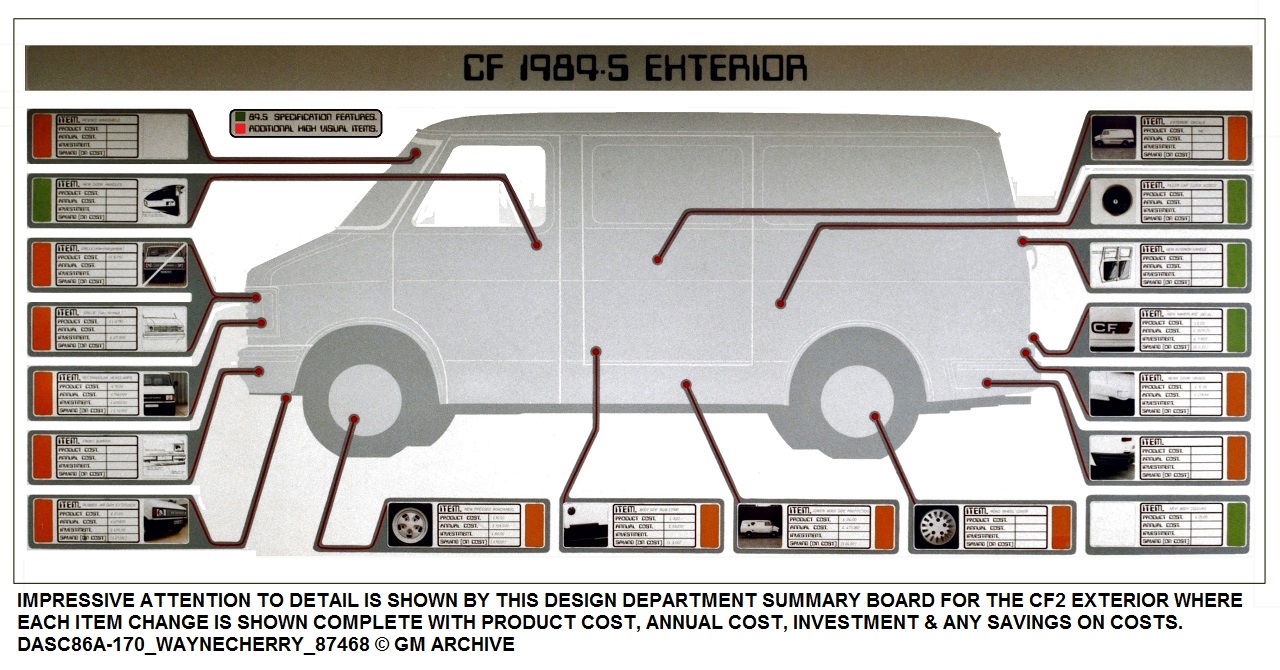
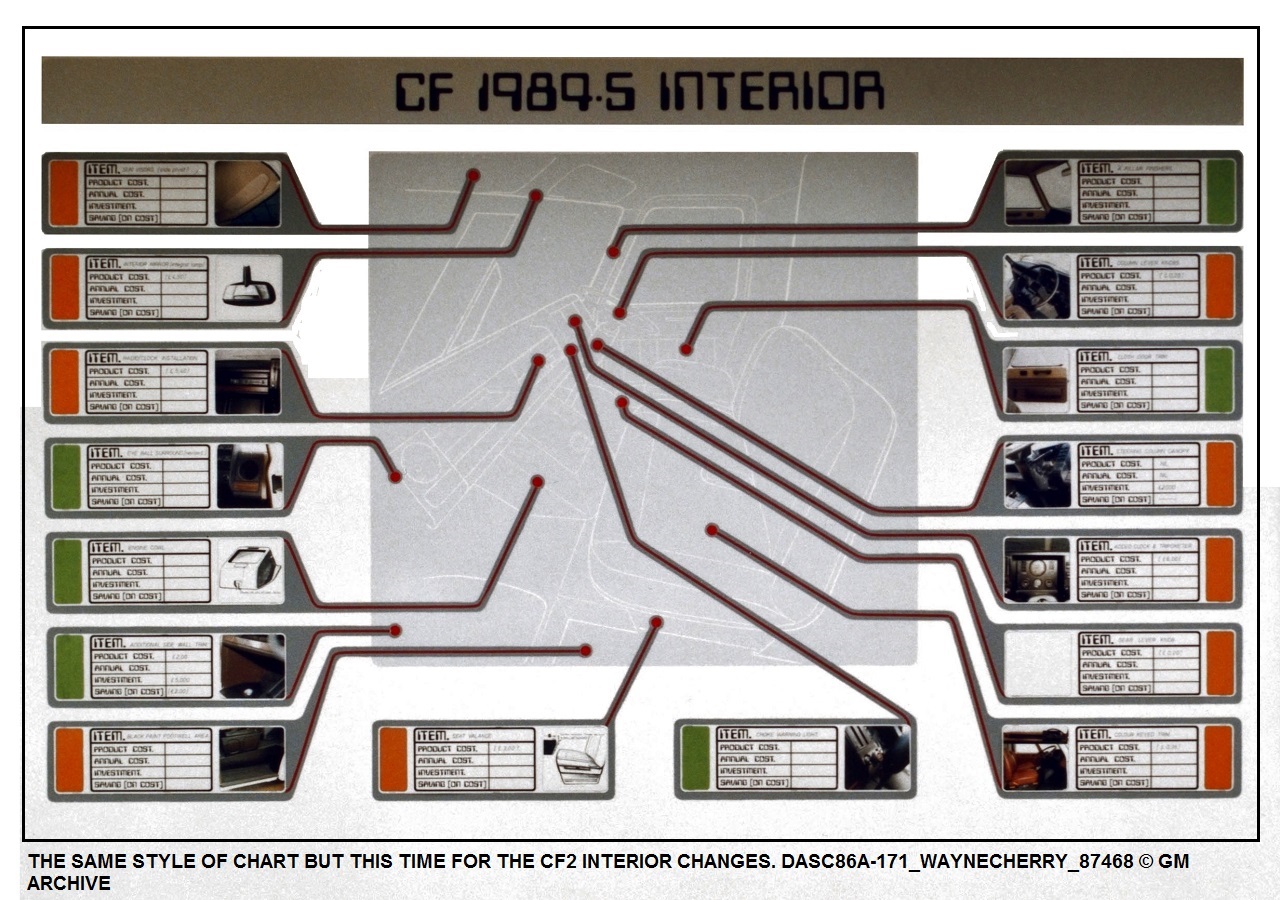
With the exterior changes that would be made to the Bedford CF for the 1983MY the Designers at Luton were starting to run out of different ways to make the CF look different to its predecessors and to give a recognisable and fresh look for the proposed CF2 for the 1984.5 model year. The start was the availability of a new range of body colours, but this ended up being limited to the addition of just 2 new paint finishes – Slate Green & Grey Stone. The front grille was dark grey instead of black, with a tiny “Automatic” badge on relevant models, and the bumpers were fitted with a bright decorative strip. More noticeable was a full length side rubbing strip with a model ID badge on the front end, redesigned black door handles and a new style locking fuel cap. On the CF2 250 the standard black hub caps could be replaced by the optional full cover wheel trims which were the same design as those used on lower priced versions of the Vauxhall Astra MK2. In addition to the standard “CF2” stick on decals there was also, for the first time on a Bedford Van, the option of body side decals which was unusual for any commercial van at the time. The choice of door combinations remained the same as before as well as the multitude of different bodies, however the rear doors could now be slammed shut and more useful one key fitted all locks including doors, ignition and the fuel filler cap. A feature first seen on the 1981MY facelift CF was the removable front end - for major engine work - and this feature was carried over to the CF2. The 8 bolts holding the front in place could be removed in 15 minutes. Day to day and routine maintenance was aided by the fact all the engines fitted were upright in design and was better than the slant four engine models. The choice of access was from either inside by removing the engine cover or the normal under bonnet area.
The CF had gained an average reputation for rust protection and
paint quality, but the new automated paint shop in the Luton van
plant was state of the art at the time and ensured the finish of
the CF2 was a quantum leap over the what had gone before. The
anti-corrosion protection included zinc coating of the whole front
end, sills, rear lower panel and most of the door panels as well as
reducing areas where salt laden mud and water could collect. As an
added protector weld sealer cream was applied to the joints of the
floor pan, wheel arch joints and body side panels. Zinc rich
primers went into the cant rails and outer edges of the roof
panels. Prior to painting an 8 stage cleaning process was carried
out, after an alkali clean the body was given 2 warm water rinses
before a zinc phosphate coat was applied. Then a chromic rinse, 2
cold water rinses and finally a demineralised water rinse. The body
was then dipped to waist level in epoxy based primer which was then
stove baked at 170 degrees C. Following this all body joints were
sealed with Plastisol sealer prior to the entire body being sprayed
with an epoxy based primer which was then stove baked at 164
degrees C. To protect the underside and wheel arches 2.5kg of
bituminous sealer deadener was applied to each square metre (except
Fleet models). After underbody sealing, all chassis box sections
were injected with wax compound and then, finally, the colour coats
of cellulose synthetic enamel were baked on. The last stage was to
spray all the door interiors, the front section of the bonnet and
the whole underside of the body with a wax coating. If the
exterior alterations to the Bedford CF2 seemed a little tame the
mechanical changes underneath certainly made up for it with a whole
raft of changes which qualified as a comprehensive overhaul,
although not everything was necessarily an improvement compared to
the previous model.

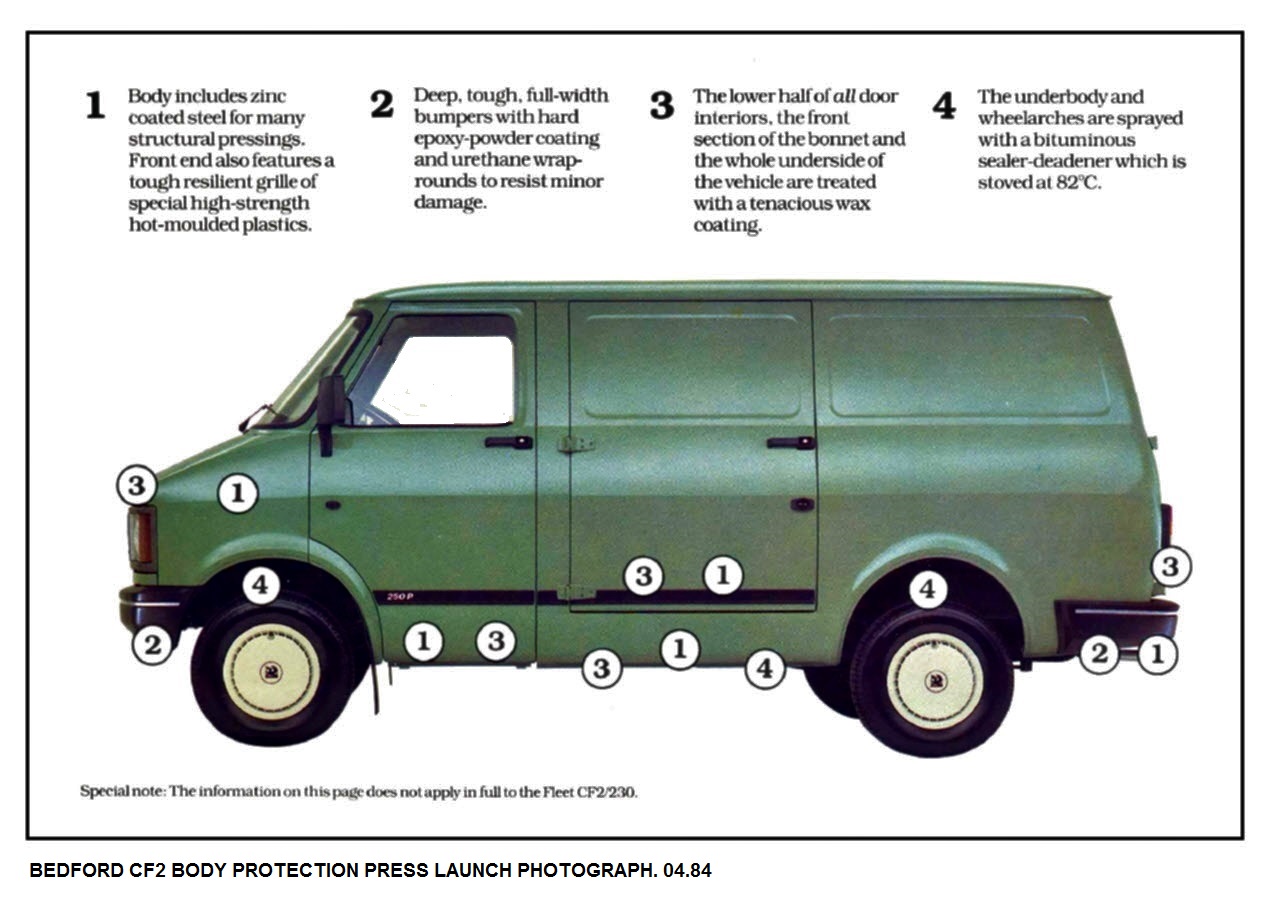
If the exterior alterations to the Bedford CF2 seemed a little tame the mechanical changes underneath certainly made up for it with a whole raft of changes which qualified as a comprehensive overhaul, although not everything was necessarily an improvement compared to the previous model. With the demise of slant four OHC engine production at Luton, and the reduction in the number of Vauxhall & Opel cars using the 4cylinder Opel Cam-In-Head power unit, it made financial & production sense to utilise it as the replacement engine in the CF2. The 1979cc CIH was specifically tuned by Opel engineers for its application in the CF2; the compression ratio was lowered to 8.0:1 in order to run on 2-star fuel, essential in the UK, a re-profiled slightly lower lift camshaft fitted, a Weber 34ICT carburettor with manual choke and a viscous drive cooling fan were all the main changes. The engine produced the same 78bhp @ 4500rpm (net) as the previous 2.3 unit and was given the same engine code – 80P. Bedford claimed at launch a 7% improvement in fuel consumption compared to the previous smaller 1.8litre 65P engine. The new engine was also quieter, aided by hydraulic tappets, and because it was upright in design it was easier to work on. Maintenance was reduced with no initial 600-mile service required and regular service intervals of 9,000 miles (3,000 more than before) or every 6 months. It would, in theory, also prove more acceptable in Bedford’s European export markets because of its wide use in Opel cars. It also did not leak oil, a speciality of the slant four engine, although to be fair it was normally because of over tightening of rocker gasket bolts that caused it. However, the CIH engine did have one major disadvantage compared to the previous 2.3 80P engine – it was gutless, especially when fully loaded. Torque output was 106ft.lbs @ 2,000rpm compared to 124ft.lbs @ 1,800rpm for the 2.3 with an almost flat torque curve, this put off many van drivers and operators in the UK who were used to the huge pulling power of the previous CF engines. It was also claimed that the CIH was an "advanced" engine, in actual fact it was an older design than the unit it replaced and wasn’t even a proper OHC engine.
The CF2 2.3litre diesel engine (60D) was carried over from the previous CF with the addition of a viscous drive cooling fan, strengthened water pump, stronger timing chain & larger oil filter. The power output remained unchanged at 61bhp @ 4000rpm and 93.7ft.lbs @ 2500rpm, as before a 61bhp 2.1litre, 60bhp 2.0litre & 59bhp 1.9litre versions were still available for certain export markets where engine capacity taxation was a deciding purchasing factor. Past experience had shown that the unit was reliable if not particularly fast. The engine featured high durability duplex chain drive for the camshaft running inside an aluminium cover aiding quiet running. It also featured a fuel enrichment control for first time starting after 8 seconds which was how long the new glow plugs took to warm up. The fuel pump governor was also progressive above 4,000rpm helping to prevent the traditional "brick wall" cut off suffered by other diesel engines at the time as they reached their rev limit. The diesel models accounted for 60% of all CF2 production.
In 1985 a special ambulance specification was available with a
3.3litre petrol engine from Holden in Australia and was only
available with GM Tri-matic Automatic transmission, this was in
response to the 3.0litre V6 Transit and 3.5litre V8 Leyland Sherpa
being offered for ambulance use.
The number of available transmissions was simplified
on the CF2, however, it is not widely known the standard GM 4speed
manual gearbox fitted to SWB models was in fact a new design and
imported fully assembled from the Philippines. When fitted to the
CF2 230 Fleet & CF2 250 the ratios were as follows: 3.99:1 –
2.16:1 – 1.38:1 – 1.0:1 – Reverse 4.03:1. CF2 LWB models were
fitted as standard with the heavy duty ZF 5speed gearbox and was
also offered as an optional extra on CF2 250 models. When fitted to
the CF2 280 & CF2 350 the ratios were as follows: 4.69:1 –
2.51:1 – 1.48:1 – 1.0:1 – 081:1 – Reverse 4.03:1. When fitted to
the CF2 250 models the ratios were: 3.92:1 – 2.19:1 – 1.43:1 –
1.0:1 – 081:1 – Reverse 4.03:1. The GM 3speed Automatic now
featured a torque converter lock up to aid fuel economy and
eliminate slip at high speeds was an option on all CF2 Petrol
models and CF2 250 & CF2 280 Diesel, the ratios for all
applications were as follows: 2.40:1 – 1.48:1 – 1.0:1 – Reverse
1.92:1. The standard CF2 rear axle ratios were 4.11:1 for CF2 230
Fleet & CF2 250 models with a 4.62:1 optional, for CF2 280
& 350 Petrol & 280 Diesel models the ratio was 4.45:1 with
5.22: optional and 5.22:1 standard for CF2 350 Diesel models with a
5.86:1 optional. For the CF2 350/L Chassis Cab used a 5.13:1 ratio
as standard with a 5.875:1 ratio
optional.
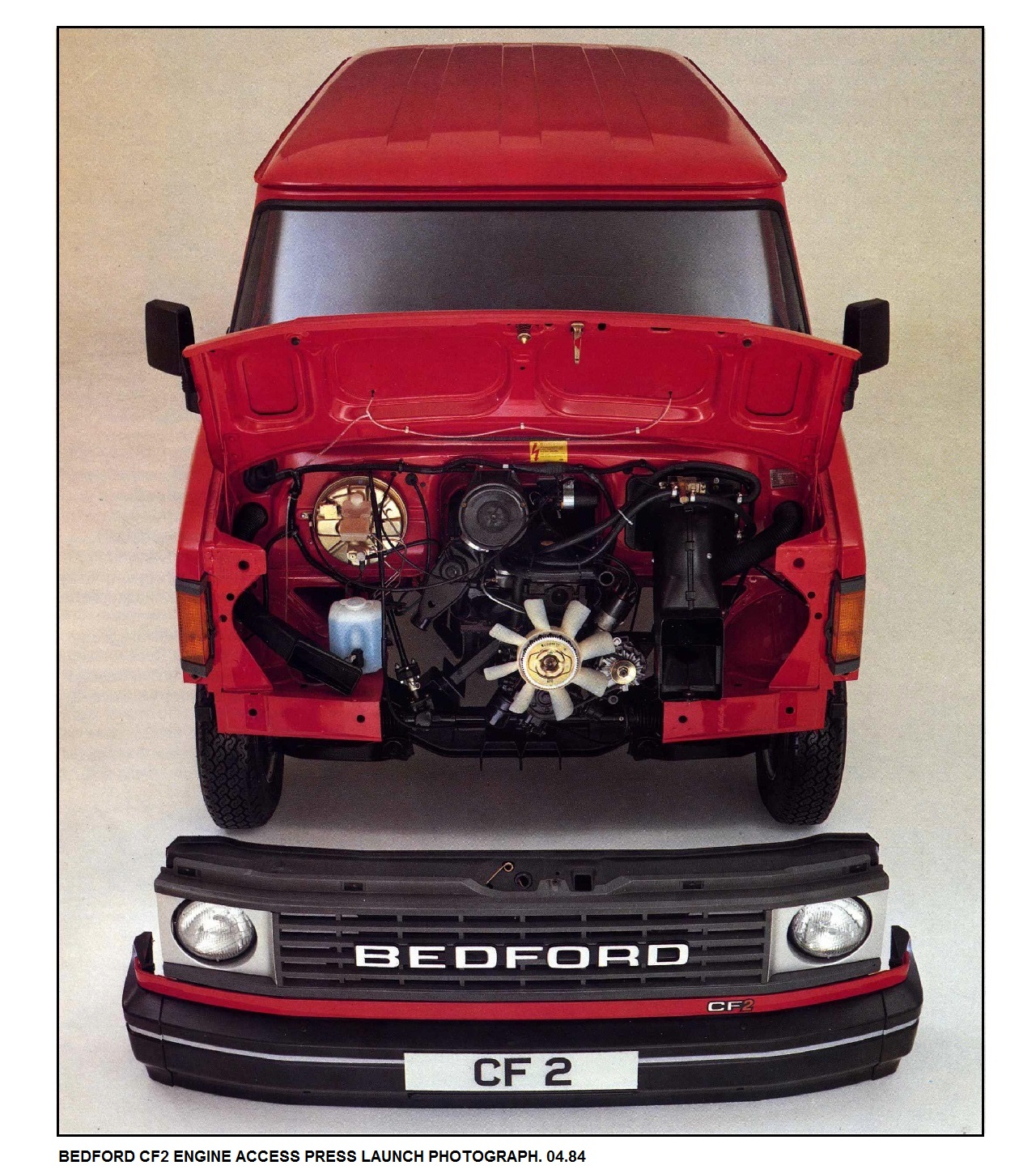
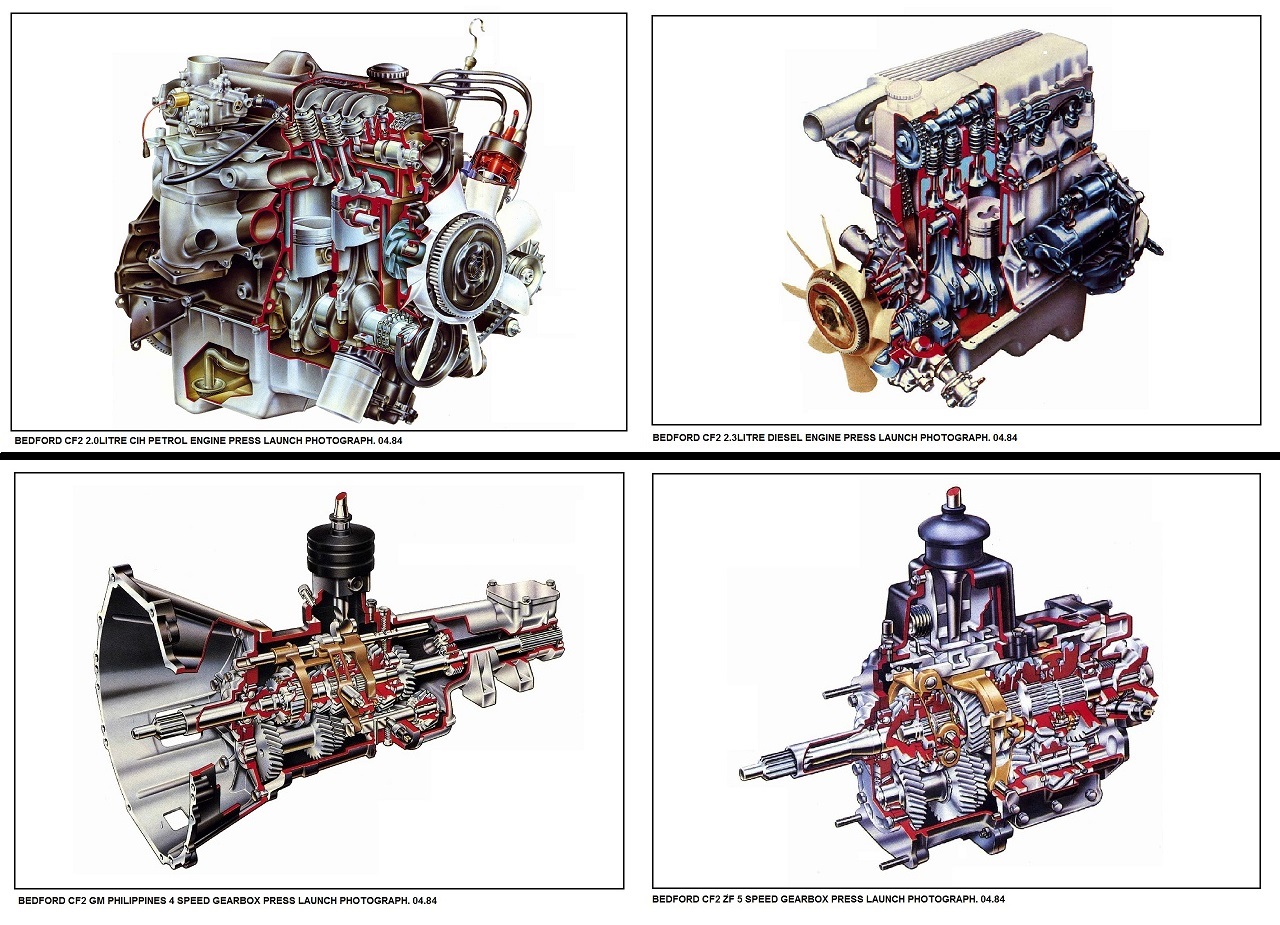
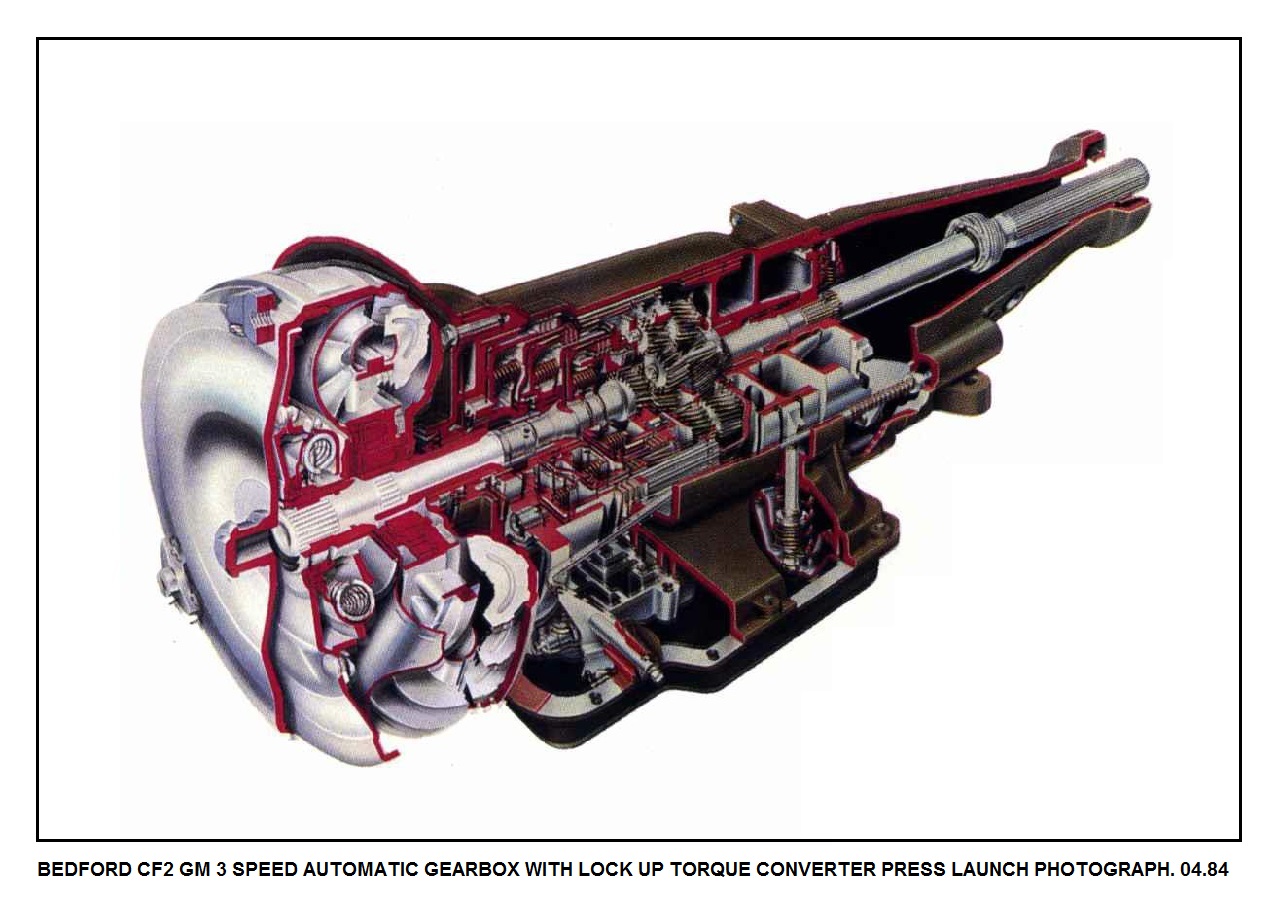
The CF2 retained the previous models dual-circuit, servo assisted, hydraulic braking system but was enhanced on CF2 Fleet 230, CF2 250 and CF2 280 models with the addition of front disc brakes along with self-adjusting rear drum brakes. The twin wheel 350 and 350L models retained drum brakes all round but they were now self-adjusting. All CF2 models were fitted with a brake load sensing valve built into the braking system. The CF2, as before, used rack and pinion steering and, combined with IFS, made it one of the best handling vans on the market and was light years ahead of the upcoming Bedford Midi.
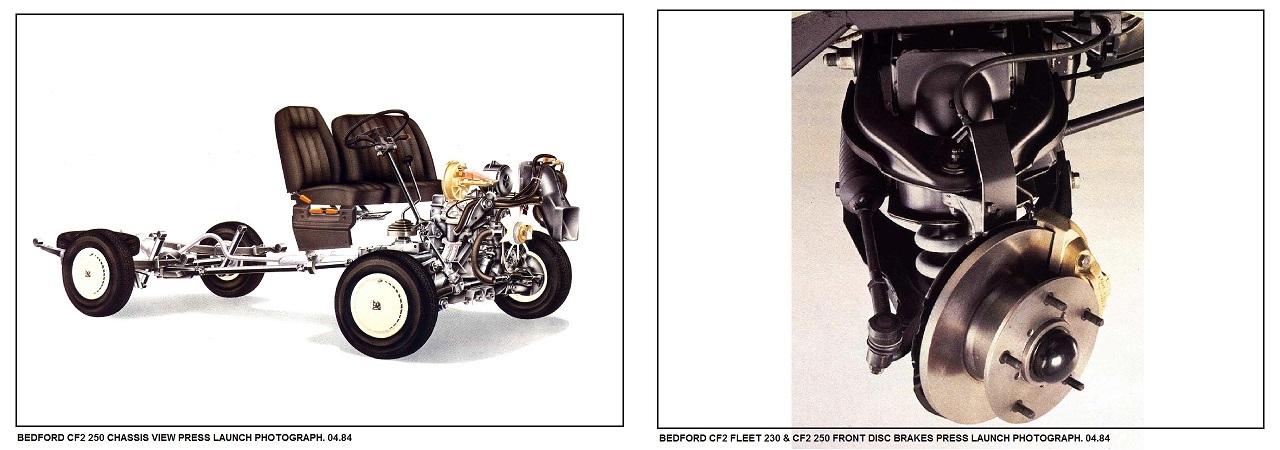
The rear suspension on single wheel CF2 models continued to use multi-leaf variable rate springs with revised damper settings carefully matched to the oscillating frequency of the springs to ensure control of the axle over all types of road surface. The twin rear wheel CF2 models used single tapered leaf springs on 350 and double on 350/L models, larger diameter rubber bushed eyes were added to give an improved noise isolation.

The interior of the CF2 Cab used the 1983MY as a starting point and refined & added to the basic design which was in any event excellent. There was new seat & door design with trim in Herringbone cloth, the seats now had full cover lower valence, new air vent trim, new A pillar trim, added scuttle panel finishers, a new design of soft feel steering wheel, grained steering column canopy, new improved design steering column stalks, redesigned engine cover, a choke warning light, a new graphic design for the instrument mounting plate, the hazard light switch was now red, new soft feel gear lever knob, redesigned handbrake lever & cover, greater colour keying of trim, quartz clock, cigarette lighter, provision for DIN radio fitment, beige headlining, twin sun visors and parcel shelf graphic stripes with the CF2 logo. The lower price Fleet model had less equipment and vinyl seating.
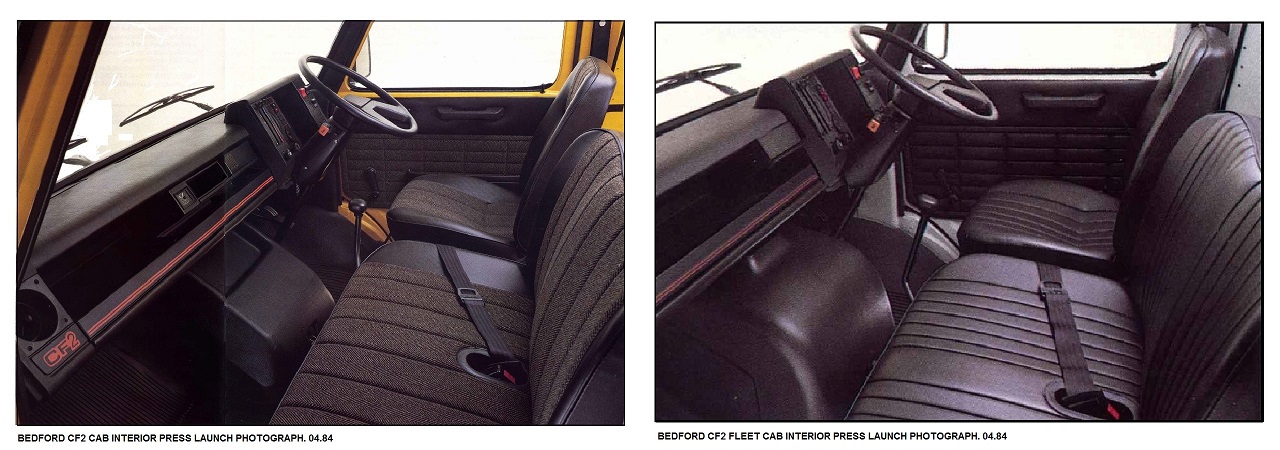
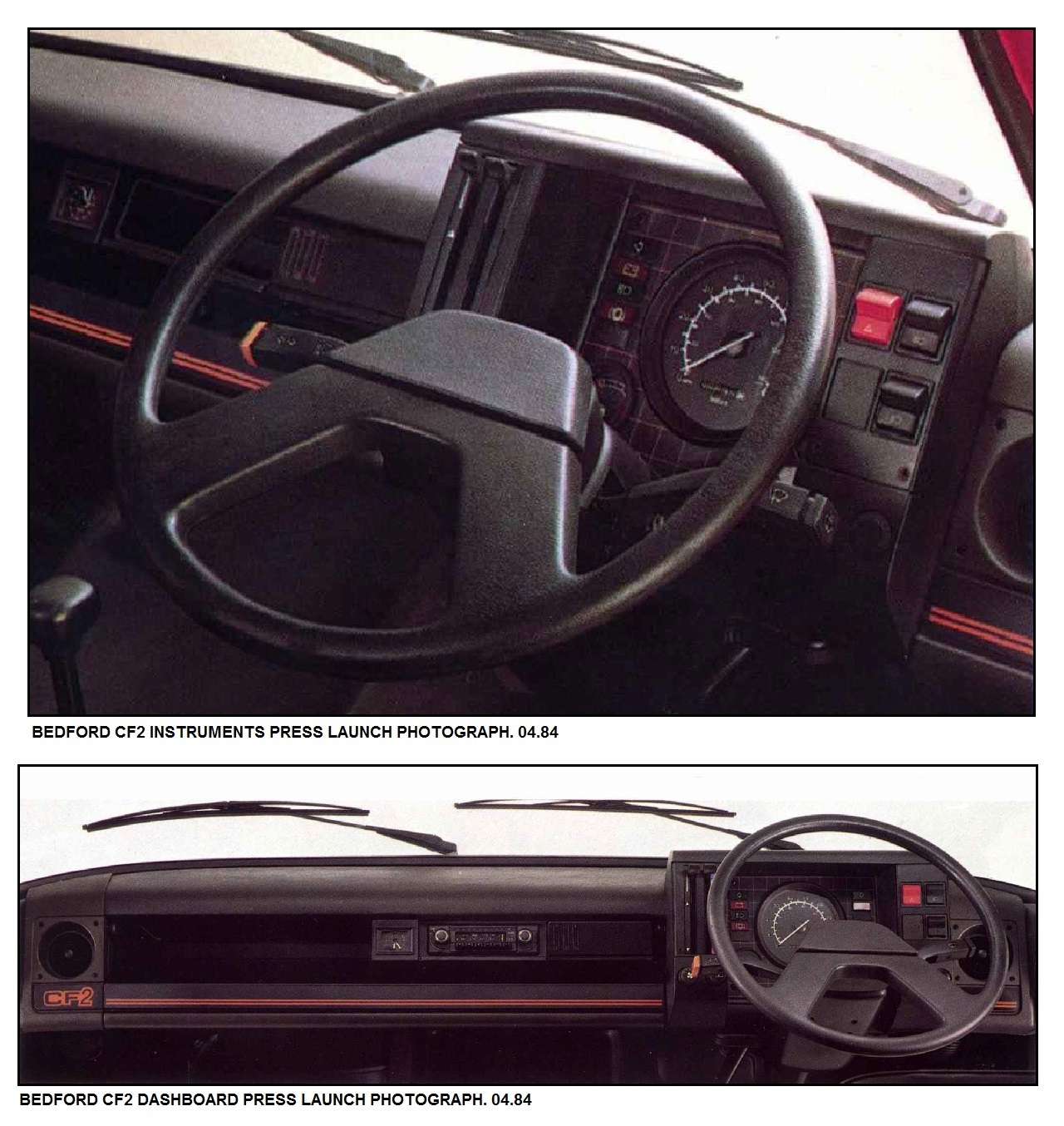
The CF2 remained in production until December 1986 but was
still listed until June 1987 and from 1985 was built and sold side
by side with the Bedford Midi and Bedford Rascal. There was a
planned CG Eurovan, later termed as the "WorldVan", replacement for
launch in 1988 that had been under development since 1982 and dealt
with in a separate section of vauxpedia, but had been delayed due
to lack of spare capital and eventually morphed into a proposed
joint venture with Leyland as a replacement for both the CF2 and
the Sherpa, but the plan was scuppered by the Thatcher Government's
Transport Minister, a brain dead moron, totally over promoted way
beyond his extremely limited capabilities - Michael Channing,
and also screwed up a planned merger between Bedford and Leyland
Trucks - the end result of all this Government meddling in things
it didn’t know anything about whatsoever was that both Bedford
& Leyland disappeared as truck makers and Britain lost the bulk
of its heavy commercial vehicle industry for
good.
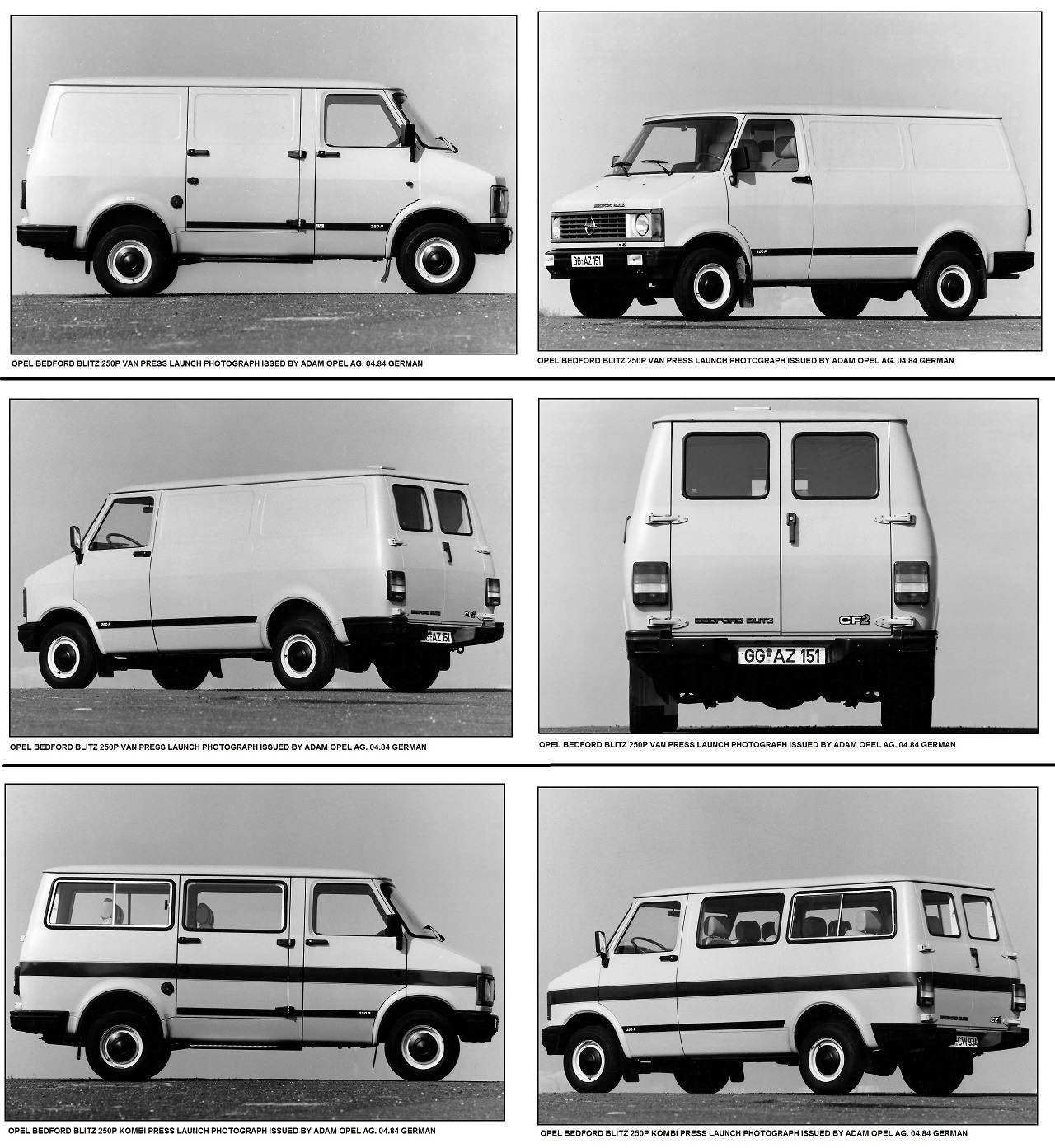
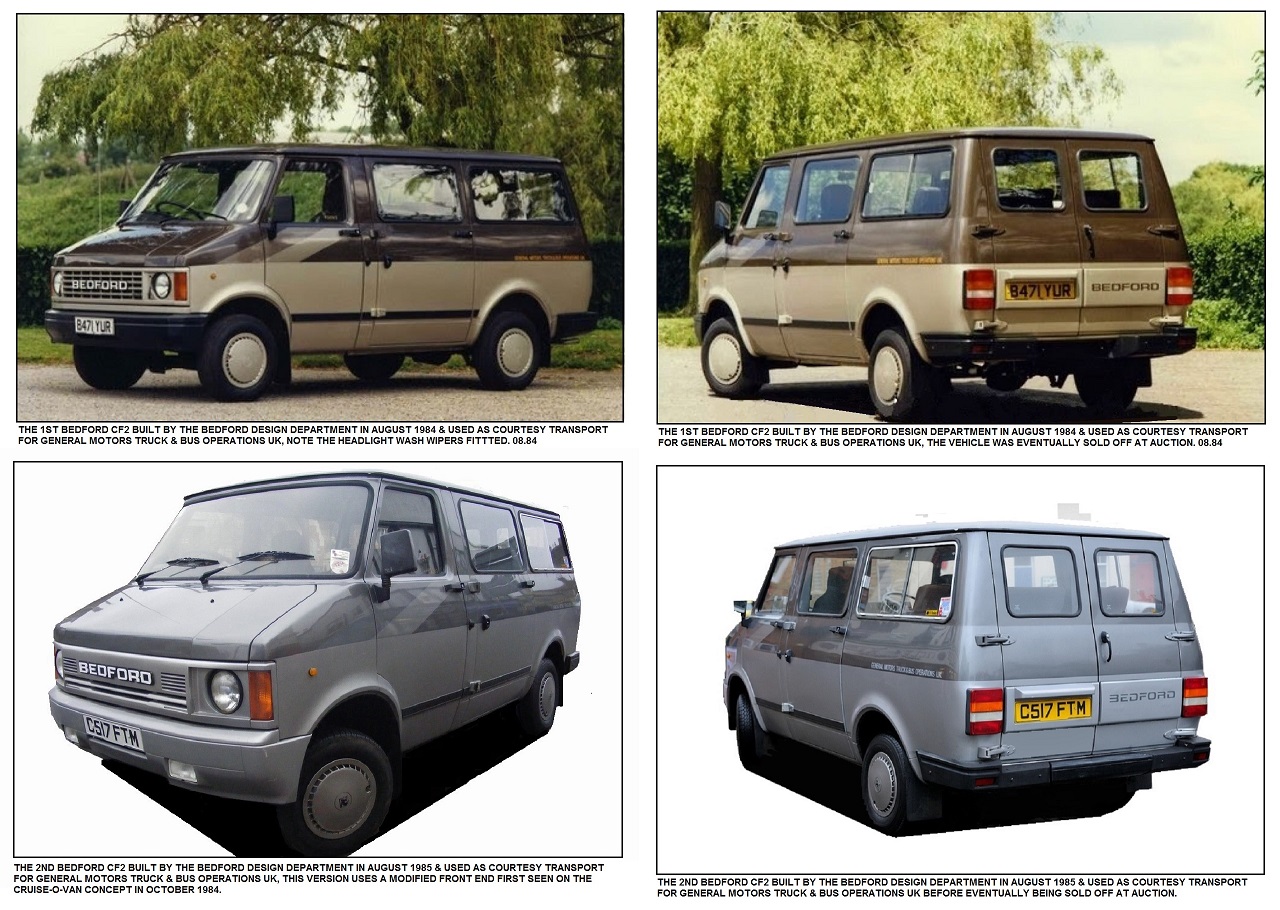
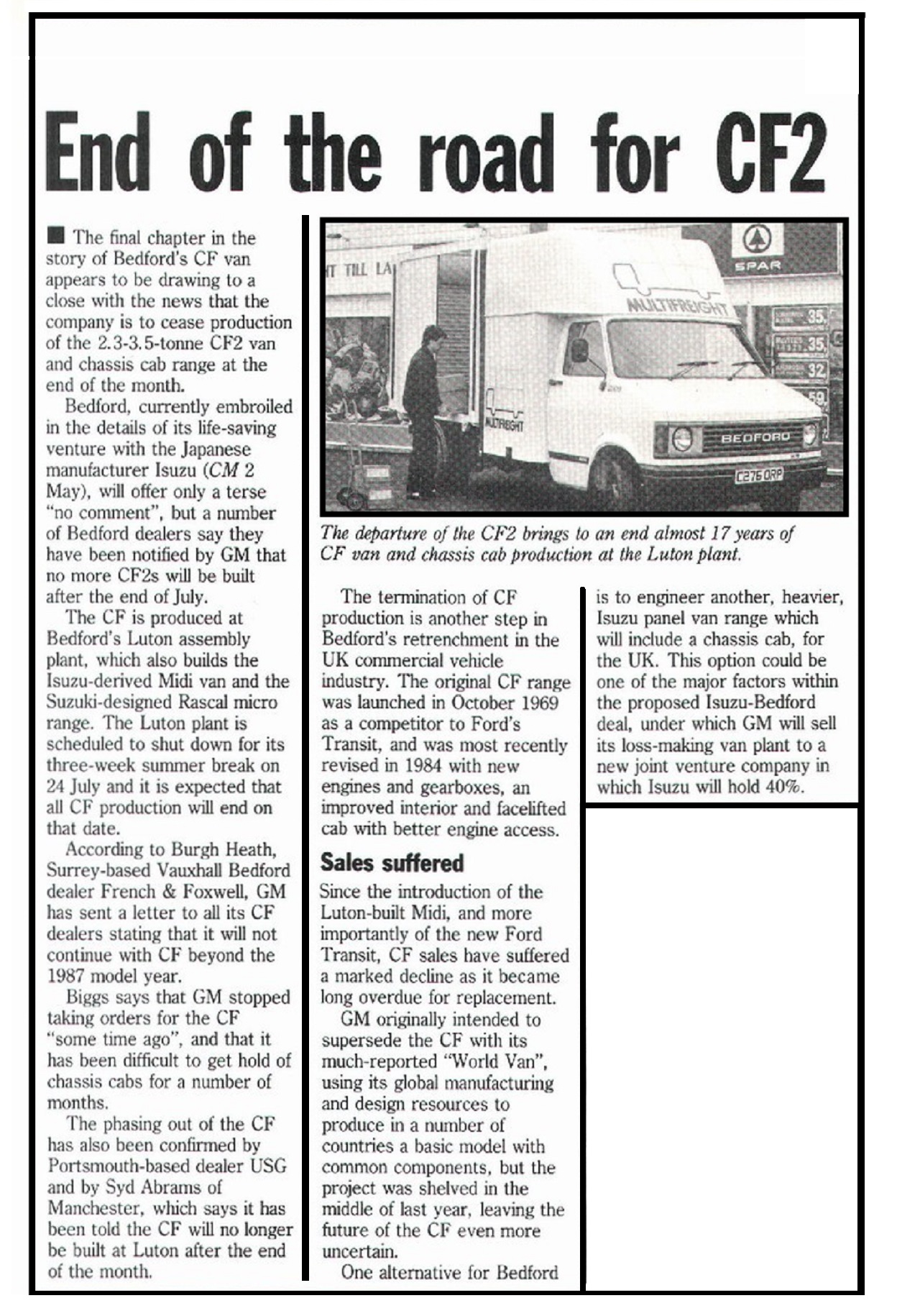
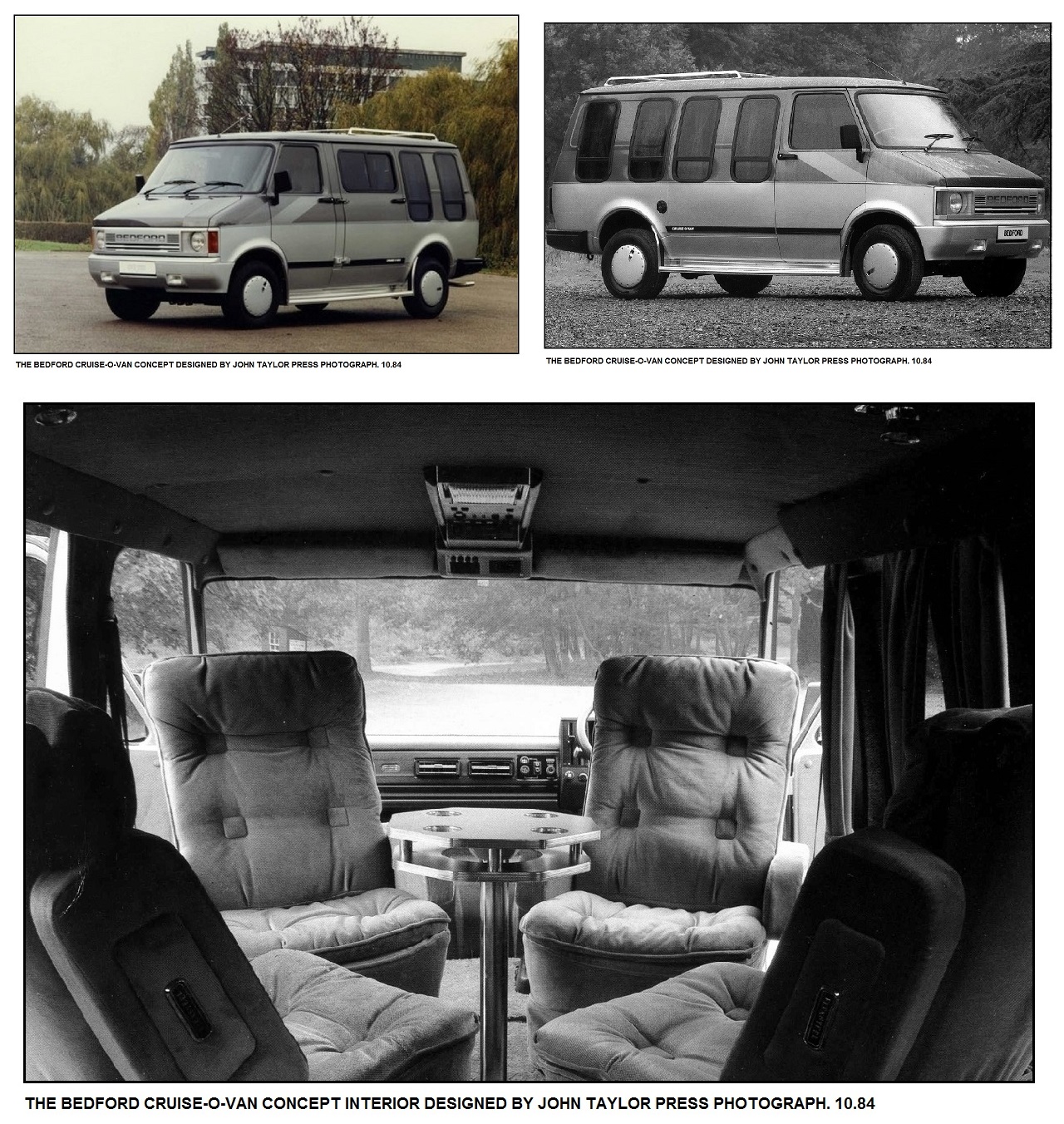
The last change to the CF2 specification came in 1986 when all models were fitted with the ZF 5 Speed overdrive gearbox, the 4 speed Philippines unit was dropped, and as an additional feature the ZF transmission came as standard with provision for a 20hp take off to be fitted. A Bedford CF2 Special Edition was announced in October 1986 and went on sale in December, the van was unmissable and came in two choices of colour; Silver or Metallic Green with contrasting side decals, and a sunroof and radio cassette came as standard.
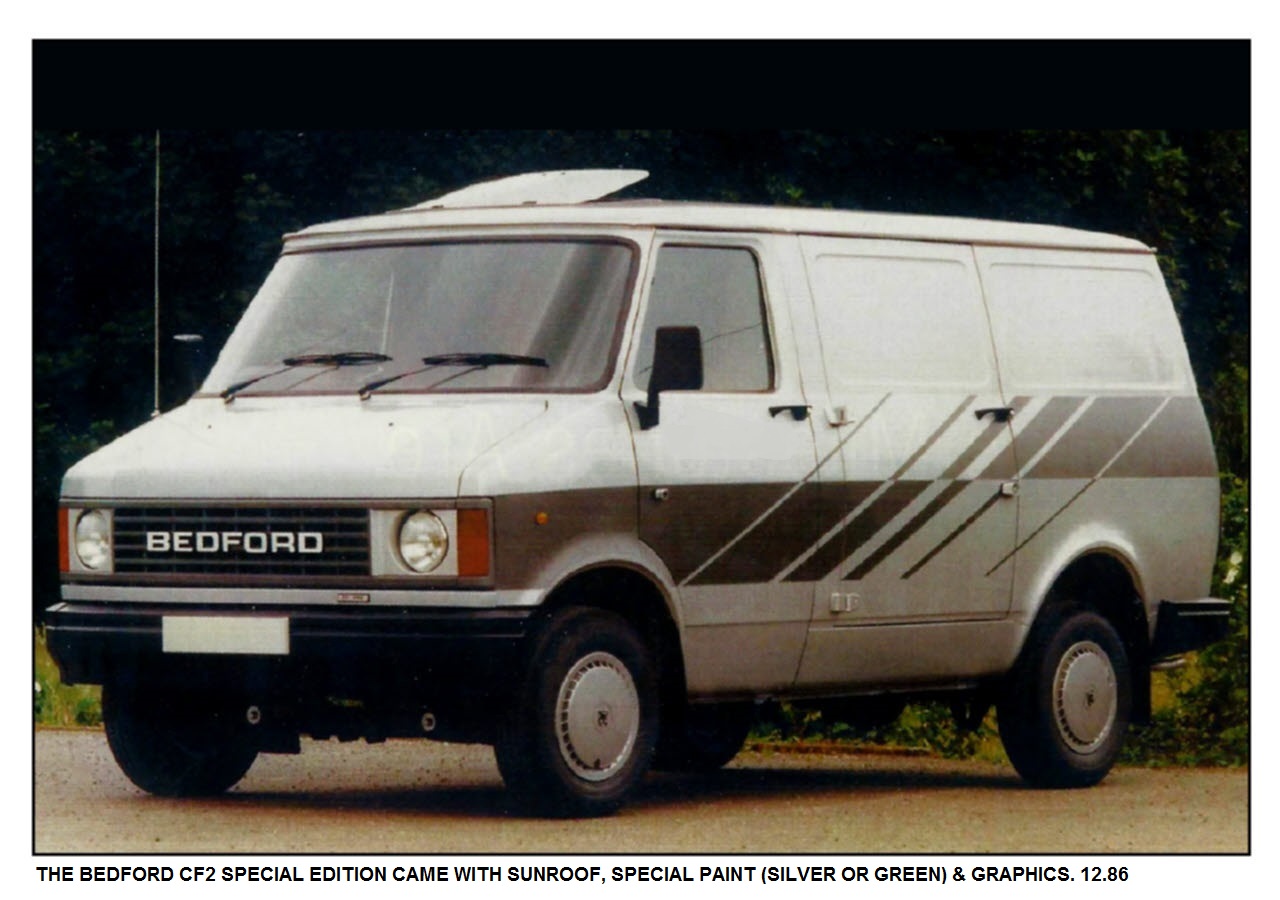
8. BEDFORD 97000 - CF & CF2 SPECIFICATIONS:
